Summer Splash into


PICK A SIDE: TEAM LAKE OR TEAM OCEAN?
GET CRACKING IN RHODE ISLAND’S SEAFOOD CAPITAL
JAWS AT 50: RARE PHOTOS OF THE BIRTH OF A BLOCKBUSTER
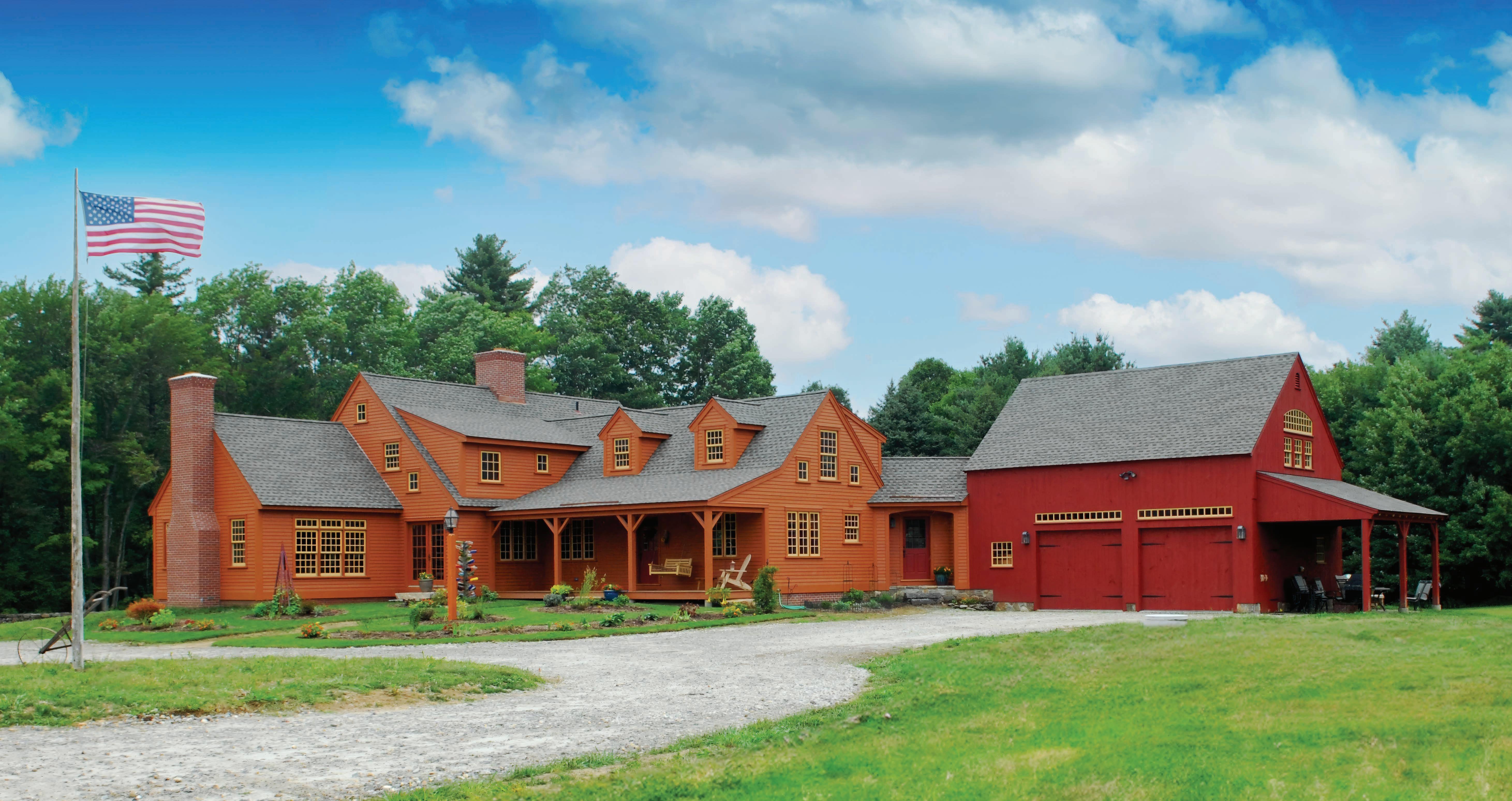



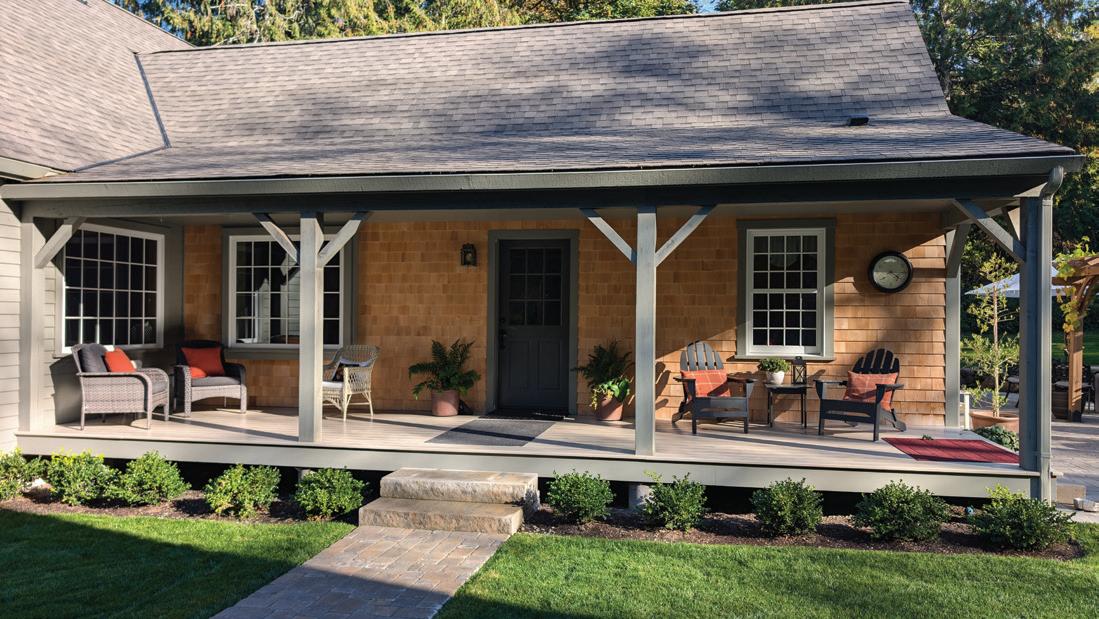












PICK A SIDE: TEAM LAKE OR TEAM OCEAN?
GET CRACKING IN RHODE ISLAND’S SEAFOOD CAPITAL
JAWS AT 50: RARE PHOTOS OF THE BIRTH OF A BLOCKBUSTER














60 /// Testing the Waters
In a region with thousands of lakes and an endless coastline, which should you choose for summer fun: fresh or salt? A New England waterculturist’s guide.
76 /// Dream Machines
At his garage in a small Vermont town, Scott Sargent brings back to life some of the rarest and most valuable cars on the planet. By Meg Lukens Noonan
84 /// Fantastic Voyage
Fifty years after Jaws first sent chills down moviegoers’ spines, a treasure trove of historic behind-the-scenes photographs resurfaces. Photos by Peter Vandermark
92 /// The Call of the Fireflies
An enduring sense of wonder at one of summer’s most fleeting delights. By Susie Spikol
94 /// Second Wind
Stepping aboard a Maine windjammer stirs memories of a childhood long left behind. By Kate Shaffer
A head-turning sight in rural Vermont: vintage-car restoration expert Scott Sargent behind the wheel of a “gentleman’s race car,” a 1926 Bugatti Type 37 Grand Prix. Story, p. 76















From the rich maritime heritage of whaling towns to quaint island villages and grand seaside mansions of the Gilded Age, our small, comfortable ships can take you to the heart of New England’s most treasured destinations. Be welcomed back to your home away from home, where you can delight in the warm camaraderie of fellow guests and crew.



























30 /// True Blue
When July rolls around on Cape Cod, count on hydrangeas to deliver floral fireworks. By Kate Whouley
34 /// Made in New England
This Massachusetts beach chair company has perfected the art of kicking back on the sand—or just about anywhere else the summer takes you. By Kate Whouley

FROM OUR READERS
38 /// Babs Knows Best
How Connecticut home cook Babs Costello became “the Internet’s favorite grandma.” By Amy Traverso
44 /// Weekends in the Kitchen Lobster rolls and blueberry pie get a fresh twist inspired by the new season of our TV show, Weekends with Yankee. By Amy Traverso

50 /// Weekend Away
In Charlestown, Rhode Island, you’ll discover lots of seafood—and some surprising diversions, too. By Kim Knox Beckius
56 /// One-Off Wonders
These curiosities and marvels invite New England road-trippers to make unforgettable detours. By Bill Scheller

The song never remains the same at Rhode Island’s world-famous Newport Folk By Katherine Keenan
The promise of these Vermont-made heirloomquality wooden jigsaw puzzles? To “torment and tease.” By Katrina Farmer
LIFE IN THE KINGDOM
The most essential thing in any homesteader’s tool kit is a willingness to learn, and to try. By Ben Hewitt ADVERTISING RESOURCES As Seen on Weekends with Yankee 42 Best of New England 58
to Do in



June 12–September 14
All roads lead to the Wadsworth.
From natural wonders to the open road, this exhibition explores the rich, complicated, and evolving topic of the landscape in American art.


Your journey to Hartford, CT begins here:


[ COLE HAUSER × THE BARN YARD ]
AUTHENTIC POST & BEAM BARNS










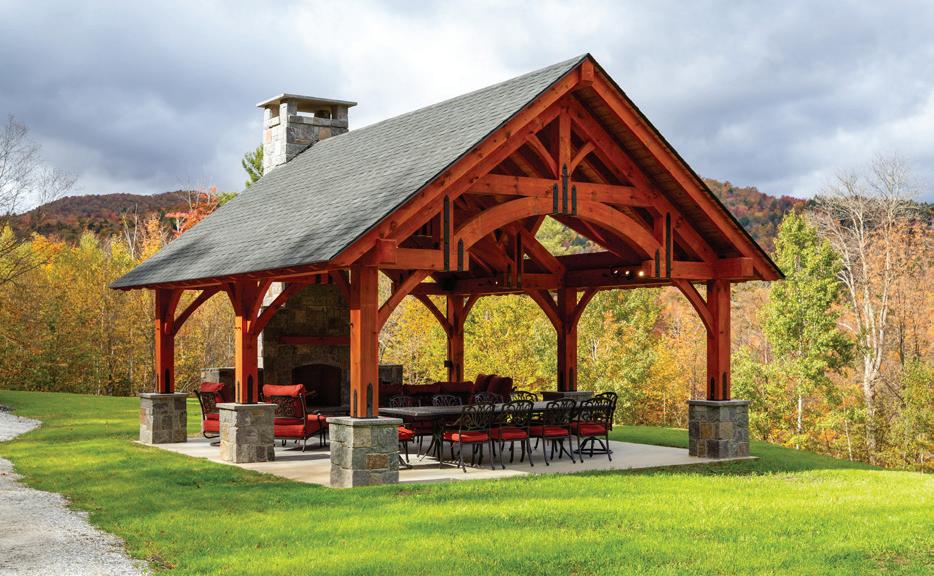



Publisher Brook Holmberg
Senior Managing Editor Jenn Johnson
Executive Editor Ian Aldrich
Senior Food
Editor Amy Traverso
Senior Digital Editor Aimee Tucker
Travel/Branded Content Editor Kim Knox Beckius
Associate Editor Katrina Farmer
Associate Digital Editor Christabel Barry
Contributing Editors Ben Hewitt, Rowan Jacobsen, Nina MacLaughlin, Bill Scheller, Julia Shipley, Kate Whouley
Editor at Large Mel Allen
Art Director Katharine Van Itallie
Senior Photo Editor Heather Marcus
Contributing Photographers Adam DeTour, Megan Haley, Corey Hendrickson, Michael Piazza, Greta Rybus
PRODUCTION
Director David Ziarnowski
Manager Brian Johnson
Senior Artists Jennifer Freeman, Rachel Kipka
Vice President Paul Belliveau Jr.
Senior Designer Amy O’Brien
E-commerce Director Alan Henning
Digital Manager Holly Sanderson
Marketing Specialist Jessica Garcia
Email Marketing Manager Eric Bailey
Customer Retention Marketer Kalibb Vaillencourt
E-commerce Merchandiser Specialist Nicole Melanson
ADVERTISING
Vice President Judson D. Hale Jr.
Media Account Managers Kelly Moores, Dean DeLuca , Steven Hall
Canada Account Manager Cynthia Fleming
Senior Production Coordinator Janet Selle
For advertising rates and information, email jdh@yankeepub.com or go to newengland.com/adinfo.
MARKETING
ADVERTISING
Director Kate Hathaway Weeks
Senior Manager Valerie Lithgow
Marketing Assistant Natalia Rivera
PUBLIC RELATIONS
Roslan & Associates Public Relations LLC
ESTABLISHED 1935 | AN EMPLOYEE-OWNED COMPANY
President Jamie Trowbridge
Vice Presidents Paul Belliveau Jr., Ernesto Burden,
Judson D. Hale Jr., Brook Holmberg, Jennie Meister, Sherin Pierce
Editor Emeritus Judson D. Hale Sr.
CORPORATE STAFF
Vice President, Finance & Administration Jennie Meister
Human Resources Manager Beth Parenteau
Information Manager Gail Bleakley
Assistant Controller Nancy Pfuntner
Accounting Associate Meg Hart-Smith
Accounting Coordinator Meli Ellsworth-Osanya
Executive Assistant Christine Tourgee
Facilities Attendants Ken Durand, Bob Sardinskas
BOARD OF DIRECTORS
Andrew Clurman, Renee Jordan, Joel Toner, Jamie Trowbridge, Cindy Turcot
FOUNDERS
Robb and Beatrix Sagendorph
NEWSSTAND
Vice President Sherin Pierce
NEWSSTAND CONSULTING
Linda Ruth, PSCS Consulting
SUBSCRIPTION SERVICES
To subscribe, give a gift, or change your mailing address, or for any other questions, please contact our customer service department:
Mail: Yankee Magazine Customer Service PO Box 37900, Boone, IA 50037-0900
Online: newengland.com/contact-us
Email: customerservice@yankeemagazine.com
Toll-free: 800-288-4284
Yankee occasionally shares its mailing list with approved advertisers to promote products or services we think our readers will enjoy. If you do not wish to receive these offers, please contact us.


Yankee Publishing Inc., 1121 Main St., PO Box 520, Dublin, NH 03444 / 603-563-8111 / editors@yankeepub.com Printed in the USA at Quad Graphics
Hosts Amy Traverso, Richard Wiese
Directors of Photography Corey Hendrickson, Jan Maliszewski
Editor Travis Marshall
Executive Producer Laurie Donnelly
Senior Producer Mercedes Velgot
Associate Producer Nora Kirrane
Sponsors
Maine Office of Tourism • Massachusetts Office of Travel and Tourism • New Hampshire Division of Travel and Tourism Development • American Cruise Lines • Country Carpenters • Grady-White Boats • New Smyrna Beach Area Visitors Bureau


















At Spruce Peak In Partnership with





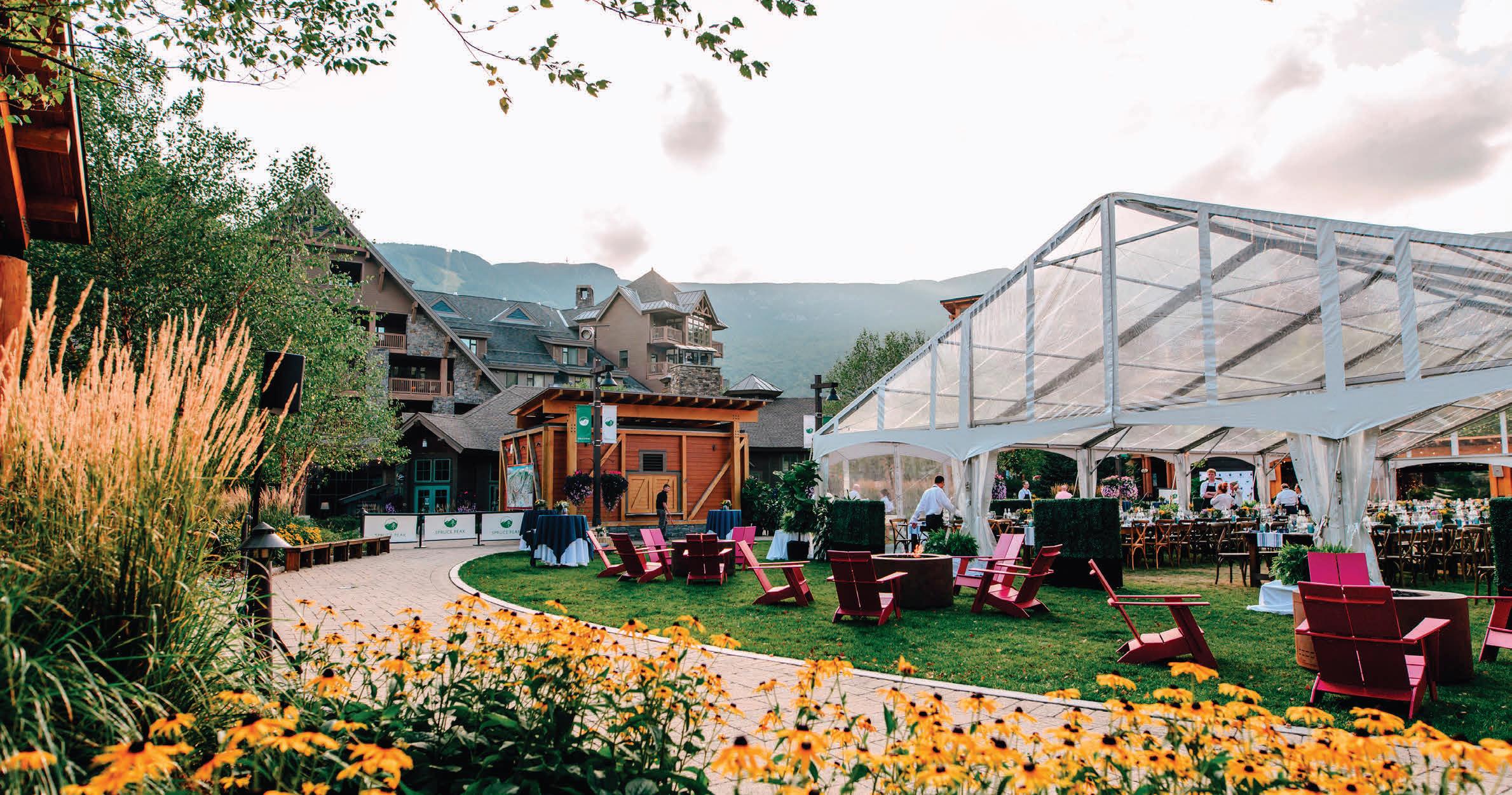
Spruce
welcomes five
This exceptional culinary experience features the exclusive opportunity to meet celebrated guest chefs and enjoy a weekend of amazing food, world-class wines and spirits, camaraderie, and more.
This exceptional culinary experience features the exclusive opportunity to meet celebrated guest chefs and enjoy a weekend of amazing food, world-class wines and spirits, camaraderie, and more.
Thursday, August 14, 2025
Thursday, August 14, 2025
A Taste of Vermont | 6:00pm


A Taste of Vermont | 6:00pm Spruce Peak welcomes some of Vermont’s most celebrated chefs for an unforgettable, locally curated five-course dinner at Tipsy Trout.
Spruce Peak welcomes some of Vermont’s most celebrated chefs for an unforgettable, locally curated five-course dinner at Tipsy Trout.
Featuring Guest Chefs:
Featuring Guest Chefs:
Chef Robert Smith of Starry Night Cafe in Ferrisburgh, VT
Chef Robert Smith of Starry Night Cafe in Ferrisburgh, VT
Chef Cara Tobin of Honey Road & The Grey Jay in Burlington, VT
Chef Cara Tobin of Honey Road & The Grey Jay in Burlington, VT
Chef Justin Dain of Oakes & Evelyn in Montpelier, VT
Chef Justin Dain of Oakes & Evelyn in Montpelier, VT
Friday, August 15, 2025
Friday, August 15, 2025
“First Taste” An Evening with our Star Chefs 5:00-8:00pm


Mix and mingle with our guest chefs while you sample thoughtfully prepared small plates with perfectly paired wine selections.
“First Taste” An Evening with our Star Chefs 5:00-8:00pm Mix and mingle with our guest chefs while you sample thoughtfully prepared small plates with perfectly paired wine selections.
Saturday, August 16, 2025
Saturday, August 16, 2025
Collaboration Dinner
Collaboration Dinner
5:30pm Cocktail Reception | 7:00pm Dinner
5:30pm Cocktail Reception | 7:00pm Dinner


An unforgettable culinary evening awaits you. Enjoy a unique collaborative dinner featuring New Englandsourced and inspired fare from our passionate guest chefs, complete with expert wine pairings for each course by featured winery Domaine Bousquet.
An unforgettable culinary evening awaits you. Enjoy a unique collaborative dinner featuring New Englandsourced and inspired fare from our passionate guest chefs, complete with expert wine pairings for each course by featured winery Domaine Bousquet.
2-Day and 3-Day Ticket Packages and Lodging Also Available
2-Day and 3-Day Ticket Packages and Lodging Also Available
Learn more and buy tickets:
Learn more and buy tickets:
To Friday’s “First Taste” Reception
To Friday’s “First Taste” Reception
Scan the QR code or visit NewEngland.com/TasteNewEnglandGiveaway to enter to win 4 tickets to A Taste of New England’s “First Taste” Reception Friday, August 15th in Stowe, Vermont!
Scan the QR code or visit NewEngland.com/TasteNewEnglandGiveaway to enter to win 4 tickets to A Taste of New England’s “First Taste” Reception Friday, August 15th in Stowe, Vermont!





50 Must-See American Revolution Historic Sites in New England Get a jump-start on America’s 250th birthday celebration by visiting the battlefield parks, preserved homes, and other destinations across this region that bring the nation’s founding to life. newengland.com/revolutionarywar
Best of New England Travel Guide
Get fresh inspiration for your vacation with our editors’ picks for where to eat, where to stay, and what to do in every New England state this summer. newengland.com/bestof2025
A Celebration of Blueberries
These 10 delicious recipes make the most of a signature summer flavor. newengland.com/blueberryrecipes
Want more Yankee? Follow us on Facebook, Instagram, YouTube, and Pinterest: @yankeemagazine
LET’S STAY IN TOUCH!
Sign up for our free New England Today newsletter and get the best of New England travel, food, and living delivered right to your inbox every day: newengland.com/newsletter-signup
NOT FINAL WE WANT TO HEAR FROM YOU!
Tell us what you want more of ... in less than two minutes. Take our survey and receive a special code for a discount in Yankee’s online shop, store.newengland.com . Scan the QR code to get started!



Our hotels range from luxurious and elegant to charming and retro. Witham Family Hotels offers the perfect lodging options for your adventures in Acadia National Park.




















n his farewell letter in the March/April issue, titled “Leaving Home,” Mel Allen described packing up all the odds and ends from his nearly half-century at Yankee that he would take into retirement. (The man has two storage units, and even that may not be enough.)
Some things, though, he has left in the care of those he hired, mentored, and inspired as the longtime editor of this magazine.
To the left of my desk is Mel’s old 8-by-3-foot bulletin board, formerly papered with cards and letters from his fans. Next to it is a framed photo of the Apollo 14 lunar module, signed “To my friends at YANKEE Magazine— regards, Alan Shepard”; the photo was a gift to Mel after he wrote a profile of the New Hampshire–born astronaut. But it’s the bookcase filled with back issues of Yankee that remind me most of what he’s entrusted to this staff.
You likely already know a few of us by what we’ve written, as with executive editor Ian Aldrich’s in-depth

PETER VANDERMARK
In sharing his behind-thescenes photos from the making of Jaws exclusively with Yankee (“Fantastic Voyage,” p. 84), Vandermark returns to a magazine he knows well. As a Massachusetts photojournalist, he shot a number of stories for Yankee in the ’70s and ’80s, including profiles of notable New Englanders such as Tip O’Neill and Julia Child (who even cooked Vandermark an omelet in the kitchen of her Cambridge home).

ERIN MCGINN
Revisiting Charlestown, Rhode Island, for “Weekend Away” (p. 50) was a thrill for this Ocean State–based photographer, whose work has been published by The New York Times and Harper’s Bazaar, among others. “While attending URI,” she recalls, “there wasn’t a summer day when my friends and I weren’t at Blue Shutters Beach, grabbing a Tropic Frost ice cream on the way home or shopping at The Fantastic Umbrella Factory!”
feature reporting and travel editor Kim Knox Beckius’s lively dispatches from across New England. You may even know our faces: On a recent trip to Florida, senior food editor Amy Traverso was stopped by some fans of our public television show, Weekends with Yankee, which she cohosts.
Yankee ’s editors will take turns writing this letter knowing that while Mel may have cleaned out his office, the things he truly valued are still here with us, every day. The connection with readers. The commitment to storytelling. The celebration of New England. Whether in print or online (or even, yes, on TV), this is our foundation, and in every issue we’ll share how we are building on it for the future.
Tell us how we’re doing by dropping a line to editors@ yankeepub.com. Cards and letters are welcome, too— after all, there’s an awfully big bulletin board here to fill.
—Jenn Johnson, senior managing editor

KATE SHAFFER
A master chocolatier, author of three cookbooks, and occasional freelance writer, Shaffer discovered that spending five days aboard a Maine windjammer (“Second Wind,” p. 94) conjured up the feeling of a wholly different life, “one of a free-spirited woman who ran away to spend her life at sea.” Adds the Portland resident, “If that’s not the best vacation ever, I don’t know what is.”

STEVE JERMANOK
Jermanok was back on familiar turf—or rather, sand—for this issue’s roundup of top lake and ocean destinations (“Liquid Assets,” p. 66): The 40-odd stories he’s written for Yankee include a splashy cover feature on New England’s 25 best beach towns. A globetrotting travel writer, blogger, and cofounder of a boutique travel agency, Jermanok makes his home in Massachusetts with his wife, son, and mini goldendoodle, Theo.


The Baldwin started with a bold vision for what senior living can and should be. Innovative. Forward-thinking. And designed to empower successful aging. In 2019, that vision was recognized by The American Institute of Architects’ (AIA) Design for Aging Review with an Award of Special Recognition in the “unbuilt projects” category.
Our thanks to the entire team at DiMella Shaffer for turning our vision into reality. An award-winning vision


The Baldwin vision has now become a vibrant community where residents are connecting, learning, growing, and living well — on their own terms. And The Baldwin has just received a prestigious AIA Design for Aging Review award in the “built projects” category for demonstrating innovative design solutions that improve the quality of life for older adults.




In announcing his retirement from Yankee earlier this year, longtime editor Mel Allen also retired the only email address he’s ever had—his work email—and launched his own account, inviting readers to connect with him at melallen716@gmail.com. His inbox (and ours) has been overflowing ever since. You can find more letters to Mel on our website: newengland.com/dearmel
I just opened the March/April issue and, as always, I read your message first—and I am sad. You have helped take me to New England places I would otherwise never had known about or had a chance to see. I know Yankee will go on, but your touch on it has been like Linus’s blanket for me. Thank you again for all you have done. May your work on your collection of stories be everything you want it to be.
Bill Sullivan, Massachusetts
Like so many thousands of Yankee readers, I was stunned by your decision to retire. Again like so many others, I’d become addicted to seeing your smiling face as you leaned against a doorway in that beautiful red shirt. The problem with not updating that photo every couple of years is that we readers start thinking that you are immortal, that you will always be there, that things will stay the same. But I wouldn’t have wanted it any other way—we just became spoiled by your continued presence and wanted it to last forever.
Chris Bell, Michigan
Thanks for being a devoted, happy, thoughtful, appreciative, serene, and philosophically grounded presence in my life through the Yankee issues that have provided me New England oxygen since my time arriving here in Southern California 10 years ago. Your words, and the words of all of Yankee ’s contributors and staff, allow for the smell of fresh autumn leaf litter to permeate this Mediterranean climate. Thanks—I wanted you to know
that your work mattered to me greatly. Enjoy the lobsters and McIntosh apples in your retirement.

I have only been to New England three or four times, but I have traveled there many more times in words and photos thanks to your careful leadership of Yankee through the decades. I owe you a debt of gratitude for the cherished parts of New England that warmly reside in this Texan’s heart.
Dan K. Utley, Texas
When I read your article about leaving Yankee, I said out loud, “Ohhhh!” and felt sad, like a good friend was moving away…. I just wanted to let you know that someone in Connecticut had the initial reaction of an actual stranger feeling like a friend.
Debra O’Connor, Connecticut
I have never in my life responded to any article until seeing your editor’s letter in the January/February issue, and reading what Jud Hale impressed upon you about needing to make readers feel. When I visited New England for the
first time many years ago, I saw my first issue of Yankee in the lobby of the hotel where I was staying. I sat there and read the magazine, cover to cover, and when finished I decided to subscribe to the magazine. For years I loved visiting, walking, and hiking in New England; up until 2020, my husband and I traveled there every fall. Thank you, Yankee, and New England for all the joy you have brought into my life.
Donna Watson, North Carolina
Congratulations on your retirement and, mostly, thank you. Yankee always brings me back to myself no matter how far away I always seem to get. Love the last issue, and keep the red shirt!
John Kelly, Massachusetts
There truly is something indescribable about the feeling I get every time a new issue of Yankee hits my mailbox. (Ask my wife—she’s seen my childlike glee at its arrival on more than one occasion.) By now, I have a system down whereby I aim to finish up one issue just as the next one arrives. In service of this goal I find that reading every last word, including every last ad and every last writer’s bio, helps. Anything to avoid that dreaded “I’m finished with my Yankee ” feeling....
Your editor’s letter will be sorely missed, but I consider myself fortunate to have read it all these years. Best wishes for a wonderful, well-deserved retirement.
Jeff Powell, Rhode Island
A new collection of Mel Allen’s writing, Here in New England: Unforgettable Stories of People, Places, and Memories That Connect Us All, will be published this August by Earth Sky & Water LLC. The book is available by advance order from the publisher (earthskywater.net) as well as from Yankee’s online store (store.newengland.com).
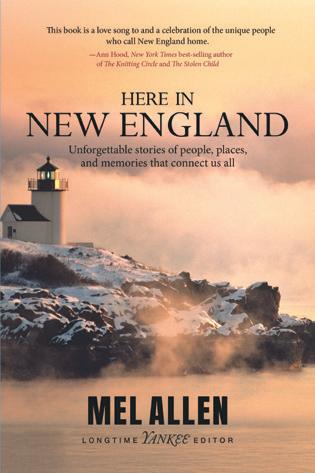


Charming seaside villages and soft, sandy beaches. Waterfront lobster shacks and artisanal ice cream shops. Some vacations never leave us: recalled often, savored always. This summer, add some new stories to your family lore. Make them happen here.


VisitMaine.com





Rugged coastlines, sandy beaches, majestic mountains, endless trails and serene lakes ignite the senses, inviting you to explore, adventure and be transformed by its natural escapes.
Discover Maine’s charming coastal villages and mountain towns, where independent shops, craft breweries and seasonally inspired restaurants with local ingredients harvested from land and sea welcome you to share the local spirit.
Maine offers an appreciation for life’s simple moments. Time seems to move differently here. It eases. Stretches out. Gives you space to breathe.
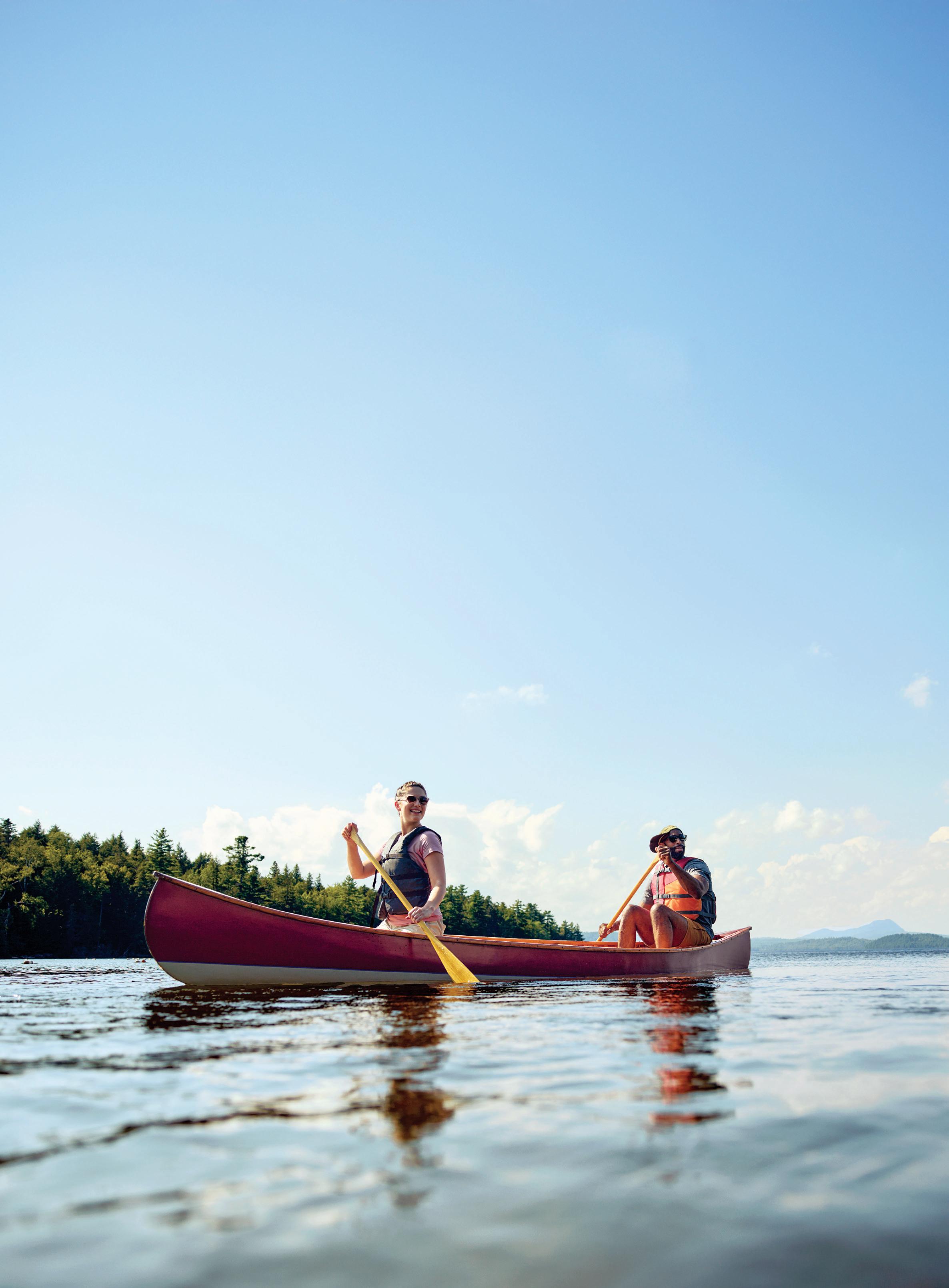
Sun-drenched days at the beach and leisurely lake days set the pace of summer in Maine. Being on the water is a hallmark of the season. Sail on an authentic windjammer or go on a deep-sea fishing excursion. Paddle a canoe across quiet lakes or rush down the river on thrilling whitewater rapids. And then there’s hiking, biking, fishing and camping.
The flavors of summer are bright and bountiful. This is the season for wild blueberries, small-batch ice cream, jovial clam bakes and lobster rolls enjoyed by the waterfront. Peruse bustling farmers markets, small-town main streets and open maker studios. Choose from a plethora of unique places to lay your head at the end of a deliciously long vacation day.





Maine’s regions call you to experience new perspectives.
AROOSTOOK COUNTY
Home to the magnificent Aroostook River, the Allagash Wilderness Waterway and cold, deep lakes, this northernmost region of Maine o ers rugged outdoor adventures and a fishing season that never ends.
THE MAINE HIGHLANDS
In the center of Maine, this region boasts the legendary Mount Katahdin, stunning Moosehead Lake and the great city of Bangor — plus 200 waterfalls and your best chance of spo ing moose in the wild.
MAINE LAKES AND MOUNTAINS
Hundreds of glacial lakes, two mountain ranges and seven of Maine’s highest peaks come together for four seasons of natural beauty and outdoor recreation. Drive one of the scenic byways to take it all in.
MIDCOAST & ISLANDS
Where the mainland meets the ocean, discover seaside villages bustling with soaring lighthouses, iconic lobster shacks, farm-totable eateries, historical theaters, maritime museums and art studios and galleries.
GREATER PORTLAND & CASCO BAY
Cobblestone streets lined with lively bars and eateries beckon in Portland, the “foodiest small town in America.” This region is also home to the world-famous L.L.Bean Flagship Store, historical lighthouses, working waterfronts and cultural enclaves.
THE MAINE BEACHES
Sandy beaches, picturesque piers, serene golf courses and rollicking amusements parks make this region a hit for all ages. Explore the water with a guided tour, from deep-sea fishing and lobstering to sailing and surfing.
THE KENNEBEC VALLEY
Spectacular natural beauty is the draw, as adventurers can go hiking on the Appalachian Trail and whitewater ra ing and trout fishing on the Kennebec River. Stroll picturesque, walkable streets in Augusta, Skowhegan, Gardiner and Waterville.
DOWNEAST & ACADIA
Scenic byways, coastal hiking trails, idyllic island towns and seasonal displays of foliage and flowers ignite the senses. Acadia National Park on Mount Desert Island o ers even more dramatic landscapes and diverse wildlife.
LEARN MORE AT VISITMAINE.COM



The song never remains the same at Rhode Island’s famous folk festival.
STORY
AND PHOTOS BY KATHERINE KEENAN
t was the kind of summer evening you dream about all year. A few thousand of us stood together, our faces tilted toward the stage and the faded-denim blue of Rhode Island’s Newport Harbor at our backs. It had been a hot, marathon day of music, and we were finally at the cooldown: the final set on the second day of the Newport Folk Festival. Some in the audience began to pack their bags. Some even began to leave. But moments later, Gillian Welch and David Rawlings began to play, and, remarkably, the river of people slowed. I watched Rawlings’s fingers move, unhurried, the sunset gilding the hull of his guitar, and took a long, deep breath. I had, in fact, been dreaming about this all year.
Like many of the artists who regularly play Newport Folk, Welch and Rawlings are some of my favorites. Partners in both life and music, they sing timeless, sorrowful songs with lyrics that unfurl slowly, rewarding those who are patient enough to stick around. In many ways, the festival does the same. Newport Folk retains a slowness in a time when digital immediacy has become the norm. Most people who attend buy their tickets in the winter, months before the festival lineup is even announced—and in typical Newport fashion, several lineup slots simply read “TBA” right up until the moment the artist walks onstage.
“You might not know a single person on that lineup, but you go,” says Sophie Gee, a 30-something who has been attending the festival with her dad for the past decade. “I’ve found there’s been years where I don’t know anyone playing, and I’ve left finding bands that I’ve now traveled the world for.”
Newport Folk unfolds each July over the course of three days, on a small peninsula shaped like a hitchhiker’s thumb, four miles from downtown Newport by road and roughly one mile by water. Sprawled across the grounds of Fort Adams, a retired army base turned state park, the festival welcomes some 10,000 attendees each day to see a lineup of more than 50 musicians play its five stages. It’s not the

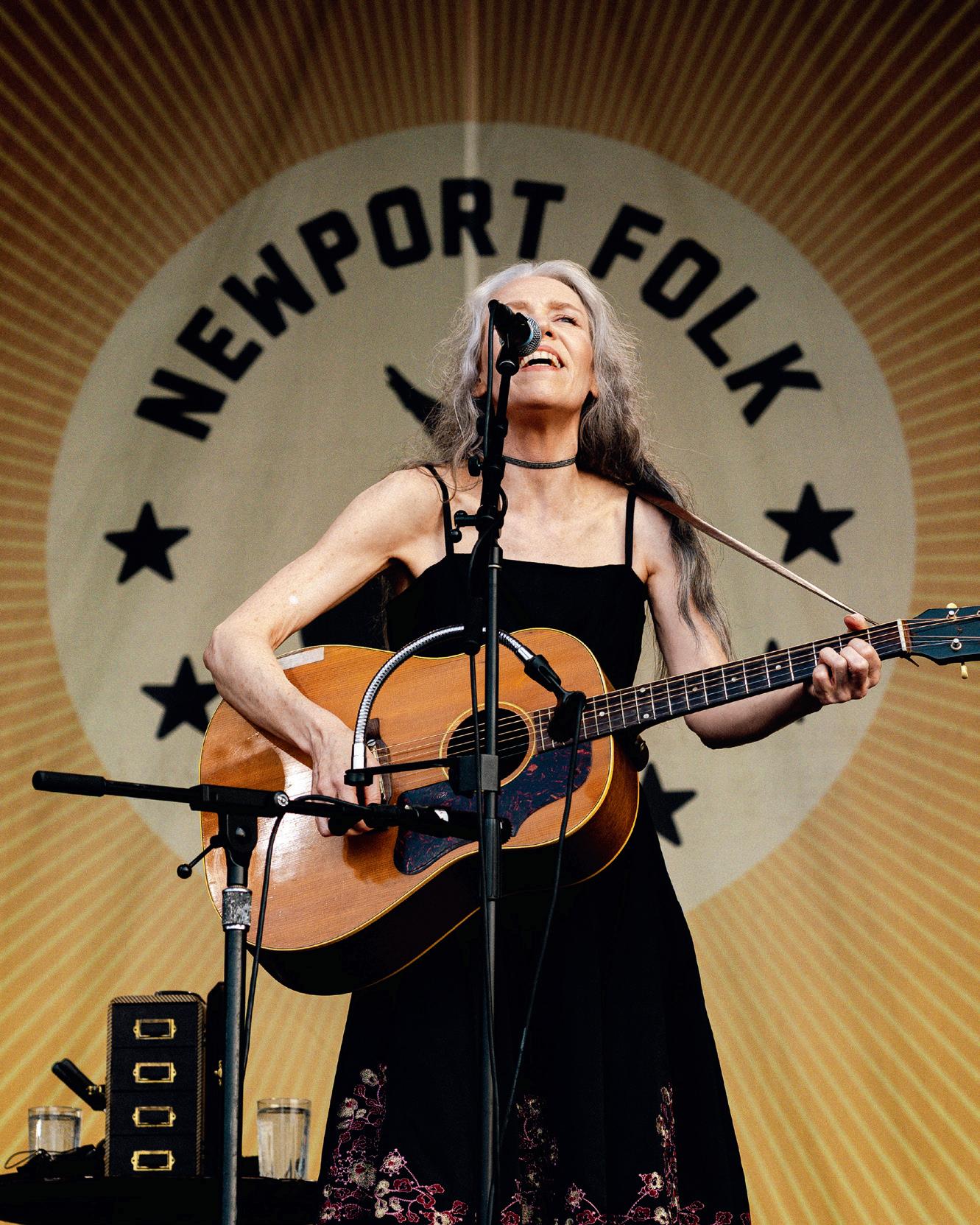
country’s biggest folk festival, but it is arguably the most important.
Whether George Wein had such grandiose dreams when he cofounded the festival in 1959 is uncertain. But Wein, a pianist and producer from Massachusetts who had debuted the Newport Jazz Festival five years earlier, did have a sense for the moment. His modest event arrived at the dawn of a new age in folk music, and it certainly played a major role in its rebirth. While forever linked with Bob Dylan’s electric makeover in 1965, Newport Folk also became an important venue for emerging artists to introduce themselves to the wider public. Many now-legendary names made their festival debut at Newport: Joan Baez, James Taylor, Kris Kristofferson, and
from top: Among last year’s headliners was singer-songwriter Gillian Welch, who took to the main stage with her musical partner, David Rawlings; the “Late Greats” signpost, honoring legendary past performers at Newport Folk.
Alison Krauss, to name a few.
My own introduction to the festival had come by boat.
As our ferry splashed through the bay on Friday, the first day of the festival, we passed hundreds of other boats purposely moored within earshot of the festival, coolers stocked and motors off. Anticipation swirled across the harbor. Soon, the sun would begin to warm the day, and the music would start to play.
By noon, the grass at Fort Adams had all but disappeared beneath picnic blankets and lawn chairs. Hat brims of all hues, sizes, and materials overlapped in front of me like a sheet of rainbow sequins. Delicious steam rose from the food carts at my back, and the harbor stretched into the distance.
Because of Newport’s multiple stages, the weekend involves a fair bit of logistical planning—and walking. One minute I was singing along to Muna at the Quad Stage, and the next I was hurrying to catch Black Pumas at the Fort Stage. I fretted over which Adrianne Lenker songs I might miss during Hozier’s set, and I had no clue how to handle the overlap of Orville Peck and The War on Drugs. But rather than moping about what I missed while stuck in foot traffic, I, alongside thousands of other dusty festival folks, caught the songs I could.
This is the laissez-faire attitude in the wind at Newport Folk. Sure, some are angling for the big fish, banking on a surprise set from James Taylor. But most are simply happy to be here. Even the musicians, who have private areas for watching the sets, often roam the fort grounds and join the audience.
Which is to say: Newport isn’t your typical music festival. First of all,

A romantic, adults-only hideaway with serious charm. Wake to a complimentary breakfast, stroll quiet garden paths, and explore Vermont’s Northeast Kingdom. In the evening, enjoy a candlelit meal at 24 Carrot, then wind down with a creative cocktail at the cozy Snooty Fox Pub.

A classic, white-clapboard retreat that feels like summer in full bloom. Hike to waterfalls, ride the Conway Scenic Railroad, or relax at the Aveda Spa. Come evening, sip something seasonal at The Mistletoe Pub before dinner at 3North Restaurant.
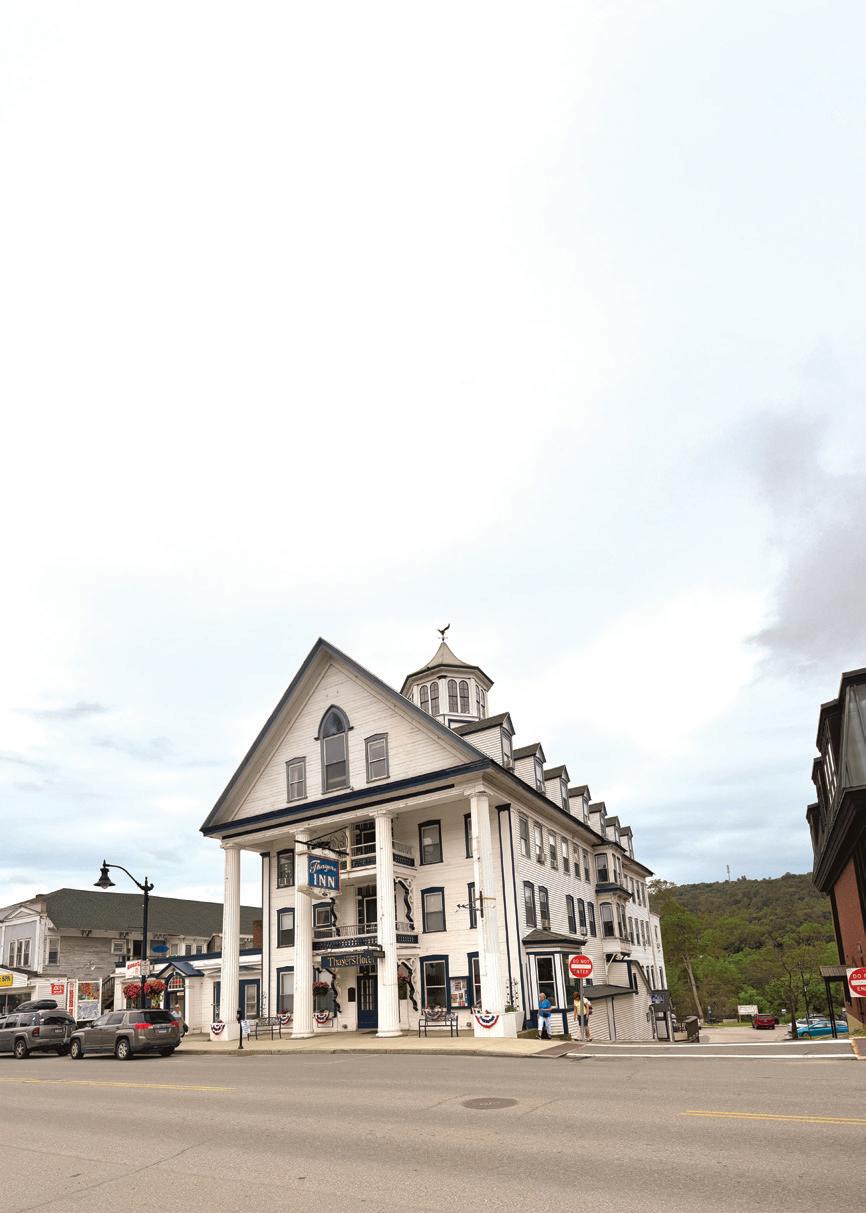
historic stays with a story. Wander riverside trails, explore the town’s one-of-a-kind shops, and end the day with small plates and drinks at the inn’s own Sour’s Taverna.
Stay at any of our three sister inns in Jackson, New Hampshire, and unlock access to all. A complimentary shuttle connects guests to pools, restaurants, spas, and outdoor adventures across the properties.

An upscale, adults-only retreat with sweeping mountain views and standout dining. Savor regional cuisine at Forty at Thorn Hill, then head downstairs to Forty Below—a moody, stone-walled wine cellar—for an unforgettable nightcap.

paddling, or taking in mountain views. When the sun sets, head to the 1840s-era Shovel Handle Pub for hearty fare, cold drinks, and live music in a setting that feels like summer camp for the whole family.



there’s no festival campground. At 8 p.m. every day the crowd goes home to real beds and—more important— real showers. Second, at Newport the drinking is confined to set zones which, notably, are nowhere close to the stages. These “splash-free” areas
are clear of abandoned cups or the rowdiness of a concert pit. For most, seeing Taj Mahal up close is worth leaving their beer behind.
At the end of the day, it’s really all about the music—even for those without tickets. During Hermanos Gutiérrez’s set on Saturday, I spotted a crew of sopping-wet teenagers listening from the other side of the chainlink fence. Behind them, on the rocky shore, sat their fleet of inner tubes.
That evening, Gillian Welch crooned the lyrics to her music-industry elegy, “Everything Is Free,” singing “We’re gonna do it anyway, even if it doesn’t pay,” as the sun—now a soft, orange orb—slid down the sky. For a few moments, nobody made surpriseguest predictions or checked the upcoming schedule. The boats bobbed in the harbor and our heads moved to the sound, which seemed to carry not only across the field of hats and vessels, but all the way out into the saltwater of the vast Atlantic.


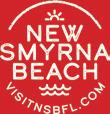


The promise of these Vermont-made heirloom-quality wooden jigsaw puzzles? To “torment and tease.”
Back in 1974, a pair of entrepreneurs named Steve Richardson and Dave Tibbetts founded a game company after being commissioned by a wealthy Bostonian to create a custom wooden jigsaw puzzle for his wife. They named their Vermont-based company Stave—a combination of their first names—with Richardson assuming the unofficial title of “chief tormentor.”
Small New Yorker ads and new customers soon followed, and since then Stave puzzles have made their way to tables in 50 states and 15 different countries.
What makes them so coveted? For starters, none are the same. A dozen makers individually handcraft the cherry-backed puzzles at Stave’s Norwich headquarters. The smallest might require a day to make, while larger editions can take two or more weeks. Edges are typically rounded or scalloped—not straight. The pieces may fit together in multiple combinations, but there’s only one correct placement. Adding to the difficulty, the puzzles come with no reference pictures.
Run today by Paula Tardie and Jennifer Lennox—two longtime employees who bought the company in 2016—
Stave has been dubbed by Smithsonian as the “Rolls-Royce of puzzles,” as its wildly challenging creations come with wildly expensive price tags. Custom editions hover around $10,000, while in-stock options currently range from $325 to $7,995. In 1992, a limited-edition eightfoot-long puzzle sold for $8,680 ($21,000 in today’s dollars), earning a Guinness World Record as the world’s most expensive puzzle.
The numbers haven’t deterred Stave’s clientele, including repeat customer Bill Gates and the late Queen Elizabeth II, who liked to give Stave puzzles as gifts. Other fans boast the last names Bush, DuPont, Mellon, and Rockefeller, to mention a few.
Stave’s designs even allow for personalization—names, birth dates, a silhouette of a beloved pet, for example. But one element unites all Stave puzzles: the inclusion of its clown mascot, a single piece that may or may not fit, celebrating the company’s enduringly playful spirit. —Katrina Farmer





When July rolls around, count on hydrangeas to deliver floral fireworks.
BY KATE WHOULEY


wish I could take these home with me,” a friend declares, pointing to the two hydrangeas that form the backbone of the mostly-shade section of the front garden at my home on Cape Cod, Massachusetts. During the first week of July, the huge mophead blooms are a brilliant cornflower blue. These particular plants have been in this spot for roughly 40 years, and it’s not the first time I’ve heard this refrain from someone who lives, as we say, “off-
Cape.” Hydrangeas thrive in maritime climates with more temperate winters, sandy soil, and gentle summer sea breezes that produce lingering humidity—or at least the vintage varieties do. But here’s the good news for all New Englanders: The ever-growing popularity of this woody ornamental has led to an explosion of varieties that are hardy in cooler and inland climes.
“The major breeders are focused on producing hydrangeas that will thrive almost anywhere,” says longtime Cape-based garden educator and author C.L. Fornari, who hosts the weekly call-in local-radio program The Garden Lady. “In fact, you can’t even purchase some of the older varieties we have on the Cape.”
Many of those old favorites as well as some of the newer hybrids you’re
likely to find at your local garden center—Strawberry Sundae, Endless Summer, and Let’s Dance, to name a few—anchor Fornari’s expansive gardens at her home in Sandwich. In all, she estimates there are as many as 50 hydrangeas on her property, many sent to her to try out (an occupational perk, for sure). Fornari speaks botanical, but she translates into common names as she leads me around her yard. I’m intrigued by the range of different settings for her hydrangeas: standing sentinel at the end of the
driveway, hugging the house, tucked in by an arbor, nestled alongside perennials. I’m also feeling just a little special to be given a private tour by The Garden Lady herself.
Contributing to The Garden Lady’s renown is Fornari’s role in the cofounding of the Cape Cod Hydrangea Festival. The event, which is coordinated by the Cape Cod Chamber of Commerce and is now in its 11th year, supports the important work of many nonprofit organizations while offering attendees self-guided

tours of about 100 private gardens, including Fornari’s, at the peak of hydrangea season in mid-July.
This year’s Cape Cod Hydrangea Festival runs July 11–20. Tickets for self-guided tours are $5 per person, per garden. For more information, go to: capecodchamber.org/events/ cape-cod-hydrangea-fest
“Each garden is partnered with a local nonprofit and passes all the proceeds to them,” says Greta Georgieva, the chamber’s special projects coordinator. “We get visitors from around the world, and I want them to know they will see more than hydrangeas here,” she adds. “Of course we celebrate Cape Cod’s iconic flower, but the festival is truly a summer garden celebration.”
In addition to the satisfying walks through usually private gardens, the festival includes workshops, special promotions at local nurseries, and even
plein air painting demonstrations. For gardeners in search of higher learning, there’s also Hydrangea University, a half-day symposium sponsored by the Cape Cod Hydrangea Society and Heritage Museum & Gardens in Sandwich, home to the North American Hydrangea Test Garden.
“The concept for the test garden came out of a conference we held here in 2015,” says Heritage’s hydrangea curator, Mal Condon, whose work with the flower spans roughly half a century. “Hydrangeas were getting really popular with gardeners, and hybridizers had jumped in big-time. In the test garden, we can evaluate new varieties in a real-life setting.”
Those newer cultivars occupy nearly three acres, allowing horticulturists to study and report on their health and viability. Home gardeners and hydrangea lovers, meanwhile, can stroll the cobble-lined shell paths to take in the colors and blooms, and perhaps do a little garden planning of their own.
The older varieties have their home in the neighboring two-acre Hydrangea Display Garden, a showcase of nearly 155 species and cultivars. “It’s really a historical collection,” Condon says, mentioning that at least 60 percent of the plants are no longer in cultivation or propagation. “The first plantings were installed in 2008. The idea was to establish a garden that contained the older antique varieties, especially the species macrophylla —that’s the one everyone loves—the blues.”
Ah yes, the blues. Maybe it’s because there’s not a lot of that color in any given garden, but what I especially love about my sprawling specimens is watching the hues change— from the palest, white-tinged blue when the buds first open, to the soft robin’s-egg blue of peak bloom.
I learned from my time with Fornari and Condon that it’s not merely the natural acidity of the soil that creates the depth of the blues on Cape
“Hydrangeas are the absolute easiest plants to grow,” says home gardener and Instagrammer Dana Paradis of Eastham. The 70-plus specimens surrounding her c. 1775 home also bloom each summer on her Instagram feed (@thisoldcapehouse), where she posts handy videos about care and pruning. If you’re new to the hydrangea craze, here are some tips from Paradis on selecting and caring for hydrangeas.
1. KNOW YOUR ZONE: This is critical to selecting a variety that will thrive in your area. It’s generally best to mix “old wood” and “new wood” (or “next generation”) blooming varieties, in case of a cold snap that will kill the buds. (Endless Summer is an excellent next-gen bloomer if you’re looking for a traditional big-leaf mophead hydrangea.)
2. PICK YOUR SPOTS: Hydrangeas prefer dappled sunlight or early morning sun and can tolerate or even welcome summer shade. Other factors to consider in garden placement: color, size, style, and timing of the bloom.

3. WATER WELL: Plan to water regularly, especially in high summer. Hydrangeas get stressed in the heat, and they will let you know when they are feeling poorly—blooms will droop,
Cod, it’s the presence of aluminum. Planted in soils lacking aluminum or in soils that are more alkaline, the macrophylla and some serrata varieties of hydrangeas will produce paler hues, or tend toward pink. Some folks play with color through soil remediation, by acidifying and adding alumi-
4. PRUNE WISELY: Prune judiciously in the off-season, with an awareness of the specific variety and whether it blooms on old wood or new. (Check out the basic pruning tutorials that Dana Paradis has posted on her Instagram account.)
num sulfate (blue) or by treating with lime to increase the soil’s pH. But not me. I let my hydrangeas be as they are. On the other side of my garden’s slate path and surrounded by orange, yellow, and white lilies, two old lace-caps have become three, with no intervention on my part. And my
during the coolest part of the day. Cut the stems at 45 degrees and dip the cut ends in boiling water for 30 seconds or so before you place in water, making sure that no leaves are below the water line. A few stems will fill a vase and make your heart lift.
two original mopheads now number four, spreading on their own, and making their way down the hillside. Standing, hose in hand, at garden’s edge, I can’t help but smile. As the sun sets on this early summer day, I breathe in the glorious beauty of the truest of true blues.

Leave it to a former Cape Cod kid to perfect the art of kicking back on the beach— or anywhere else the summer takes you.
BY KATE WHOULEY
It was the early aughts, and the dot-com bubble was bursting. The economy was faltering. And Justin Labdon, a young sales and marketing professional, had just been laid off. At the time, he was living in a condo in Boston’s North End with his fiancée, Jill. “The condo had a roof deck,” Justin tells me now, as he provides some shading to the origin story of the Cape Cod Beach Chair Company. “And I was sitting up there, thinking about what comes next.” While pondering his future, Justin was seated on a folding beach chair. An uncomfortable, flimsy
aluminum number, low to the ground with the rod that hits your thighs just wrong. “I thought, Why doesn’t someone make a better beach chair? ”
Justin, who grew up on Cape Cod, had slung plenty of beach chairs over his shoulder en route to water’s edge, and he knew a better chair would need to be portable and comfortable. Also durable, and “really cool.” That’s where the influence of Justin’s father, Bob, a veterinarian and wooden-boat enthusiast, came into play. “Growing up, going out on this gorgeous sailboat—everything was varnished—
wooden masts, too. We always got noticed. So in the grand scheme of beach chairs, I thought wood was the way to go.” Using the woodworking tools in his father’s basement, Justin started experimenting, designing and redesigning chairs, until he had a working prototype.
“We moved [from Boston] to Sandwich, and I launched the website in 2003,” he recalls. “It looked like a real thing, even though I was in my garage, making chairs. I bartended at night—it took a few years until I could pay myself.” Manufacturing was





add-on through the centuries. Justin calls it “a big old barn,” and one end is indeed tall and barnlike, while the other is a single story nestled under a shed roof. Thanks to the silvering cedar shingles, it’s what a visitor might call “very Cape-y.”
Inside, the retail store is wellstocked with beach chairs, all bright canvas and gleaming wood. Most are folded and stacked in rows against the back wall, with a few samples set up alongside folding wooden side tables, also made on-site. Tote bags, sewn from leftover chair fabric, and canvas beach umbrellas with retro fringe are available for sale, too, along with various accessories that have grown, like the business, out of the founder’s quest for a better beach chair. (I’m especially taken by the chair extender that can be attached to any chair’s legs, turning it into a canvas chaise longue.)
5,000 beach chairs that will find their way to customers this year. Assembling those chairs are three more employees who work year-round, with about half a dozen college students rounding out
Back on the main floor, I get a glimpse into the wood shop with two megasize table saws, and what must be hundreds of wooden chair parts, stacked Lego-like on shelves. “We stockpile in the off-season,” Justin explains, “so we have a good supply
We move outdoors to enjoy this sunny, breezy day, and settle into two sturdy and remarkably comfortable beach chairs; both are variations on the company’s Nauset Heights model. “I started making chairs with higher seats almost right away. On the Cape, there are a lot of older—” Justin interrupts himself. “Hey, I’m 53 now, and I

Any Cape Cod Beach Chair can be customized. Resorts order chairs with their logos, and the company does a brisk trade in corporate and university sales around the holidays. Just as Justin mentions the many repeat customers who give personalized chairs as gifts, Maryellen Keteltas shows up to collect her 15th chair. “Wedding presents, engagement gifts, graduations,” she says. “And I get the little ones for baby gifts.”
We head up a narrow stairway to the second floor. “This is Kate’s domain,” Justin says, making a joke as he introduces us—“Kate 1, meet Kate 2.” There are huge bolts of canvas fabric standing sentry by the entrance, scraps and partial rolls scattered on steel shelving around the edges of the room, large tables for measuring and cutting in the room’s center, and a single sewing machine, positioned near the front window. Kate Limeburner is one of two full-time seamstresses who sew the sturdy canvas seats and backs of the
At this time of year, Justin runs the embroidery machine, so I know he’s responsible for the striking University of Virginia insignia and the recipient’s initials on the back of the Nauset Heights chair that he invites Maryellen to inspect. “My new grandsonin-law is the only one who doesn’t have a chair—so this is perfect,” she says. Justin folds the chair, then places it carefully in her vehicle. Watching him, I am surprised to realize … I want one, too.
To see the full range of chairs and beach products or to visit the workshop store, go to capecodbeachchair.com.


























































































































































BY AMY TRAVERSO PHOTOS BY DANE TASHIMA

ack in 2020, as the world contracted into quarantine pods and bubbles, Barbara “Babs”
Costello made her first TikTok. She was humoring her daughter, Liz Ariola, a blogger and parenting influencer with two young children and a third on the way. Babs was 13 years into retirement and had avoided social media to that point. Standing in Liz’s bright Connecticut kitchen, all shiplap and white marble, Babs, then 71, began, “Greek chicken, my grandmother’s recipe, and it’s uh, chicken and potatoes on a sheet pan—one-sheet meal.” She was a little stiff, the edits a bit jumpy, but there was something there: a maternal warmth that radiated off the screen so strongly it was like you already knew what it would feel like if she hugged you.
Credit Babs’s natural charisma, or Liz’s social media acumen, or a captive audience looking for comfort and cooking ideas—the video did well. “I didn’t have TikTok,” Babs says.
“My daughter would show me her phone, and I would see all these numbers going up. She said, ‘Those are people who are following you.’ And I’m like, ‘Oh, isn’t that so sweet?’ And she said, ‘Well, they expect you to post another video.’”
So Babs—a nickname given by her daughter—did a goofy little dance as she introduced herself to the public: a mom of four, grandma of eight (now nine), native of Chicago, Italian and Lebanese, lover of easy family meals. When the grandkids were napping, she and Liz made more videos, from a breakfast casserole and Italian Easter bread to a crunchy cabbage and ramen salad.
Within a few weeks, they had zeroed in on her signature greeting, “Hi, it’s Babs” (pronounced “Bayabs” with a Chicagoan’s vowel shift). Within a month, she had made friends with the camera. She experimented with sign-offs—including “Bon appétit!” à la Julia Child, although she dropped it. Nevertheless, it’s hard to ignore the parallels with Child, who also rose to fame later in life, became a beloved cooking guru,
and was supported by a devoted husband (in this case, Bill, or “Mr. Babs”). “I think it dawned on me fairly slowly,” Babs says, “but I would say that by the summer, I realized this was getting more serious than my original intention.”
It was the stuff of social media dreams. Upbeat, unpretentious, and fun, Babs was dubbed “the Internet’s favorite grandma.” She projected the calm assurance of a woman who had raised four children and put dinner on the table every night for decades. The audience ate it up as she hammed it up, dancing around her kitchen, a place where masks and testing protocols existed far, far off-screen.
By the end of that year, @brunchwithbabs had become a legitimate business, with an employee, brand deals, and 100,000 followers. She expanded her content beyond cooking, teaching viewers how to do all the things that they may not have learned growing up, from domestic chores (Don’t forget to clean your dishwasher’s filter) to etiquette (Don’t bring anything larger than an envelope to a wedding) to life advice (Be kind to unkind people) to style tips (The best shade of pink lipstick is Estée Lauder’s Candy).
In 2022, she released her first cookbook, Celebrate with Babs: Holiday Recipes & Family Traditions, and was making regular appearances on The Drew Barrymore Show and the Today show. With each milestone, she radiated more delight, more surprise. It’s a key part of her appeal: Implicit in her success is the message that it’s never too late, and you never know when your life might change for the better.
Today, Babs has 8 million followers on TikTok and Instagram and a new cookbook, Every Day with Babs, which is her answer to the daily challenge of getting dinner on the table. The key, she says, is to have a system: sheet-pan meals on Monday, leftover-friendly dishes on Tuesday, one-pan foods on Wednesday, etc. (Find recipes from the book starting on the next page.)
For now, she’s having the time of her life and remains the same reassuring, sunny, funny, high-energy Babs from 2020. She has also proven to be a more astute businesswoman than her grandma persona might let on. While raising her family in Ridgefield, Connecticut, Babs founded and ran a nursery school called The Growing Tree. She’s a natural teacher, but also a

savvy marketer. “I’m half Lebanese, and I’m told that they were the original merchants,” she says. “My mom was a natural salesperson, and I think I inherited a little bit of that. If you believe in what you’re doing, then you really want to share the good news.”
So now Babs gets recognized in restaurants, airports, and grocery stores. She no longer goes out in sweats. And she has a new venture: a storybook 1830s cottage overlooking Connecticut’s Silvermine River, an area long known as a haven for artists. She calls it the Basket House (it once served as a basketmaker’s studio, and before that a blacksmith’s shop). Over the past year, her audience followed along as she made extensive renovations, including raising the house two feet above the floodplain. It serves as part-time home and full-time Babs Headquarters. This, in turn, has led to a partnership with the furniture retailer Birch Lane for a line of Babs-inspired furniture and accessories. Now you can shop the look of her breakfast nook, her solarium dining room, her gingham chairs, her favorite cabbage plates. A television series feels inevitable, though her team is mum on the subject.
For now the Basket House will serve as the backdrop for all the serotonin-boosting TikToks and Instagram reels that many of us have come to rely on. It’s the perfect container for the most charming (and charmed) life.


Want to get cooking with Internet sensation Babs Costello? Enter to win a copy of Every Day with Babs: 101 Family-Friendly Dinners for Every Day of the Week by going to newengland.com/ babs-everyday or scanning this code: Win a Copy of Babs’s New Cookbook!

Every Day with Babs is also available in Yankee’s online shop: store.newengland.com
PESTO RACK OF LAMB WITH TOMATO-MOZZARELLA SALAD
Babs writes: “This recipe screams summer to me, and the star here is the pesto. It does triple duty as an herb marinade for the lamb, a dressing for the salad, and a sauce for serving. And let me tell you, I have eaten it by the spoonful; it’s that good. The salad, inspired by the classic caprese, leans in to the freshness of summer tomatoes and basil and the creaminess of mozzarella, with some cucumbers and nuts for a little crunch. And there is nothing better than grilled lamb.
This is a must for a Sunday supper on the patio, a little more relaxed with the music of ice clinking in your glass under the summer sun!”
FOR THE PESTO
2 cups packed fresh basil leaves
½ cup (about 2 ounces) grated Parmesan cheese
½ cup extra-virgin olive oil, or more as needed
½ cup toasted pine nuts or walnuts
2 garlic cloves, peeled but whole Kosher salt and freshly ground black pepper


FOR THE LAMB
2 racks of lamb (about 3 pounds total), rib bones frenched Kosher salt
FOR THE SALAD
2 tablespoons extra-virgin olive oil
2 tablespoons red wine vinegar Kosher salt and freshly ground black pepper
2 pints cherry tomatoes, halved, or 3 to 4 large ripe tomatoes (about 20 ounces), cut into bite-size pieces
4 mini cucumbers, chopped into bite-size pieces
8 ounces mini mozzarella balls, such as bocconcini or ciliegine, halved
¼ cup toasted pine nuts or walnuts
First, make the pesto: In a food processor, combine the basil, Parmesan, olive oil, nuts, garlic, and ½ teaspoon each salt and pepper. Pulse until a paste forms. Season to taste with salt and pepper. Keep in the refrigerator until ready to use.
Next, marinate the lamb: Pat the lamb dry, season the meat with 1 teaspoon salt, then coat with ¼ cup of the pesto. Refrigerate for 2 to 8 hours to marinate. Place the remaining pesto in an airtight container, drizzle with a few tablespoons of olive oil, and refrigerate (the oil keeps it from oxidizing).
When you’re ready to eat, heat the grill to medium hot and set the coals for two-zone grilling, leaving half the grill with coals unlit. Clean and grease the grill grates. Take the lamb and pesto out of the refrigerator.
Grill the lamb until browned all over, 6 to 8 minutes, moving it away from the heat as needed if flare-ups occur. Move the lamb to the cooler part of the grill, cover, and cook until it reaches 125°F (medium-rare), 8 to 12 minutes longer. Let rest for at least 5 minutes.
(Continued on p. 100)

The von Trapp Family Lodge & Resort is a unique, four-season resort owned by the von Trapp family of The Sound of Music fame. The resort specializes in European-style accommodations and cuisine, spectacular mountain vistas, upscale amenities, and outdoor activities. Situated on 2,600 acres overlooking the classic New England village of Stowe, Vermont, von Trapp Family Lodge & Resort is the perfect setting for a vacation during any season. vontrappresort.com




WOODSTOCK, VT
Come closer to true luxury and experiences that immerse you in the moment at the Woodstock Inn & Resort. Discover thoughtfully elegant touches throughout the historic inn, ignite your sense of adventure with year-round recreation, and connect with relaxation in the world-class spa. Set in the heart of Woodstock, Vermont, every season and every experience offer the opportunity to get closer to what truly matters, one moment at a time. woodstockinn.com



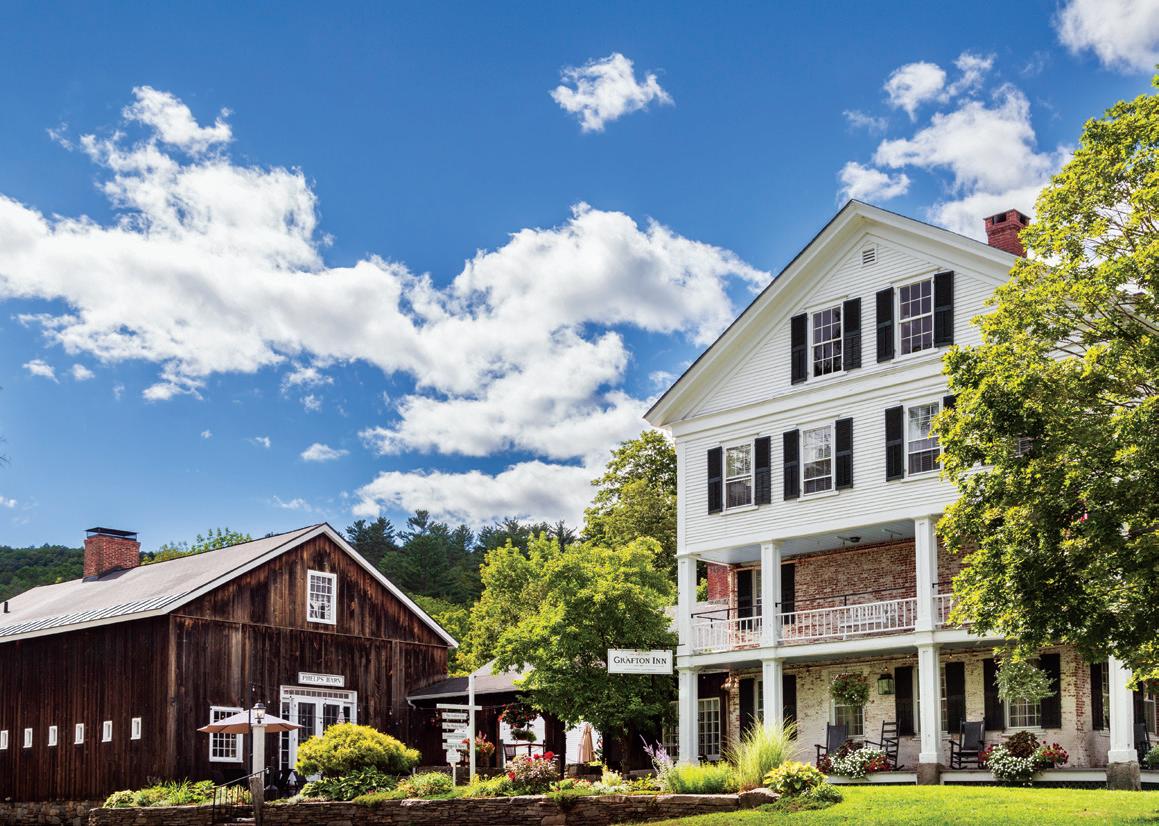


GRAFTON, VT
Retreat to nature at the Grafton Inn in beautiful Grafton, Vermont. For an event that will leave everyone in attendance impressed, gather your team in Grafton, a place surrounded by breathtaking natural beauty and filled with inspiration. We specialize in hosting small corporate meetings and intimate executive retreats for nonprofits and businesses. Our newly remodeled Windham Foundation Conference Room is a warm and inviting space created to inspire your team. graftoninnvermont.com
Sandy Pines Campground is a haven for nature lovers seeking the perfect blend of outdoor adventure and comfort. Just minutes from Goose Rocks Beach, guests can unwind in thoughtfully designed retreats from cozy tents to our new Whimsical Retreats that sleep up to eight. Whether you're paddling from the private boat launch, lounging by the heated saltwater pool, or stargazing by the fire, Sandy Pines offers a joyful, relaxed escape that reimagines the camping experience. sandypinescamping.com




Lobster rolls and blueberry pie get a fresh twist inspired by our TV show, Weekends with Yankee.
BY AMY TRAVERSO
STYLED AND PHOTOGRAPHED BY LIZ NEILY
TUNE IN!
To find out where to watch the new season of Weekends with Yankee, go to weekendswithyankee.com, where you’ll also find full episodes from past seasons and 200-plus snackable segments.


I’ve enjoyed plenty of terrific seafood while filming nine seasons of Weekends with Yankee . I’ve tasted farmed sea scallops in Maine, harvested wild bay scallops off Martha’s Vineyard, and made lobster rolls at the famed McLoons Lobster Shack in South Thomaston, Maine. And in the fourth episode of the current season, I biked around Ipswich, Massachusetts, with chef Michael Serpa in search of the best fried clams.
With these iconic New England eats in mind, I developed a few seafood shack classics to make at home. The first is my take on the hot and buttered lobster roll. The trick? Parcooking the lobster meat and finishing it in melted butter enriched with dry sherry. The second is a blueberry hand pie loosely inspired by the fresh pie they serve at McLoons. Lobster and blueberries: Welcome to summer!
If you don’t like cooking lobster yourself, many supermarkets and fishmongers will cook them for you. Ask them to parcook them enough to remove the meat from the shell, 7 to 10 minutes. The shell should be partly orange-red and partly black.
4 live lobsters (1¼–1½ pounds each)
1 tablespoon plus 7 tablespoons butter (1 stick), divided 2–3 tablespoons dry sherry
4 split-top hot dog buns
Minced chives and lemon slices, for garnish

































Choose a pot large enough to easily hold all the lobsters. Set a steaming rack at the bottom of the pot and add 2 inches of salted water. Cover and bring to a rolling boil over high heat. Add lobsters one at a time, cover, and start timing. You want the lobsters to be mostly cooked. The shells should be mottled orange-red and black. Depending on the lobster size, this will take 7 to 10 minutes.
Remove lobsters and let them cool, then remove the meat from claws, knuckles, and tails. Drain meat, then chop into bite-size pieces. Reserve claws for garnish.
Melt 1 tablespoon butter in a large skillet. Toast the hot dog buns on both sides until golden brown. Set aside.
Melt 7 tablespoons butter in a large skillet over medium-low heat. Add 2 tablespoons sherry and taste. If you want a stronger sherry taste, add the remaining tablespoon. Add the lobster meat and cook, stirring occasionally, until opaque and firm, about 4 minutes. Divide lobster meat among the buns, topping each with claw meat. Garnish with chives and reserved lobster claws, and serve warm with lemon slices on the side. Yields 4 lobster rolls.
Precooking some of the blueberries minimizes the gap that can form between the filling and the top crust. To maximize flakiness, keep the dough cold while you roll and shape it. If it starts coming to room temperature, wrap the dough in plastic wrap and pop it in the freezer for 10 minutes.
2½ cups all-purpose flour (350 grams), plus more for work surface
2 tablespoons granulated sugar
1½ teaspoons kosher salt
18 tablespoons chilled unsalted butter (2¼ sticks), cut into ½-inch cubes
7–8 tablespoons ice water
Egg wash (1 egg white whisked with 1 tablespoon water)
Sanding sugar, for sprinkling (optional)
FOR THE FILLING
4 cups frozen or fresh wild blueberries
½ cup granulated sugar
1½ tablespoons minute tapioca
1 tablespoon fresh lemon juice
½ teaspoon ground cinnamon
Pinch of salt
FOR THE GLAZE
½ cup powdered sugar
1–2 tablespoons fresh lemon juice
First, make the crust: In a food processor, pulse together the flour, sugar, and salt. Sprinkle in the butter cubes and pulse just until the butter is broken down into chickpea-sized pieces, 4 to 6 pulses (1 second each).
Transfer dough to a medium bowl and drizzle with 7 tablespoons ice water. Gently stir with a rubber spatula until the dough sticks together. If there are still dry spots, add the remaining tablespoon of water and stir again.
Turn dough out onto a sheet of parchment paper. Gather it together and divide into two equal portions. Shape each into a rough square, wrap tightly in plastic wrap, and refrigerate at least 2 hours and up to 3 days.
Next, make the filling: In a 3- or 4-quart pot, stir together half the blueberries with the sugar, tapioca, 1 tablespoon lemon juice, cinnamon, and salt. Set over medium heat and cover. Cook, stirring occasionally, until berries begin to release their juices, 8 to 10 minutes. Remove lid and reduce heat to medium-low. Continue cooking until mixture becomes glossy and thicker, 6 to 8 minutes more. Remove from heat and stir in remaining blueberries. Cool completely (the mixture will thicken more as it cools).
On a floured counter, roll out one portion of dough into a rough square about ⅛ inch thick. Use a 4-inch round cutter or bowl to cut dough into circles, and set them on a parchment-lined baking sheet. Gather and reroll dough as needed. Refrigerate the circles, covered in plastic wrap, while you roll out and cut the remaining dough. Refrigerate as before.
Preheat oven to 400°F and set a rack in the lower third. Take the first batch of rounds out of the refrigerator. Spoon ¼ to 1/3 cup of filling into the center of each round, brush edges with egg wash, and then fold over. Press the edges with fork tines or crimp to seal. Cut two vents into the top of each with a sharp knife. Refrigerate assembled pies while you fill and seal the remaining rounds.
Brush the tops of all pies with egg wash, sprinkle with sanding sugar (if using), then bake, turning the trays halfway through, until golden brown and crisp, about 25 minutes.
Remove from oven and cool completely on wire racks. Meanwhile, make the glaze by whisking the powdered sugar and lemon juice until smooth. When the pies are cool, drizzle with the lemon glaze. Serve at room temperature. Yields about 10 hand pies.


I was still in New Smyrna Beach when I started thinking about all I’d do on my next visit to New Smyrna Beach: a breeze-blessed barrier island on Florida’s Atlantic coast where everyone seems energetic and happy. Enveloped by water—sky-blue ocean to the east, the Indian River to the west—this laid-back place appears to exist along a meridian isolated from commercialism and the cares of the world. It is perfectly okay to
plan your days around pure fun here. Everything else can wait. In reality, you’re only a half hour from Daytona Beach International Airport, which is more connected to New England via direct flights than ever. In-the-know travelers check Allegiant’s schedule of nonstop flights from Portsmouth, New Hampshire, to Orlando Sanford International Airport, too. This landing spot is just about 45 minutes away from New Smyrna
Beach’s 17 miles of packed-powder sand. And with one-way fares as low as $43, a return visit’s easy to imagine if, like me, you’ve left more than a few things undone.
High on my list is a nighttime pedal-kayak outing with Viking EcoTours. As we explored Canaveral National Seashore’s protected waters with owner Eric Hansen on a sunny February afternoon, listening to his knowledgeable voice but also, in wind-pushed quiet moments,
to a distant dolphin’s splash and to turkey vultures and ospreys asserting their presence, I knew his popular after-dark adventure must be magical. From May through September, these biodiverse waters are at their bioluminescent peak, with glowy plankton and comb jellies putting on a water-fireworks show that outsparkles starry skies.
Locals call the Indian River the “Intracoastal,” and this calm waterway beckons me back, too. This time, when I board Toon Tiki Charters’ thatched-roof boat, I want to be on a three-hour yogaand-swim excursion. I might not spy a Kennedy Space Center rocket launch—that was a cool bonus on my first sightseeing voyage—but I think stretching my limbs on the soft, warm sand of a secluded mangrove island, then taking a refreshing plunge, will feel even more exhilarating.
Next trip, I will take a resinpainting class at The Hub on Canal, an artists’ collective where I observed a demonstration of this fluid and unpredictable technique. How therapeutic it will be to play with turquoise hues, sand sprinkles, and shells, knowing that creating a stunning keepsake is all about letting go and allowing the colors to bubble and flow.
Of course, I will pop around the corner to Jane’s Art Center to pet Tom Cruise. It’s not what it sounds like! This Tom’s a little gray-andwhite cat who just might be the gentlest, most trustworthy furball in the world. He’s an inspiration to
the potters who work here, and he moves lithely among their gallerydisplayed works, the antithesis of the proverbial china-shop bull.
More retail therapy is on the agenda, too. Thoughtfully curated shops line Canal Street in the creative district and Flagler Avenue near the beach. The sheer variety of beaded bags at Bamboo Trading Company makes gift shopping a delight. I love the lace-sleeved sweater I found at The Posh Pineapple, a clothing boutique where the prices are surprisingly reasonable and the staff is helpful and kind. There are laugh-out-loud tea towels I’ll pick up this time at Wild Oats & Billy Goats, which showcases eclectic local makers and shares a space with Little Griddle, a nostalgic diner (yes, there are red counter stools). I want to revisit in the heat of summer, when lodging rates dip. I’ll stay in a beachfront, poolside room at SpringHill Suites New
Marriot
Smyrna Beach again, cracking my balcony door open at night to allow the ocean’s roll to lull me to sleep. Humidity’s not an enemy when cooling water, more refreshing than air conditioning, is always steps away. The hotel’s local owners have created a home-like place that feels in character for this Old Florida beach town, so don’t be fooled by the chain affiliation.
And when winter descends upon New England? I’ve never felt cut out to be a true snowbird, winging down south for an extended reprieve. But then again, I’ve never found a warm-all-year destination with so much pull on my soul. As we were kayaking in the national seashore’s Mosquito Lagoon, Eric pointed out a hooded merganser, a fish-loving duck common in New England but rarely seen in Florida. I’m taking that as a sign.
Start planning your escape to this happy place at visitnsbfl.com
—Kim Knox Beckius




THIS SOUTHERN NEW ENGLAND SEAFOOD MECCA IS FILLED WITH SURPRISING DIVERSIONS.
BY KIM KNOX BECKIUS | PHOTOS BY ERIN MCGINN




this page: Charlestown’s gracious General Stanton Inn has been welcoming guests since 35 years before the American Revolution. opposite, clockwise from top left: Vine-ripened tomatoes at Quonnie Farms; kayaking on Ninigret Pond; one of Danish artist Thomas Dambo’s troll sculptures at Ninigret
a taste of 401
lakeside libations
Which products does your local convenience store tout? Deli meats? Snacks? Milk? Lottery tickets? I did a double take as I drove past the Charlestown Mini-Super, then turned around so I could snap a picture of the rope-strung boards dangling from the market’s roadside sign: Scallops. Oysters. Fresh tuna. Littlenecks. Swordfish. Shrimp. Smoked fish. Salmon. I already knew Charlestown as New England’s most famous all-you-caneat lobster destination and the host of a major summer seafood festival, but local sea fare as a part of everyday life? Sign me up.
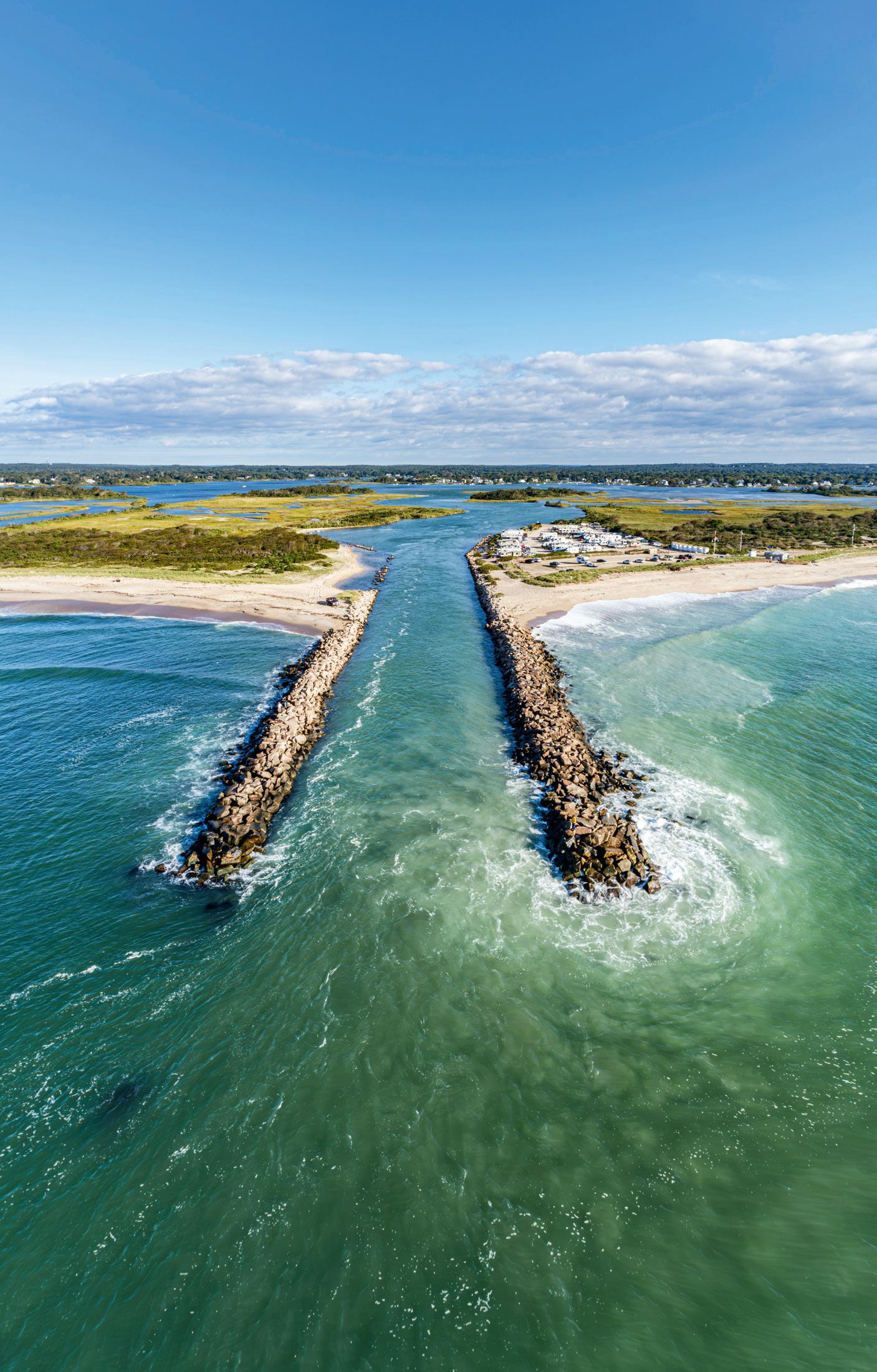
Of course, I ventured inside, even though I wouldn’t be needing raw fish where I was headed for the night: the General Stanton Inn, a “George Washington was here” survivor recently revived and with its own oceanto-table tavern. But you can learn an awful lot about a community from a hub like the MiniSuper. Especially one that swells from 8,000 souls in the winter to 30,000 each summer.
They come for South County’s beaches, of course. They love how easy-to-reach and under-the-radar these swaths of sand are. But a quick scan of the flyers posted in this little store reveals there’s a Who needs the ocean? side to Charlestown, too. There’s live music during Saturday breakfast at The Hungry Haven and on summer weekend nights at the Charlestown Rathskeller. There’s drop-in yoga, indoors and out, at peaceful Rockbriar Farm (stroll the gardens or snooze in the hammock after class). There are free family-friendly activities at Kettle Pond Visitor Center, Thursday concert and movie nights in Ninigret Park, and Friday farmers’ markets and Sunday flea markets at the General Stanton.
And what kid wouldn’t love searching for Ninigret Park’s ginormous trolls, brought to life last year by Danish recycling artist Thomas Dambo with reclaimed natural materials and contributions from local students and volunteers? Ninigret Park is also home to a


playground, a cycling loop, a freshwater swimming beach, and Frosty Drew Observatory, which hosts free Friday stargazing nights.
In just four days, my daughter and I will see Ninigret Park during its busiest weekend, filled with RVs, salivating seafood lovers, and one guy who walks around wearing a giant balloon lobster he controls like a puppet. Before then, however, I’m on a mission to find the quieter side of this shore town before the carnival-like Charlestown Seafood Festival, always the first weekend in August and celebrating its 40th anniversary this year.
My search begins at the sea. Receding glaciers gifted Charlestown with a string of south-facing barrier beaches. The easiest to reach, Blue Shutters, is the liveliest. Charlestown Breachway State Beach and its campground are popular, too. Town Beach is lesser known, except to locals. But it’s East Beach where you’ll find tropical-blue surf, space to sprawl on cinnamonsugar sand, and the wild tranquility

of a largely undeveloped three-mile stretch of coast. There’s very little parking here, so arrive early or reserve a four-wheel-drive permit and camping spot.
Don’t sleep on Charlestown’s salt ponds as an alternative for on-water recreation. Those same glaciers gouged these tidal lagoons embayed by the barrier beaches. They’re like briny lakes with ocean breezes. Ninigret Pond, the largest, is not only a stunning place to kayak or windsurf, but also a prime breeding ground for bivalves. Some 40 percent of oysters harvested in Rhode Island come from Ninigret Pond, and this summer 401 Oyster Co. is launching aquaculture boat tours here. You can also buy a nonresident recreational shellfishing license and dig your own quahogs, soft-shell clams, and oysters at low tide. They never taste better than when your back and shoulders still feel the effort.
If you kick off your weekend with outdoor exertion, a festival (Rhythm & Roots is a Labor Day weekend tra-
dition), a day at one of the splashier beaches, or a night of all-you-candevour indulgence at The Nordic’s lobster-plus-everything buffet, Sunday morning calls for sipping an iced wildflower latte at Dave’s Coffee or savoring a fresh-baked-focaccia egg sandwich at Quonnie Farms. Then, there are so many places to stretch your legs—the loop skirting Watchaug Pond within Ninigret National Wildlife Refuge, for example, where the diversity of vegetation attracts more than 250 feathered species.
I prefer to walk around The Fantastic Umbrella Factory. How to describe this inimitable bazaar, where shoppers crunch along clamshell paths, brown bags of feed for the roaming hens in hand? You might leave with a block-

print T-shirt, candy, or an armload of plants. The vibe is more subdued inside soft-spoken wampum artist Allen Hazard’s shop, The Purple Shell. This Eastern Native trading post filled with indigenous handcrafts is “like a museum,” he admits.
Got time? He’s a living connection to the ways of his Narragansett and European ancestors. He’ll tell you how quahogs, especially the ones with big, deep-purple shells, “are becoming harder and harder to find.” How he’s concerned about overfishing and pollution not only because he turns these shells into one-of-a-kind jewelry and hand-carved walking stick embellishments, but also because he really likes quahog chowder.
Back outside, what I love most is the peace you can find inside the maze-like bamboo forest. Listening to the rustle of skyscraping grasses and your own inner voices—most likely your heart and stomach debating, What’s next? A beach sunset? Or another heaping plate of seafood?
EAT & DRINK
The Breachway Grill: If you like your lobster piled atop fries or black-truffle mac and cheese, this fun-casual restaurant and bar is your “calories don’t count on vacation” enabler. All of the yumminess is scratch-made, and beachy cocktails are almost too pretty to drink. Almost. breachwaygrill.com
Charlestown Rathskeller: Rhode Island’s coldest beer is here (there’s a temperature gauge on the wall to prove it!), and with backyard games and a summer stage, you’ll feel like you’ve been invited to the best party in town. thecharlestownrathskeller.com
Monahan’s Clam Shack by the Cove: If Fish Reuben is on the specials board, this zingy sandwich is what you want. If not, you can’t go wrong with goldencrisp clam cakes or a lightly dressed cold lobster roll. There’s a picnic garden where you can sip frozen Del’s lemonade among the hydrangeas while you wait for your order. monahansri.com
The Nordic: There’s a two-hour limit (and steep cost) on downing everything from local oysters to unlimited lobster to bourbon pecan pie. Not up for the
all-you-can-eat buffet? Sit lakeside and order apps and drinks. You’ll be just as warmly welcomed: The Nordic’s been in the same family since 1963, and they know a thing or three about hospitality. thenordic.com
Breachway Bait & Tackle: Rent a kayak, canoe, or SUP for your salt pond explorations. This fishing-focused outfitter will also rent you a clam rake. Rhode Islanders don’t need a shellfishing license, but out-of-staters do (buy one at rio.ri.gov). breachwaybait.com
The Fantastic Umbrella Factory: When you’ve used up your sunscreen, venture to this bohemian outpost where you can definitely buy incense but won’t likely find an umbrella. Goats and chickens will be happy to see you, as will the keepers of indoor-outdoor shops including a general store right out of Woodstock. fantasticumbrellafactory.com
Kettle Pond Visitor Center: At the gateway to Ninigret National Wildlife Refuge and its four-plus miles of trails, you can learn more about this region’s unique habitats and geologic features. An exhibit scavenger hunt keeps kids engaged. fws.gov/refuge/ninigret
Ninigret Park: While summer events like the Charlestown Seafood Festival (charlestownseafoodfestival.com) and Rhythm & Roots (rhythmandroots.com) are ticketed, most of the park’s attractions are free. That includes photo ops with Erik Rock and Greta Granite, two massive trolls by artist Thomas Dambo. charlestownri.gov/parksandrec
General Stanton Inn: New owners brought this 1740 landmark back to life two years ago, and its purported ghosts seem to dig the refresh. You will, too, whether you tuck in for the night or dine on hearty land and sea fare in the tavern. thegeneralstantoninn.com
Hathaways Guest Cottages: In the heat of summer, you’ll appreciate having a swimming pool shared by just seven snug rental cottages (two are pet-friendly) and a 19th-century farmhouse that sleeps up to 10. hathawaycottages.com
Phil & Ann’s Sunset Motel: This familyowned motel with a seasonal outdoor pool looks like it popped straight out of your parents’ or grandparents’ three-ring photo album. The rooms are contemporary and clean, while the beaches are just three miles away. philandannsmotel.com

Eartha, the world-recordsetting revolving globe, Yarmouth, ME
Curiosities and marvels invite New England road-trippers to make unforgettable detours.
BY BILL SCHELLER
CONNECTICUT RIVER FERRIES, Chester, Hadlyme, Rocky Hill, and Glastonbury. New England’s two shortest voyages take place on its longest river. Car and pedestrian ferries cross the Connecticut between Chester and Hadlyme, home of Gillette Castle State Park; and between Rocky Hill and Glastonbury. The latter is said to be America’s oldest continuously operating ferry, dating from a 1655 raft-and-pole operation, while the former employs one of the region’s most venerable working
watercraft: the three-quarter-centuryold Selden III. Capacity is limited … but you won’t wait long for the next trip. ct.gov/dot/ctferries
DINOSAUR STATE PARK, Rocky Hill. For a few weeks some 200 million years ago, mud conditions were just right for capturing roughly 2,000 dinosaur footprints in this central area of Connecticut. Dried and buried, they were discovered during highway construction in 1966, and over 750 of the prints are preserved under a geodesic dome at the park. There’s also a casting area, where
visitors bringing their own materials can create mementos far beyond the usual souvenir-shop offerings. ctparks.com/parks/ dinosaur-state-park
THE ESSEX STEAM TRAIN & RIVERBOAT, Essex. Three steam locomotives, two more than a century old, join the riverboat Becky Thatcher as stars of a two-and-a-half-hour excursion along the lower Connecticut River Valley. The trip begins at Essex’s 1892 station and takes in sights such as Gillette Castle, the Goodspeed Opera House, and secluded Selden Neck State Park. Separate boat and train rides are also offered, as are Essex Clipper dinner trains featuring four-course meals served in restored 1920s dining cars. essexsteamtrain.com
HELEN S. KAMAN ROSE GARDEN AT ELIZABETH PARK, West Hartford
Looking for Grandma’s Blessing? Or an Orchid Romance? Those are two of the 800 varieties of roses blooming on some 15,000 lovingly tended bushes at this 2.5acre garden dating from 1904. Plantings include climbing, shrub, and pillar roses, (Continued on p. 104)
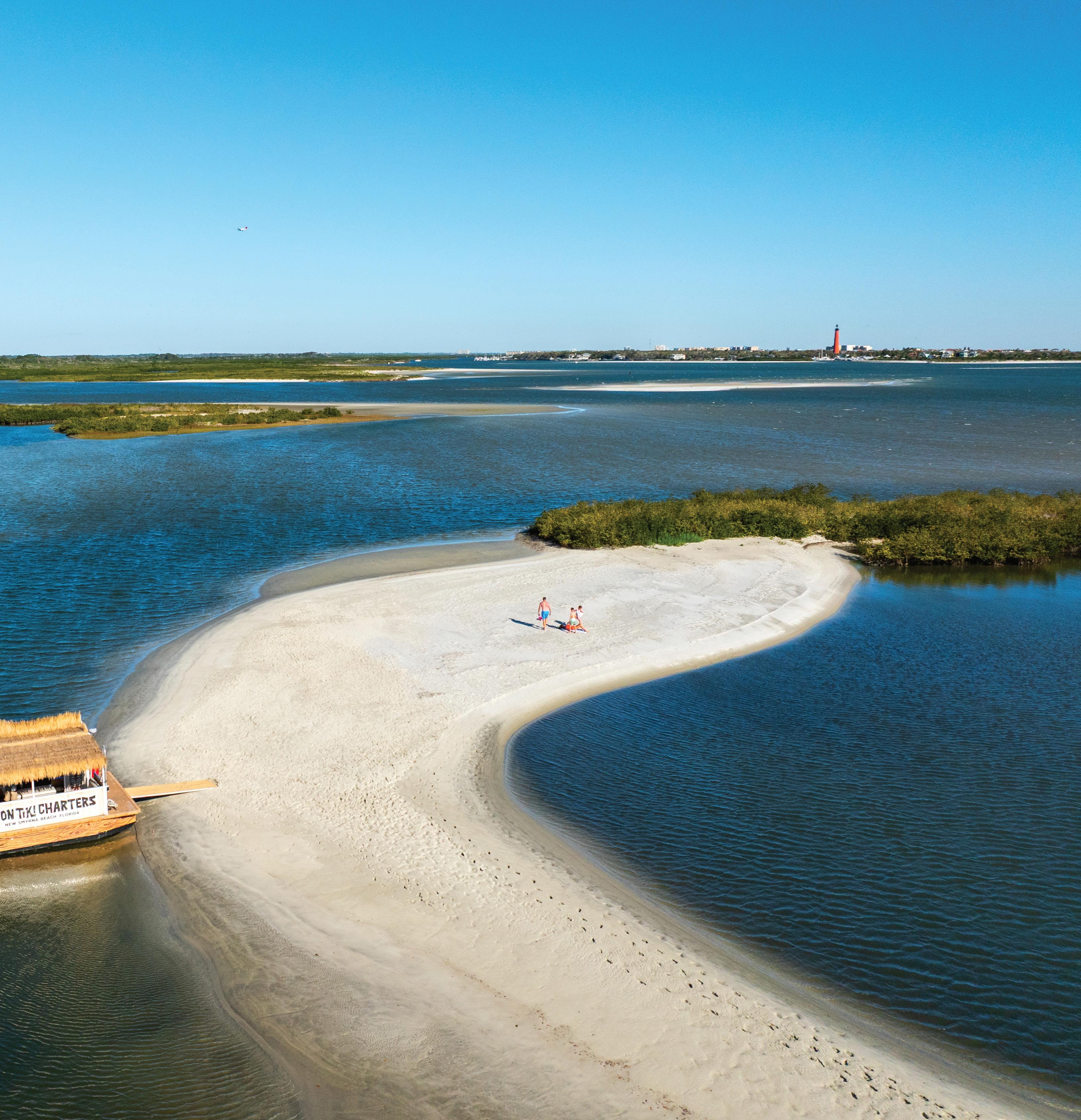



With 17 miles of sun-bathed beach, endless trails to explore, and relaxing places to stay, this is where people with too much going on go to forget about it all. And for the foodie in you, The Second Annual Coastal Catch Restaurant Month is returning this October. So, if you’ve been looking for your happy place, Relax, you’ve found it.

PLYMOUTH, MA
Explore America’s founding story in New England’s oldest town! Plimoth Patuxet Museums is a must-see destination, sharing the compelling history of the Indigenous Peoples and Pilgrims who met in 1620 and set into motion the great American Experiment in self-governance.
508-746-1622
plimoth.org/plan-your-visit

Enjoy a quarter mile of sandy beach and docks on the shores of Lake Winnipesaukee. Lakeside cottages, apartments, and rooms available. Great location for fishing, hiking, kayaking, boating, and more. Family owned and operated since 1890.

Experience the enchanting cottage that inspired Elizabeth Orton Jones’s Little Golden Books version of “Little Red Riding Hood.” Untouched by time, this is a mecca for gardeners, epicureans, and anyone looking for inspiration and relaxation. Have a Pickity day!
603-878-1151 pickityplace.com

Spanning 700 acres, this resort offers activities for everyone, from horseback riding to clay bird shooting and boat rides. With luxurious accommodations, an on-site spa and salon, and exquisite dining, it’s the perfect getaway destination. A short drive from home— made to feel like a world away.

Beginning this fall and continuing through 2026, Westerly’s historic United partners with Nashville’s iconic Bluebird Cafe, presenting singer-songwriters in the same intimate, immersive style that makes the Bluebird legendary. Discover these performances and more with Nashville North at The United. 401-388-8208 unitedtheatre.org or nashvillenorthri.com

Celebrating 75 years nestled in Vermont’s scenic hills, the newly rebranded von Trapp Family Lodge & Resort blends Austrian charm with modern luxury. Guests enjoy cozy accommodations, outdoor adventures, gourmet dining, and stunning mountain views—all inspired by the legendary von Trapp family heritage.

Nestled in the beautiful green hills of New England, the Bedford Village Inn & Grand is a four-diamond property that perfectly blends historical character with a luxury boutique ambiance. Its 64 gorgeously designed rooms retain the rustic charm of days gone by, while simultaneously offering everyday modern comfort and amenities.
800-852-1166
bedfordvillageinn.com

Discover Acadia’s historic carriage roads on guided tours or self-guided adventures with premium electric bikes. Journey through car-free paths, marvel at granite bridges, and circle pristine mountain lakes like Jordan Pond and Eagle Lake. The ride of your life awaits.
603-293-4321
amesfarminn.com
802-483-2311
mountaintopinn.com
802-253-5769 vontrappresort.com
207-779-4665
islandtimeebike.com
Reconnect with past Editors’ Choice winners and see for yourself why they received Yankee Magazine’s highest accolade.
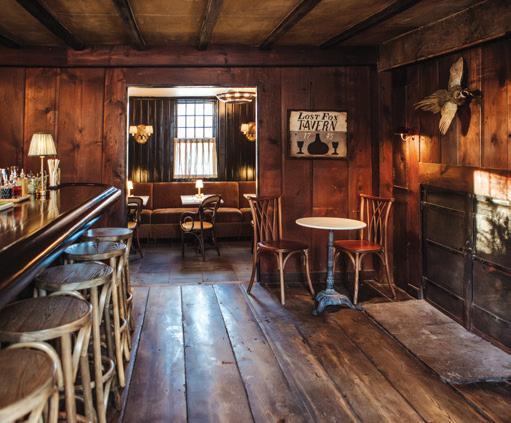
CT
A rare, historic boutique inn that perfectly encompasses both luxury accommodations and an award-winning culinary program. Spacious guest rooms (many with spa tubs and fireplaces), coupled with fresh cocktails and delicious fare in the tavern, create an unforgettable experience.
860-222-0855 lostfoxinn.com

CONWAY SCENIC RAILROAD
NORTH CONWAY, NH
New Hampshire’s Conway Scenic Railroad celebrates 150 years of rail operation over Crawford Notch! Between May and November, enjoy a four-hour journey through the Mount Washington Valley aboard the Mountaineer, featuring classic 1950s streamlined railcars. Premium dome seats available.
603-356-5251 conwayscenic.com

Enjoy your own lakefront cottage this summer! Located on four tranquil acres on Lake Winnipesaukee, our fully furnished cottages have provided family vacations for 70+ years. Offering sandy-bottomed swimming, boating, or simply relaxing on our lakefront sundeck… find your classic summer.
603-293-9391
sundeckcottages.com

The Boston Globe describes Fat Sheep Farm as “a magical place” offering amazing views from modern cabins. Soak in the sunset by the firepit, taste the farm’s bounty, try your hand at milking sheep, or attend a cheese-making or sourdough workshop.

When was the last time you touched the soft coat of a baby horse? Experience living history at this National Historic Site and University of Vermont teaching farm. Open MayOct. for guided tours and special events. 74 Battell Drive, Weybridge, VT.
802-388-2011
uvm.edu/cals/morganhorse farm

Choose your own adventure at The Trustees with something for everyone at our special places across the state. Plan a leisurely walk or a strenuous hike, enjoy a day at the beach, or visit one of our working farms.

The Margin Street Inn is an award-winning bed & breakfast located in Westerly, RI, a short walk form downtown and four miles to Watch Hill. Come enjoy our 10 luxuriously appointed guest rooms, delicious homemade breakfasts, and six riverfront acres.
401-348-8710
marginstreetinn.com

Return to The Wentworth, a charming inn located in the heart of Jackson, NH. Enjoy fine dining in our historic 1869 Dining Room or casual fare at the Alpine Tavern. Explore the breathtaking White Mountain National Forest, right at our doorstep. A timeless resort in the heart of New England.
802-436-4696 fatsheepfarmvermont.com
617-542-7696 thetrustees.org
603-383-9700
thewentworth.com


In a region with thousands of lakes and an endless coastline, which should you choose for summer fun: fresh or salt? A guide to New England waterculture.
In which two Yankee editors choose sides in the ocean-versus-lake debate—and then head off to a New England beach in search of common ground. BY AMY TRAVERSO & IAN ALDRICH



Amy Traverso, senior food editor
I am a beach person. Actually, that’s too mild a statement: I’m a beach junkie. I crave salt air and the scent of dune grass. The best sleep I know is a nap on a blanket in the warm sand. In my experience, there is no personal burden or worry that can’t be eased (or at least blurred at the edges) by proximity to the ocean. Isak Dinesen said it best: “The cure for anything is salt water: sweat, tears, or the sea.”
I know that not everyone feels this way. My husband, a Florida native, wonders what could possibly be worth putting up with so much sand. He likes beach towns and vacations near the ocean, but he’d just as soon swim in a lake—a saltless, waveless, perfectly-fine-butnontransformative lake.
I have swum and camped and floated on lakes and loved it. They’re nice. They’re beautiful. They don’t threaten. But nor do they scrub your soul clean. You set off in a boat on a lake and you’re still—forever—on that lake. On the ocean, we could be headed to Bermuda or Rome. We’d need a bigger boat, but we could be.
Ian Aldrich, executive editor
A few summers ago, against my better judgment, I took my young son to the ocean. We’d been weathering a torrid stretch of heat, and Calvin had spent most of his waking hours pleading for a beach day. So, on an especially hot Saturday morning, we loaded up the car and made the 90-minute drive from our home to Rye, New Hampshire. We schlepped our supplies—blanket, small cooler, towels, some beach toys I’d found in the garage—and set everything up.

Surely, this is the objectively better option.
Taking a seat, I looked around. At all the sand. At the beating sun. At the hordes of people. We were near the water, but not really. We’d been there maybe 15 minutes when I turned to Calvin.
“I can’t do this,” I told him. “I can’t be here. We have to go.”
Downcast and confused, he helped me pack. A half hour later we were eating lobster rolls in North Hampton, under the shade of a tall pine tree. Maybe we’d be home in time, I said, to go for a swim at the lake near our house.
home in time, I said, to go for a swim at the lake near our house.
Calvin nodded glumly as if to say, How’d I end up with this guy?
get dinged for being placid and calm, but that’s
As parenting moments go, it wasn’t one of my best. But I share it to illustrate just how much of a freshwater person I am. Lakes get dinged for being placid and calm, but that’s all part of their charm. The quietness grants the possibility to be still. To slow down.
An ocean day means work. You have to pack. You have to drive. You have to find parking. You have to stake out your plot of sand. And even then, you may not be free of a traffic jam of people “vacationing” right alongside you. If I want to toil uncomfortably for hours amid a crowd of strangers, I can go mall shopping. At least there’s air conditioning.
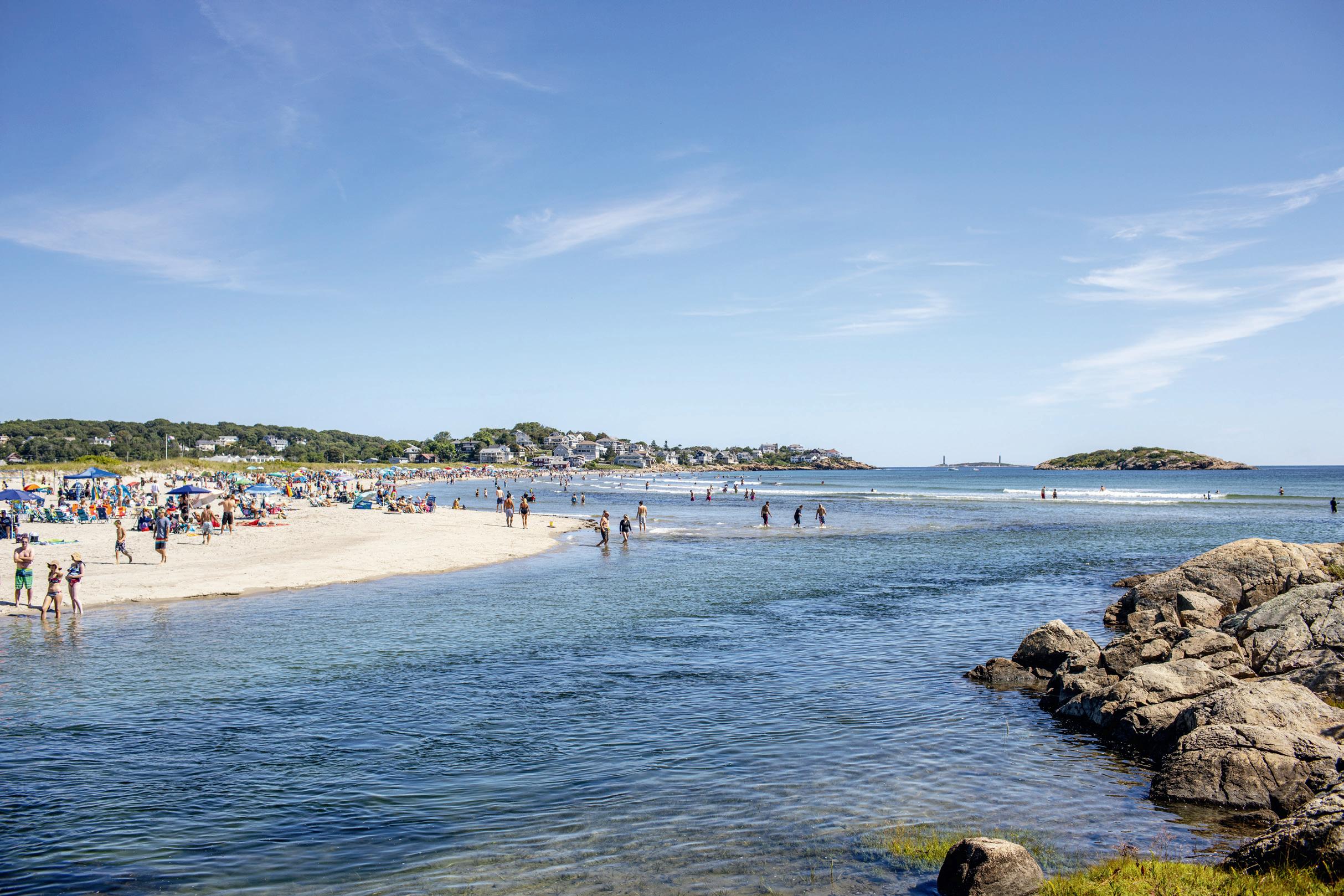
Can a lake partisan be converted to the joys of the ocean? Amy gives it her best shot.
One summer day in Yankee ’s offices, my colleague Ian tells me that not only does he prefer lakes, he hates beaches.
I know my mission. I will anticipate his every discomfort or complaint, including too little parking, too much sand, too cold water, too much schlepping, too much sun, and too many people. And I’ll make him see that beaches are better than lakes.
I don’t spend much time asking myself why I want so much to change his mind. Sure, perhaps I have a mild preference for achieving complete control over situations. Maybe when other people like what I love, it makes me feel smart (and I suppose I could unpack that if you have 50 minutes and take my insurance). Could there be just a hint of narcissism in all this convincing? I’m just asking questions here. I’m no expert.
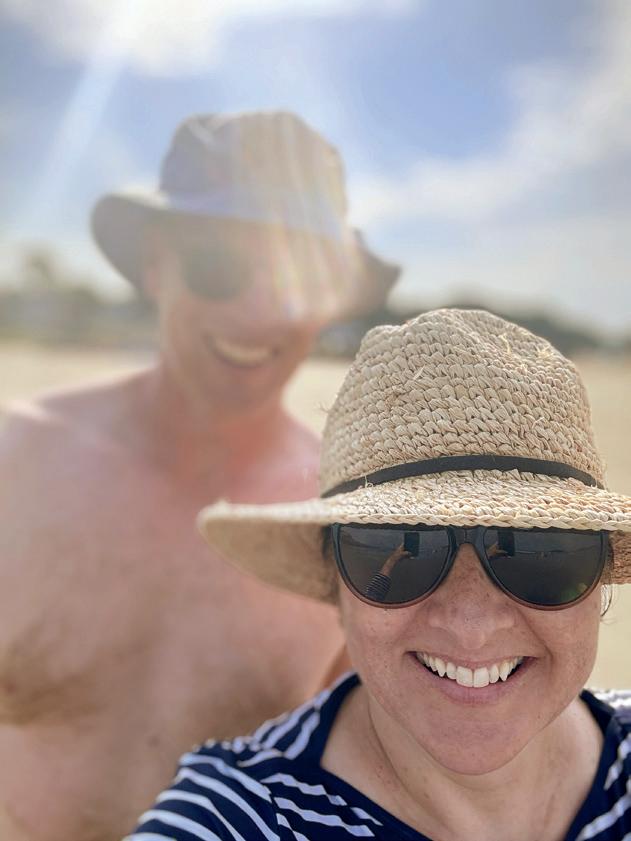
Solving the parking problem is easy: Many public beaches now allow you to reserve a spot online. But the beach must also be beautiful. It must have bathrooms and showers. (No sandy feet for Ian!)
I settle on Good Harbor Beach in Gloucester, Massachusetts, which has all these facilities, plus a snack bar and a tidal
creek at its southern end where the water is markedly warmer. At high tide, you can float down the creek under a footbridge and right into the ocean. And at this end, the beach is never truly crowded, even on weekends.
The next order of business is gear, and this is where I really stack the deck. I’ve already invested in a great shelter, large enough for two, in a jaunty blueand-white cabana stripe. But I need to get Ian not just out of the sun, but off the sand, too. After a bit of searching, I find a collapsible hammock, sturdy and portable, with a total weight of about 20 pounds.
Then there are refreshments: I load a cooler with cold packs, nectarines, berries, fine cheeses, crackers, charcuterie, and cookies, as well as several flavors of seltzer. Finally, I buy a collapsible wagon with wide, beach-friendly tires.
After arriving at the beach, I’m piling everything into the wagon—rafts, shelter, hammock, food, suntan lotion, towels, beach chairs—as Ian finds
Finding

allegiances.
my car, all smiles. “Hey, we got great weather!” he says.
As if there’s a single factor that I haven’t controlled for, I think. Like I didn’t check The Old Farmer’s Almanac first. But I just smile insouciantly.
The beach wagon is packed and feeling a bit heavy. But it rolls gamely along the parking lot and up to the edge of the sandy path that takes us to the creek. Two feet in and the wheels lock up, sinking a few inches. I pull harder, levering my body in search of traction. The wheels are, at best, sliding through the sand.
“Do you need some help with that?” Ian asks. Ha-ha, no! I’m good. I tug harder.
“I guess I overpacked,” I trill. Now I’m sweating. I am well and truly schlepping, and that will not do. But we will get this over with and he will forget. And if we eat enough, the cart will be much lighter on the way back.
I reluctantly accept Ian’s assistance, and we push-pull the cart down the longer-than-I-remember path to the creek and pick a spot by the water. I get busy putting up the shelter, again refusing help, unfolding the hammock, laying down a blanket, unfolding chairs.
Ian hops right into the hammock. “Wow!” he exclaims. “This is pretty great!” I wipe my brow and sigh with relief. I point out the ocean to our left and the cool-but-not cold creek before us, then inflate a raft and head into the water, if only to rinse off the sweat. Ian settles in with a book.



Soon, we’re elbow-deep in water, jumping on the backs of waves to ride into shore—two overgrown kids. “ ”
I paddle around in the creek for a bit and decide I need to chill out. At this point, I’ve done what I can.
And it takes very little time to see that Ian is really enjoying himself. Eventually
he tells me it’s been a while since he’s lain around and simply done nothing. It’s a joy just to be still, he says.
The creek is now at high tide—prime floating hour—and we use the rafts to ride the swift current past the Bass Rocks Beach Club and into the waves. Soon, we’re elbow-deep in water, jumping on the backs of waves to ride into shore. We’re salty and silly; two overgrown kids.
When we get back to the shelter, I hand out snacks. It’s late afternoon and people have started packing up, but I explain to Ian that they’re missing the best part of the day, when the air and sand cool and the sky turns pink. We wait awhile.
“Well,” Ian finally says, “this is actually pretty delightful. I’d come back.”
At this point, I’m too relaxed to gloat. I gave my friend a good day, and that just feels nice.
But I do wonder: Without me acting as planner, sherpa, shopper, and guide, will he still like it?
Ian’s epilogue: I’ll admit it—Amy was as good an ambassador as the ocean contingent could have hoped for. For a few shining hours, yes, I loved the beach. When your afternoon consists of drifting down a tidal creek and having a plate of charcuterie at your fingertips, how could you chalk that up as anything but a great day? My only job was to arrive and hang out. It was like being at a lake … which, by the way, is where you’ll find me this summer. Because I’m not hauling any heavy cooler through the sand.
From seafood shacks to more upscale affairs, our food editor’s recommendations cover the waterfront. BY
AMY TRAVERSO
BEACH HOUSE GRILL, Chatham, MA. Part of Chatham Bars Inn but open to the public, this beachside restaurant takes its inspiration from classic New England seaside fare, albeit in more elegant surroundings. Try the chowder or any of the lobster dishes. chathambarsinn.com
THE LOBSTER SHACK AT TWO LIGHTS, Cape Elizabeth, ME. Representing the “rocky shoals” contingent of Maine’s coastline, Two Lights sits on a small promontory in Casco Bay. Watch the dramatic waves roil and explode off the rocks while savoring excellent chowder and fried seafood. lobstershacktwolights.com
SALTY’S AT SECOND BEACH, Middletown, RI. The successor to beloved Easton’s Beach Snack Bar, Salty’s continues serving the Easton’ssignature twin lobster roll special, one of the best deals on the coast. If only all public beaches fed you this well. twinrolls.com
SANDBAR AT JETTIES BEACH, Nantucket, MA. While “The Gray Lady” boasts a generous helping of righton-the-beach restaurants,

we love the coastal vibes at The Sandbar, located on a popular public beach and offering a menu loaded with great sandwiches and frozen cocktails, plus onsand seating and Adirondack chairs in sherbet colors. jettiessandbar.com
THE WHARF RESTAURANT, Madison Beach Hotel, Madison, CT. Sit on the veranda and enjoy the view of the hotel’s private beach, with Long Island Sound beyond, as you dive into ample salads, grilled swordfish, or decadent
short ribs—then go for a stroll on that same lovely beach. thewharfmadison.com
BRESCA & THE HONEYBEE, New Gloucester, ME. On the shores of Sabbathday Lake, acclaimed chef Krista Kern Desjarlais makes super-fresh ice cream with local milk and cream, as well as perfect iterations of picnic foods (sandwiches, pizza, etc.). Dine well, then enjoy the boating, tubing, or picnicking facilities at nearby Outlet Beach. brescaandthehoneybee.com
Grabbing a summer staple at a Rhode Island standby: lobster rolls from Salty’s at Second Beach.
FARMERS & FORAGERS DOCKSIDE, Burlington, VT. You can’t get much closer to Lake Champlain than at this seasonal dockside food truck with tented patio seating. Nor can you get closer to the bounty of inseason Vermont produce— the menu lists a who’s who of area farms. And despite being two states inland, the lobster roll is legendary. vtfarmersandforagers.com
RIVER DRIVERS
RESTAURANT, Millinocket, ME. Stunning views across Millinocket Lake to Mount Katahdin aren’t the only draw at this charming rural lodge: It also cooks food to rival that found in much bigger towns. Be sure to try the Friday all-you-can-eat fish fry, the lobster bisque, or the ribeye with herbed butter. neoc.com/ river-drivers-restaurant-maine
WALTER’S BASIN, Holderness, NH. A local institution since 1996, this year-round restaurant sits directly on Little Squam Lake. There’s dockside dining in the summer, but the views are all great, inside and out. And the food takes pub fare to the next level. waltersbasin.com
Dive into your preferred kind of summer fun at these standout beaches, lake retreats, and coastal escapes. BY STEVE
JERMANOK
BEACH STROLLING
Napatree Point
Watch Hill, RI
Saunter along Block Island Sound on Napatree Point, which begins at the historic Watch Hill carousel, and be soothed by the waves as you spot the small harbor of Stonington, Connecticut, and the dome of trees atop Fishers Island, New York, in the distance. On the return trip, savor the view of the Victorian houses that cling to the Watch Hill bluffs. thewatchhillconservancy.org
BEACHCOMBING
Wingaersheek Beach
Gloucester, MA
Wingaersheek’s shallow waters are ideally suited for that curious child—or child at heart—who loves to poke around tidal pools and clamber along the rocky shoreline to spot crabs and sea glass. Moreenergetic visitors will want to walk the ocean floor at low tide and glimpse the gleaming white lighthouse jutting out from neighboring Annisquam. gloucester-ma.gov/299/ beach-information
BIRD-WATCHING
Greenway Trails
Block Island, RI
Ramble along this nearly-30-
mile network of trails that winds from the middle of Block Island to the southeastern coast, and you’ll soon be surrounded by the aptly named Enchanted Forest, a deep, dark thicket of pines, spruces, and maples. In summer, pause to hear the call of goldfinches and watch graceful marsh hawks; in spring and fall, look for colorful migrating warblers. natureblockisland.org
Hermit Island Campground
Phippsburg, ME
With this region’s abundance of coastline, you’d think there would be many options to camp on the beach—not so. But the 255-acre Hermit Island Campground offers the rare opportunity to spend the night on the shore or atop the rocky cliffs, near tidal pools nestled within the forest. From there, you can go swim, fish, or paddle Casco Bay in the heart of midcoast Maine. Craving seafood? The camp store sells fresh clams and lobster (and will rent you the pot to cook them in). hermitisland.com
KID-FRIENDLY BEACH
Second Beach
Middletown, RI
On summer weekends, you may need some patience to grab a parking spot at coveted Second (Sachuest) Beach. But
the rewards are delightfully warm water and waves that are tailor-made for boogie boarding. Families will find all their needs covered here, from showers to picnic tables and grills, plus concessions that include a Del’s lemonade truck. middletownri.gov/349/beaches

Chandler Hovey Park Marblehead, MA
Make a beeline to this strip of land on a peninsula across the bay from the Marblehead Historic District for views
of sailboats heading out to sea. Better yet, bring a kite and make the most of the same consistent winds those sailors enjoy, especially as you make your way around the picturesque lighthouse. marblehead.org/aboutmarblehead/pages/parks
Joseph Sylvia State Beach
Edgartown, MA
Celebrate the 50th anniversary of Jaws this summer by heading to American Legion Memorial Bridge, otherwise
Crystalline waters cradled between Mount Hor and Mount Pisgah give Vermont’s Lake Willoughby a beauty all its own.

known as the “Jaws Bridge,” which connects Oak Bluffs and Edgartown. It was here that director Steven Spielberg set the infamous shark attack at the docks, and today the fearless delight in launching themselves from the bridge into the water below. mvy.com/ beaches-marthas-vineyard
Nauset Light Beach
Eastham, MA
It’s preferable to bike to Nauset Light Beach in the early morning, when the fog
might still cast a hazy glaze on the water. Then take off your sandals and plant your toes in the soft white sand, not yet hot. Stroll down the beach, and the dunes meld with sand, sea, and sky as your unencumbered feet appreciate each new footprint. nps.gov/caco/planyourvisit/ nauset-light-beach.htm
SCENIC STOP
Marginal Way
Ogunquit, ME
Newport’s famed Cliff Walk boasts glorious views and
Gatsbyesque mansions. Prouts Neck, Maine, is renowned as the backdrop for many of Winslow Homer’s masterworks. But we give the edge to the Marginal Way in Ogunquit, where the 1¼-mile-long paved path atop the rugged shoreline, hemmed in by century-old pines and cedar trees, leaves you awestruck by the thrashing of water against the rocks below. Give in to the temptation to linger and settle into one of the 39 numbered benches along the way. marginalwayfund.org
Madaket Beach
Nantucket, MA
The best way to leave behind the hustle and bustle of Nantucket’s day-trip scene is to rent a bike and ride along the paved five-mile path to Madaket Beach, located at the island’s westernmost point. Better yet, grab provisions in town and have dinner on this narrow, wild strip of sand that quickly drops down to the waters of the Atlantic. If you’re too tired to bike back after sunset, grab the local bus
(which can also collect your bike). nantucket-ma.gov/854/ visitor-information
Herring Cove Beach
Provincetown, MA
Any bayside beach on Cape Cod can lay claim to being the finest spot to watch the sun set, with perennial favorite Skaket Beach in Orleans being a prime candidate. Yet there’s something special about being on the curve of land at P-town’s Herring Cove Beach when the yellow-orange-red orb melts into the horizon. The hues linger long after the sun goes down, enhancing the magic. nps.gov/ places/herring-cove-beach.htm
Wasque Point
Chappaquiddick, MA
Let’s face it: No angler is going to give up their favorite
fishing spot. But the word is out on Wasque Point, a glorious strip of sand at the edge of Chappaquiddick, run by The Trustees. Its strong currents lure the kinds of prime specimens hauled in at the fabled Martha’s Vineyard Striped Bass & Bluefish Derby, which marks its 80th anniversary this fall. thetrustees.org/place/wasque
Rangeley Lakes Region
Maine
Take any trail in the Rangeley Lakes Region in central Maine, and you have a shot at both hearing and seeing a loon, spying a boreal chickadee flittering through the dense woods, and maybe even catching a glimpse of the
elusive Bicknell’s thrush. Bonus: the opportunity to breathe in some bracing piney air ... and possibly spot a moose. rlht.org
Tully Lake Campground
Royalston, MA
Run by The Trustees in central Massachusetts, Tully is a tranquil lake with little or no motorized boat traffic and tent-only campsites. Bring a kayak to paddle to the sandy isles along the sinuous Tully River. Then hike over to Doane’s Falls, where Lawrence Brook tumbles over a series of ledges before it reaches Tully Lake. thetrustees.org/place/ tully-lake-campground
Newfound Lake Bristol, NH
Maybe it’s the natural springs that replenish the crystal-clear
water. Or the prime location in New Hampshire’s Lakes Region, surrounded by forest with no commercial development. Whatever the reason, 6-milelong Newfound has garnered a reputation as having some of the cleanest lake water in America. Go for a dip and see for yourself. lakesregion.org/ our-lakes/newfound-lake
Waterfront Park
Burlington, VT
For dog owners, Waterfront Park checks all the boxes, including a long stretch of field nestled between a bike trail and the shores of Lake Champlain, a fenced-in dog park, and outdoor seating at nearby Foam Brewers where you can sip a refreshing IPA while your pup rests. burlingtonvt.gov/parksrecreation-waterfront
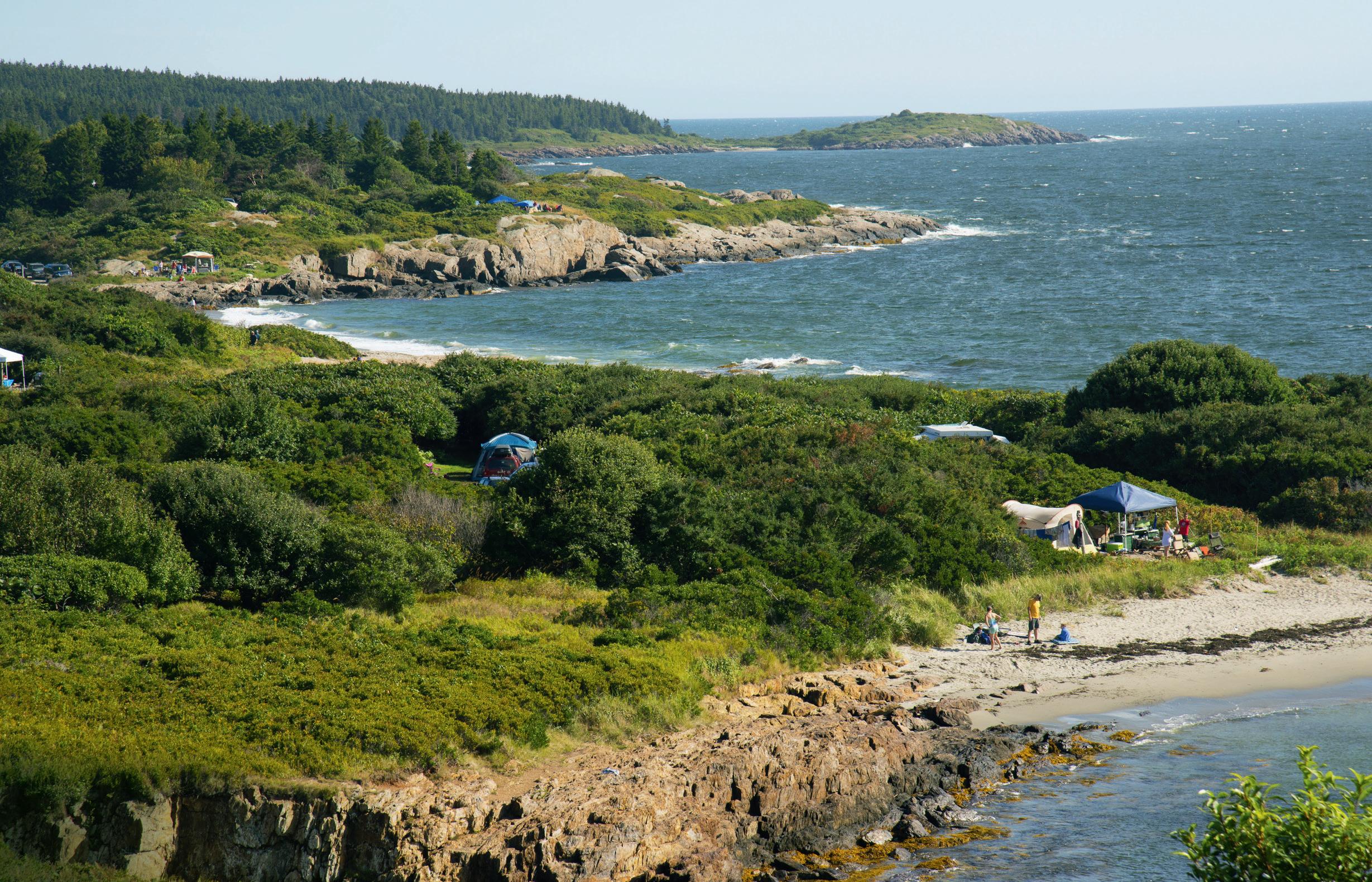

Moosehead Lake Greenville, ME
After winter storms with howling winds have finished blowing through the woodsy shoreline of Moosehead Lake, the only question is where to best find the fallen timber on this vast body of water, Maine’s largest. Mount Kineo State Park at the base of ominous cliffs is a good place to start. mountkineo
Damariscotta Lake State Park Jefferson, ME
Located a stone’s throw from the coast but offering far warmer water, a 4,600-acre natural lake is the namesake and crowning jewel of this state park. Shallow waters and summer lifeguards help create an ideal playground for kiddos, while the sandy beach is backed by picnic tables, grills, and a bathhouse with changing stations. Keep the sweet times rolling with a visit to the nearby Jefferson Scoop, which serves Mainemade Gifford’s ice cream. maine.gov/damariscottalake

Part of the 740-mile Northern Forest Canoe Trail, Umbagog Lake in New Hampshire and Maine stretches nearly eight miles long and is dotted with islands and coves to explore.
Squam Lake
Holderness, NH
The photogenic body of water known as Squam Lake hasn’t changed much since 1980, when the loons welcomed Henry Fonda and Katharine Hepburn to these serene shores to film the movie On Golden Pond. Fonda would go on to win the Academy Award for what would be his final big-screen role. lakesregion.org/ourlakes/squam-lake
Umbagog Lake Errol, NH & Upton, ME
The centerpiece of a national wildlife refuge, Umbagog is an immense lake whose shores lie half in New Hampshire, half in
Maine. If you put in from the New Hampshire side on the Magalloway River, you’ll follow great blue herons and loons into a channel that leads into Umbagog. Head straight for the islands that dot the western shoreline and you might very well find a pair of nesting bald eagles atop a dead tree. nhstateparks.org/ find-parks-trails/umbagoglake-state-park
Lake Willoughby Westmore, VT
Do yourself a favor and first hike Mount Pisgah, stepping out onto Pulpit Rock to peer across at the sheer cliffs of Mount Hor and then down at the glacially carved basin of dark blue water in between, Lake Willoughby. Afterward, reward yourself with a dip in the refreshing lake as you drink in one of the most dramatic sights in the Northeast Kingdom. fpr.vermont.gov/willoughbystate-forest
Lonesome Lake Franconia, NH
Earn the right to swim in aptly named Lonesome Lake by first hiking on a moderate trail 1.6 miles from the south parking lot of Lafayette Place Campground in Franconia Notch State Park. Upon arriving at the lake, savor the surrounding vista of White Mountain ridges, so seductive that you may be tempted to return and spend the night at the Appalachian Mountain Club’s Lonesome Lake Hut. nhstateparks.org/ find-parks-trails/franconianotch-state-park
Lake Waramaug State Park
Kent, New Preston & Warren, CT
Tucked into rural northwestern Connecticut, near the New York border, Lake Waramaug State Park is a mere 95 acres yet home to the state’s second-largest body of fresh water. While there’s plenty to do here for the action-
oriented—swimming, cycling, paddling—the true shareable moment comes at the end of the day, when the sun’s rays shimmer on the water and quietude abounds. Make it a picnic outing with a to-go meal from nearby favorites The Smithy Market, The Owl Wine & Food Bar, or The Hopkins Inn. ctparks.com/parks/lakewaramaug-state-park
Grand Isle State Park Grand Isle, VT
If you want to fly-fish for the elusive trout, it’s hard to top Vermont’s rivers—think the Battenkill, the Mettawee, and the White. Yet if we had to choose a lakeside locale, Grand Isle State Park on the northern tier of Lake Champlain would be high on the list. Here, you’ll find rainbow and brown trout, along with a good chance to hook northern pike and both small- and largemouth bass. vtstateparks.com/ grandisle.html
Cool hats, worn ironically.
Binoculars:
Great for ogling loons.

100% DEET:
Scent of automotive air-freshener and burnt plastic.
Floatable toys, to facilitate indolence.

Water shoes:
Protection from dock cleats, getting leeches between toes.
The dog: Never tires of swimming. Doesn’t mind mud. Stepped o the cover of an L.L. Bean catalog.

Maximal apparel, minimal fashion. ( ink: your best summer annel.)

Enamelware mug: Literally the same one your great-grandparents used.

Canvas tote: Exudes rugged New England appeal. Copy of The Portable Thoreau. (Will read four pages, then scroll Insta.)

Retro ice chest: Oozes authenticity, holds ice for maybe 15 minutes.
ADDITIONAL FIELD NOTES Squad goals: Ten-foot cannonball plume; making 12-pack of Truly last until dinner. Unique skills: Catching tadpoles barehanded; scrubbing bird poop from Adirondack chairs. Ground scores: Antique fishing lures; the
A true lake lover doesn’t hit the dock without all the freshwater fittings, just as any good beach bum comes toting saltwater swag. Presenting a field guide to New England’s two quintessential summer species in their natural habitats. BY
BRIAN KEVIN | ILLUSTRATIONS BY JULIA EMILIANI
Minimal apparel, maximal fashion. ( ink: linen tops and gauzy wraps.)
Stainless steel tumbler: An eco-friendly alternative to the Solo cup your parents used.


Silly, floppy hats, worn earnestly.
Mirrored shades: Great for ogling sunbathers.
SPF 50: Scent of coconut, vanilla, and tea tree. Canvas tote: Exudes classic New England appeal.
Breezy paperback mystery or romance. (Will read four chapters between naps.)



Prestige-brand wheeled cooler: A subtle status symbol that’s ready to roll.
Floatable toys, to facilitate gnarliness.

Flip-flops: Protection from beach debris, getting sand between toes.
The dog: Loves Frisbees, waves, driftwood.
ADDITIONAL FIELD NOTES Squad goals: Finding parking; claiming the perfect patch of sand; tanning evenly. Unique skills: Humming to periwinkles; describing 55-degree New England seawater as “balmy.” Ground scores: Sea glass; friendly hermit crab. Bumper stickers: “I Break for Piping Plovers”; “My Other Car Is a Vintage Woodie Station Wagon.”

Be a beach-scene VIP in a private cabana at Rhode Island’s Ocean
BY
COURTNEY HOLLANDS
OCEAN: Ocean House (RI)
Private beach cabanas with butlers. A 12,000-square-foot spa with a saltwater lap pool and eucalyptus steam room. Caviar service at the Secret Garden Champagne Bar. This Forbes Five-Star resort offers all this and more in Westerly’s vaunted Watch Hill enclave—also known as Taylor Swift’s summer stomping grounds. Watch Hill, RI; oceanhouseri.com
LAKE: Pickering House Inn (NH)
In true New Hampshire style, this 10-room historic inn a short stroll from Lake Winnipesaukee isn’t showy; rather, it oozes
quiet luxury. Book the top-floor Pickering Suite, where cathedral ceilings and gabled dormers meet modern amenities: a gas fireplace, plush linens, a heated bathroom floor, and daily scratch-made breakfast (featuring coffee from local Lucas Roasting Company). Wolfeboro, NH; pickeringhousewolfeboro.com
OCEAN: The Asticou Hotel (ME)
Sister property to the swank Claremont Hotel, this newly reopened 82-room grande dame is the hottest place to stay this summer on Mount Desert Island’s so-called quiet side. A $28 million glow-up
breathed new life into the circa-1884 hotel, which boasts Northeast Harbor views and a heated Italianate pool with adjacent bar. Cin cin, indeed. Northeast Harbor, ME; asticoumaine.com
LAKE: North Hero House (VT)
Lay your head where Paul Newman once did at this North Hero Island escape. Nearly razed to make way for luxury condos a few years ago, the inn is under new ownership and has seen recent renovations including a dining room reconfiguration to give all patrons Lake Champlain panoramas. The pièce de résistance, however, is the open-air Pier Bar, slinging frozen drinks and lobster rolls lakeside—how New England is that? North Hero, VT; northherohouse.com

OCEAN: The Beach Cottage Rooms at Castle Hill Inn (RI)
A beach stay in Newport is already special. Booking your own bungalow steps off the sand? That’s biganniversary-bucket-list stuff. And while Castle Hill Inn’s chic cottages are wellappointed with semi-private decks and Farmaesthetics bath products, the true romance comes from the salty air ruffling the curtains and the sun streaming through picture windows. Newport, RI; castlehillinn.com
LAKE: The Lodge at Moosehead Lake (ME)
For a romantic retreat that’s equal parts adventure and relaxation, reserve a Carriage House Suite at this Great North Woods bed-and-breakfast. Get your thrills with a guided hike, a moose safari, or a fishing tour—then idle in your jetted tub or snag a firepit and s’mores kit (homemade marshmallows!)
and swoon as the sunset fades into seemingly 3-D starry skies over Moosehead Lake. Greenville, ME; lodgeatmooseheadlake.com
OCEAN: Blue Shutters Beachside Inn (MA)
Location, location, location. The footbridge to Good Harbor, one of New England’s best beaches, is a two-minute walk from this bed-and-breakfast. (You can get an eyeful of the enviable white sand from all but three guest rooms, too.) Add in the friendly owners—two couples—who truly put the cheer in cheap and cheerful, and it’s no wonder the same visitors return year after year. Gloucester, MA; blueshuttersbeachside.com
LAKE: Hopkins Inn (CT)
This no-frills Litchfield Hills guesthouse has 13 rooms and a private beach on Lake Waramaug. And while you won’t find bespoke linens or spa treatments
here, you will get sweeping lake views with your Wiener schnitzel, sweetbreads, and other Austrian delights on the restaurant’s flagstone terrace. Souvenir alert: Buy a bottle of the homemade salad dressing to go. Warren, CT; thehopkinsinn.com
OCEAN: The Wauwinet (MA)
Did you even do Nantucket if you didn’t boat to Topper’s for dinner? Up the ante: Stay on-premises at the luxe Relais & Châteaux Wauwinet and you can dine at its famed bayside restaurant for all three meals, no water taxi required. A magical setting, a stacked wine list, and a focus on the local and the seasonal—as in islandgrown produce and oysters—all add to Topper’s culinary allure. Nantucket, MA; wauwinet.com
LAKE: Shelburne Farms Inn (VT)
For a true taste of place, book a room at Shelburne Farms Inn and take your meals on the terrace overlooking the gardens and Lake Champlain. Dishes spotlight ingredients grown or made on the property (see mac and cheese made with Shelburne Farms cheddars) or sourced from other Vermont farms and producers. Shelburne, VT; shelburnefarms.org
A stay at Migis Lodge in Maine comes with plenty of fun for the kids, summer-camp style.

OCEAN: Wequassett Resort and Golf Club (MA)
A kid-friendly Cape trip without the kitsch? Yes, please. Little ones will love the Wequassett’s Children’s Center programs and regular appearances by the vintage Good Humor Ice Cream man. Adults, meanwhile, will enjoy a break, two pretty pools, cocktails at the oceanfront Outer Bar, and—debuting this summer—freshly remodeled guest rooms done up in nautical blues and neutrals with upgraded bathrooms. Harwich, MA; wequassett.com
LAKE: Migis Lodge (ME)
This pleasantly retro resort situated on 120-plus acres along Maine’s Sebago Lake not only offers opportunities for quality family time—bingo nights, bonfires, and lakeside lobster bakes, oh my!—but also has daily kids’ camps so parents can also partake in waterskiing and other diversions sans offspring. It’s all included in the lodging rate, so all you have to focus on is making memories. South Casco, ME; migis.com

Neither lake nor ocean, Cape Cod’s kettle ponds occupy an unexpected space in between.
TBY KATE WHOULEY
he nine-passenger Cessna gathers speed and altitude. Through the curved window, I take in the Cape, shoulder to fingertip, the unmistakable shape from countless maps and mugs and T-shirts. The earth glows golden-green, dotted with shimmering pools of inland water. The kettle ponds, I think.
Kettles of the landform variety are deep indentations that were created by glacial retreat in the last Ice Age. On the Cape and elsewhere across New England, many filled with water, creating these unusual ponds and lakes (though here on Cape Cod, the term “lake” is uniformly aspirational). From above, this place I call home seems to be floating, less landmass than water interrupted. I can easily imagine the filling of our kettles.
Back on ground, I locate the handy pond atlas on the Cape Cod Commission website. In all, there are as many as a thousand of these ponds on the Cape. It seems like every town has a Long Pond; several have a Mill Pond, whose name derives from the long-ago businesses they once served. I find a number of pond names I want to deconstruct, like Jabez Ned’s Pond and Shank Painter Pond. Although some are on private land, many are open to visitors, and the online atlas clues you into their size, depth, access, and parking options. Another method of pond discovery is to just ask around.
Me, I’ve always been an ocean person. I prefer the slow entry, wading in, dunking only when I’m good and ready. I like the certainty of coarse sand underfoot. I get nervous about the creatures that lurk in the muck, and a body of water called Horseleech Pond doesn’t exactly sound inviting. So it requires some coaxing for me to consider a dip in a tiny secret pond nestled in the back dunes of Truro.
“Just like this,” my companion says before diving in, then bobbing up and smiling his encouragement. I edge forward, and my toes sink into squish. My immediate and clumsy dive into the water is almost involuntary. He laughs. I laugh. And I find myself paddling in warm, still waters within walking distance of the chilly and turbulent Atlantic. It’s beautiful, and silent, and the beginning of a friendship. It’s my initiation into the best of both worlds.

BY MARK FLEMING

Scott Sargent isn’t immune to falling in love with the machines in his care, and he singles out this 1937 Bugatti Type 57S—one of only 42 ever made, with a minimum $10 million value—as a treasure he’d give anything to own. Describing it as Bugatti’s most expensive and fastest automobile, Sargent also considers it the European automaker’s most special creation. “Cruella de Vil would have driven this car,” he says.

AT HIS GARAGE IN A SMALL VERMONT TOWN, SCOTT SARGENT BRINGS BACK TO LIFE SOME OF THE RAREST AND MOST VALUABLE CARS ON THE PLANET.
BY MEG LUKENS NOONAN | PHOTOS BY COREY HENDRICKSON
S S S S S S S S S S S S S S S S S S S S S

cott Sargent’s commute to his auto shop in Bradford, Vermont, takes him past Northstar Fireworks, the Whistle Stop mobile home park, and Farm-Way outfitters. Occasionally, he has to stop at the railroad crossing to let a freight train rumble through, but most days, the tracks are idle. He parks at Sargent Metal Works, a faded barn-red warehouse on dead-end Industrial Drive, and then, wearing what he always wears—jeans and an unbuttoned shirt over a tee, and brokenin Merrell slip-ons—he walks to the entrance. As he opens the door, he smells the shop’s familiar scent of motor oil and paint and piney floor cleaner.
No one would guess that Sargent, and anyone lucky enough to be trailing behind him, is about to be transported. But inside that highceilinged garage, another world awaits. It’s a world of roadsters and rallies, Grands Prix and grands crus, art deco elegance and Jazz Age abandon. It’s the world of Bugatti.
Scott Sargent is a renowned restorer of pre–World War II Bugattis: sculptural, swoopy, speedy French cars that are among the planet’s rarest and most valuable. His mechanical virtuosity and deep knowledge of the marque has earned him a slate of international clients, whose chartered helicopters sometimes tilt in over the Bradford cornfields to land in his parking lot. Most are billionaires.
“With a B,” he says quietly, for clarification, as he shows a visitor around. On this particular day, he and his small staff have 22 vehicles—worth roughly $40 million—in various stages of renewal. (Most are Bugattis, though he takes on other makes if the car has a compelling history.) Some are raised high on lifts. Others are ghostly humps under translucent plastic sheets. A few are masked, ready for paint. One skeletal chassis awaits its personality-bestowing body. Between the projects are tall red tool chests and long worktables strewn with engine parts, rags, open boxes, bottles of lubricants, wrenches, and containers full of bolts.
Sargent stops in front of a row of finished-looking cars and offers design specs and engineering details about each one. To a non-car person, that information doesn’t mean much. But nobody needs special knowledge to be moved by these beauties. There’s that rakish burgundy roadster with the cappuccino-colored leather seats, that torpedo-shaped French Blue softtop with the delicate-looking wire-spoke wheels, that elongated obsidian touring car with the burled wood dashboard and voluptuous teardrop fenders—heart-stoppers all. Above them, a wall poster proclaims the Bugatti mantra: “Nothing is too beautiful, nothing is too expensive.” That sentiment has kept Sargent’s business thriving for decades.
So, just how did this unassuming, balding, bespectacled 63-year-old who grew up just down the road in rural Fairlee end up in this heady, highstakes world? It started with a lawnmower.

“My dad gave me an old Briggs & Stratton lawnmower when I was about 6,” says Sargent, who has moved to a desk in an office that is a cluttered marvel—equal parts Bugatti shrine, reference library, and spare-parts storage room. “It had no blade and the motor wasn’t running. I took it apart with his help and figured out it had a stuck valve in it. Then I got it back together, tied a rope on it, and pulled—and the thing started. That was just amazing. That was kind of an awakening for me, bringing that engine to life.”
Sargent’s childhood was filled with resurrected engines. His father was an enthusiastic collector of antique Fords who often took him and his brothers on outings to rescue another down-and-out vehicle. When Sargent was in fifth grade, his dad gave him a derelict two-door 1930 Ford Model A to tinker with.
“I worked on it for a few years and eventually made a doodlebug out of it—basically a big open go-kart. We could drive it around the field next to our house. But it was the history of the car that fascinated me as much as the mechanical issues, the fact that I could go to a book and see a picture of what it looked like when it was delivered.”
During high school, Sargent bought and restored a 1934 Ford pickup truck with money he’d earned from delivering newspapers and mowing lawns. He also started working
part-time for David Patridge, a classic car restorer in Rumney, New Hampshire. After getting a business degree at the University of Arizona—paid for with earnings from a small auto shop he opened in Tucson while an undergrad— he made his way back to Vermont.
A visitor to his shop in the early 1990s changed his trajectory. Peter Williamson, a noted Dartmouth-Hitchcock Medical Center neurologist, avid car collector, and past president of the American Bugatti Club, who lived in nearby Lyme, New Hampshire, stopped in to invite him to see his 14 prewar Bugattis. At the time, it was one of the most significant private collections in the world.
“They were not like anything I’d ever seen,” says Sargent. “I mean, I’d been around a lot of old cars in my day—Packards and Fords and Chryslers and other domestic cars—but nothing like that. They were jewelry. It was sheer wonder.”
When Williamson asked him to maintain the cars, Sargent immersed himself in the marque’s history. He learned that the Bugatti heritage was as much about art as machinery. Carlo Bugatti, the patriarch, was an important maker of art nouveau furniture. (Sargent has two of his valuable pieces in his office.) Carlo’s youngest son, Rembrandt, was an acclaimed sculptor specializing in bronze animals. His
eldest son, Ettore, a mechanical genius and gifted designer, found his calling in automobiles.
Ettore built his first car by the time he was 20 and went on to open the Bugatti factory in 1909 in the Alsatian village of Molsheim (part of Germany at the time; later ceded to France). His talented son, Jean, joined the company in his teens and designed some of the maker’s most stylish cars. For a time, they were also the world’s fastest race cars; in the 1920s and early 1930s, daring Bugatti drivers, in cloth helmets, leather goggles, and white coveralls, dominated the Grand Prix race circuit. Jean died testing a prototype in 1939; a year later, the Germans annexed the factory and began using it to produce amphibious vehicles and weapons components. Although the manufacturing operation was eventually returned to the family, Bugatti’s golden era was over. (The name has since been resurrected to produce a limited number of ultra-expensive supercars.)
The original factory turned out about 9,000 cars. A small fraction survive, including only two of what many consider the ultimate Bugatti: the Type 57SC Atlantic,

a curvaceous, futuristic-looking, low-riding coupe with a distinctive riveted spine. One of them was in Williamson’s garage the day Sargent went to visit. (Ralph Lauren owns the other.) Though the physician had purchased the Atlantic in a Los Angeles auction in 1971 for $59,000, setting a record for the highest price ever paid for a car, it had come with a host of inauthentic parts and incorrect cosmetics. In 2000, Williamson asked Sargent to do a full restoration of his crown jewel.
“I was (a little) nervous,” he says of taking it on. “But I was pretty good with my hands by then.”
As with all his projects, Sargent’s goal was to return the car to its original condition. In the Atlantic’s case, that meant disassembling and rebuilding it to look and run just as it did when Lord Victor Rothschild took delivery in London on September 2, 1936. Sargent’s cache of historical Bugatti books and archival photos helped, as did his detective skills.
He discovered some light blue metallic paint on the fin of the car and took a piece of it to England to track down
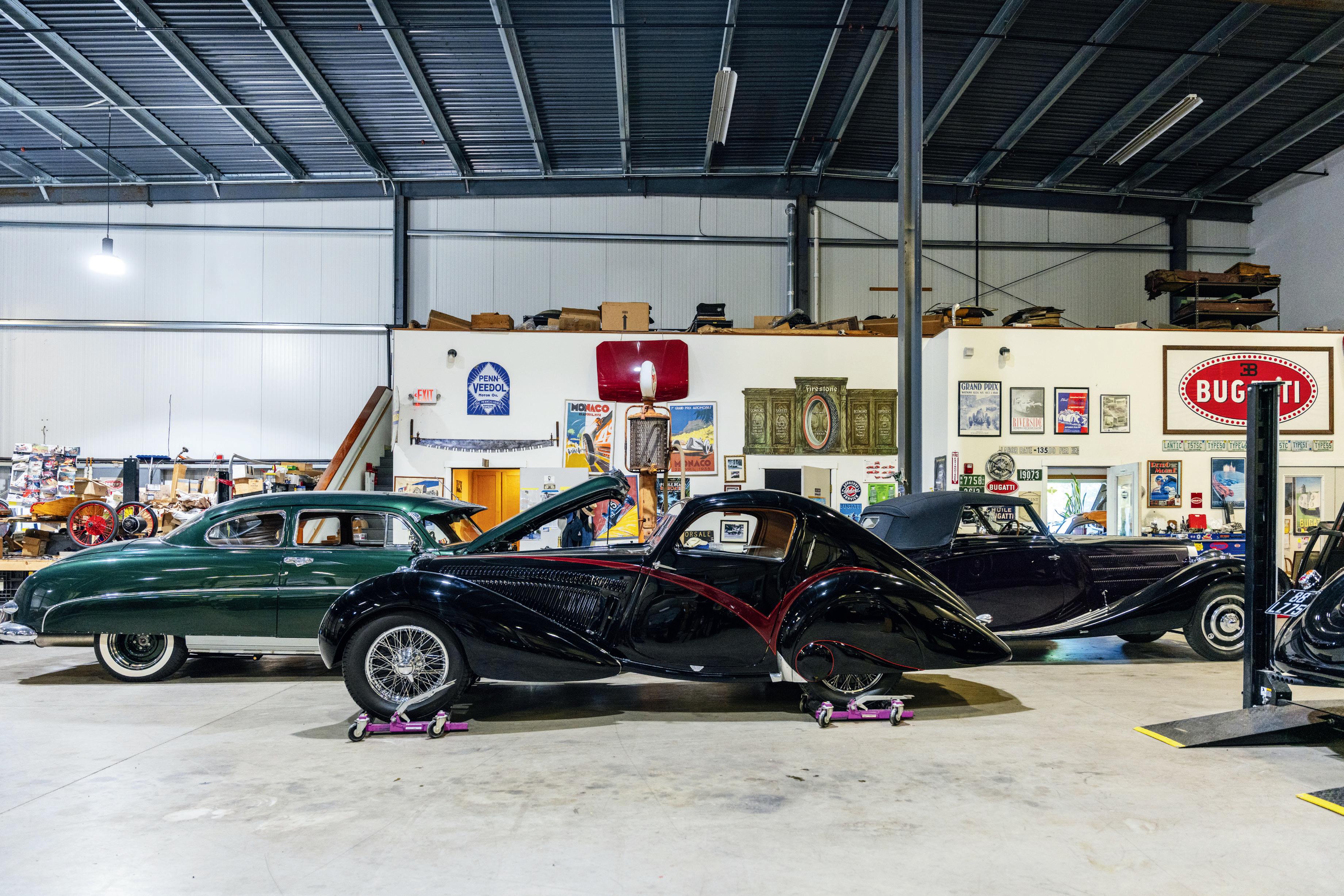
nvisioning what roads the cars might have traveled in the past, what hairpin curves they rounded, what sycamore-lined boulevards they may have cruised, and who might have loaded their luggage in them for honeymoons or holidays, adds to the thrill of driving—and restoring—them.
a man who had worked in the Surrey dealership that acquired the car in the mid 1940s. “He remembered pushing a broom around it in the showroom. And he said, yes, that was the blue.”
Sargent also hunted for parts in Paris at the Rétromobile classic car show. On one of those trips, during a Seine river cruise, he happened to meet a Bugatti company archivist who was carrying a small book containing the specs of every model, including Williamson’s Atlantic. That man confirmed that the patch of blue leather Sargent had discovered on an interior map pocket was indeed original. Sargent was then able to duplicate its exact hue
and grain. (The leather work was done by Richmond Upholstery in Richmond, Vermont, with whom Sargent works regularly.)
If he couldn’t find the components he needed, he got creative, hand-casting molds and pounding aluminum in much the same way the original makers did. He “dumbed down” modern shiny paint with thinner, then sanded and buffed the body to give it a “slightly off-gloss look.”

“My job is never to make it the most perfect car in the world,” he says. “These cars were not perfect. And I don’t want to leave my fingerprint on it. I want to preserve the fingerprints of the people who built the car.”
When the Atlantic’s exacting overhaul was complete in 2003, Williamson entered it into California’s Pebble Beach Concours d’Elegance, widely considered the world’s most prestigious auto exhibition. The annual event, attended by 15,000 spectators, culminates in the presentation of awards for style, technical merit, and restoration accuracy. The Atlantic won Best in Show.
“It was pretty mind-blowing. Confetti and cannons going off, big parties. I was floored. It was the first car I ever showed at Pebble Beach, and it basically won the world championship of automotive restoration.”
Over the years, Sargent and Williamson grew close. “He was like a dad and a brother to me all wrapped into one. We skied together. We’d get the Atlantic out and get gas at the Lyme Country Store and take it for a drive, maybe over to Wentworth (New Hampshire) and back. We drank scotch at night. It was a grand time.”
After Williamson died in 2008, his estate sold the Atlantic for more than $30 million to two buyers, one of whom was Rob Walton, heir to the Walmart fortune. Walton, now the sole owner of the car, is also Sargent’s client— and friend.
“Most of my clients do become friends,” says Sargent. “When you get into that stratosphere of people, they’re not letting you in the door if they don’t trust you. There are a lot of decisions that have to be made. They know I’m going to do the right thing for the car.”
And they also agree with Sargent that even the rarest of Bugattis are meant to be driven.
“I think it’s important to get these things out there so that people can see them and understand their history. Maybe they’ve heard about the new Bugatti supercars, but the old stuff is much more interesting,” he says.
Thousands of people turned out for the much-publicized 2018 International Bugatti Tour in Saratoga Springs, New York, during which the town’s main street was shut down for a parade of 80 vehicles. The field notably included both surviving Atlantics. Sargent drove the blue Williamson/ Walton car—which by then was valued at about $40 million—alongside the black Ralph Lauren car.
“People were screaming and jumping up and down. They knew what they were seeing. It had never happened before, to have both Atlantics driving side by side. The driver of the Lauren car and I kept looking over at each other. We knew how rare it was to be looking at one Atlantic from the driver’s seat of the other.”
Sometimes gatherings are more intimate, such as the four-day rally Sargent hosted last September for the American Bugatti Club. To kick it off, he’d welcomed his fellow members to an informal cocktail party in his garage. They’d parked their prized vehicles—most of which Sargent had worked on at some point—out front, sipped wine, commiserated over finicky starters, and admired the shop’s
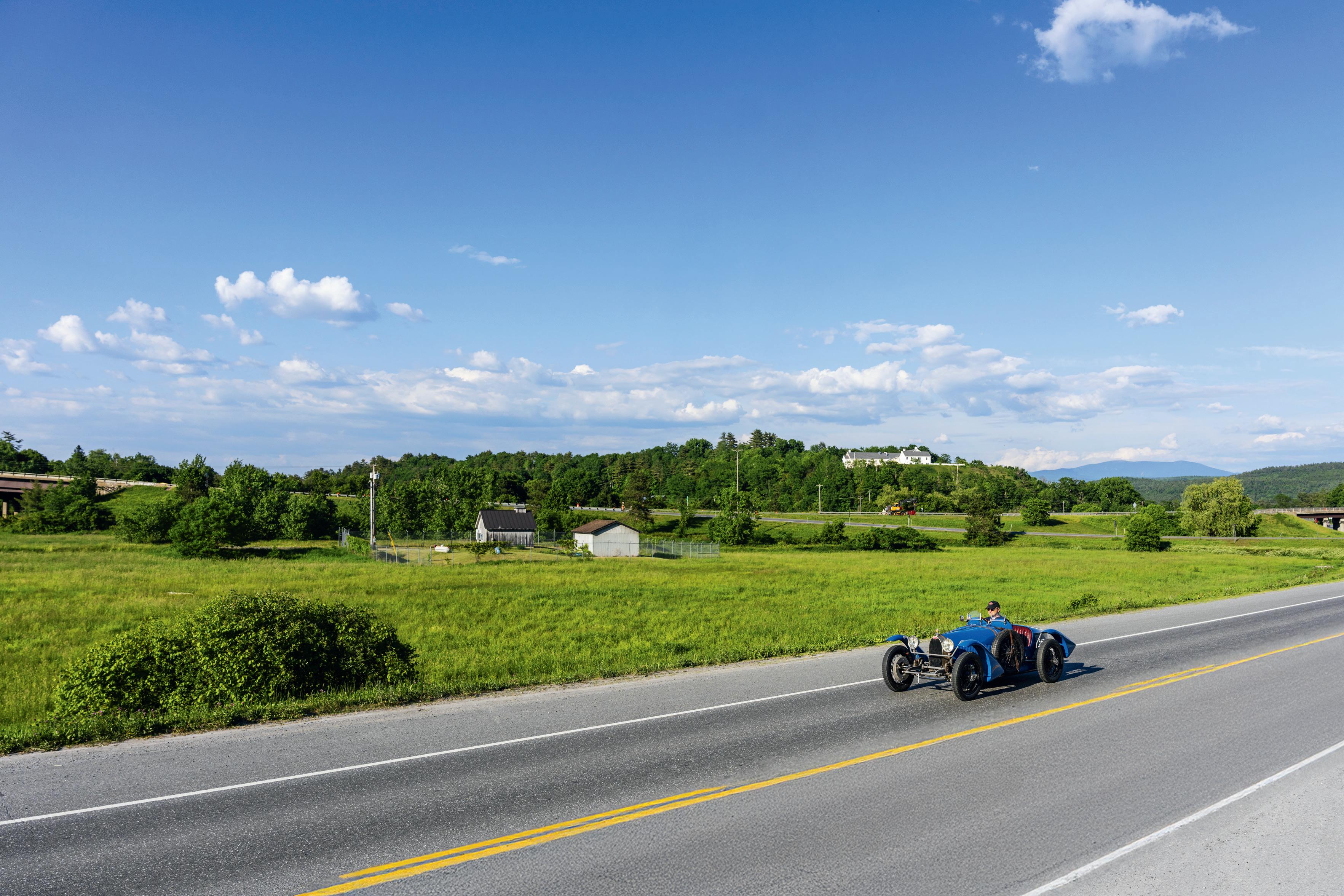
works in progress. Sargent stayed on call during the event to make sure all 18 cars started up in the morning chill and kept running through each of the 150-mile back-road days. There were no stopwatches or prizes—just the camaraderie of fellow enthusiasts.
“For most of us, the big experience is getting the car on the road … and being with other Bugattis.”
Envisioning what roads the cars might have traveled in the past, what hairpin curves they rounded, what sycamore-lined boulevards they may have cruised, and who might have loaded their luggage in them for honeymoons or holidays, adds to the thrill of driving—and restoring— them. One of Sargent’s own projects, a zippy 1930 Type 40 Grand Sport he bought six years ago, has him dreaming of the Austrian Alps.
“I know my little Bugatti was delivered to Austria. With a little more research, I can find out who it was delivered to and where they lived. I know that the Nazis got it and sold it
Sargent cruises down Route 25 near his shop in Bradford, Vermont. With its smaller, four-cylinder engine, the Bugatti Type 37 Grand Prix isn’t a supercar like the 57S, but instead was meant to be a “fun, spirited” machine, Sargent says—“something that would race the hills of Italy back in the day.”

at auction for the war effort, and I know that it came to the States in 1962,” he says. “My goal is to finish it and bring it back to Austria. I’ll probably leave it there for a year, do a few rallies. I want to drive it on the same little two-lane roads in the same villages, to put it in the same spot where it lived.”
In the meantime, Sargent continues to rack up awards at Pebble Beach. In 2023, a Bugatti Atalante coupe owned by prominent Swiss collector Fritz Burkard won first in class. (Second place went to another Sargent project.) Burkard, who has spent considerable time in Vermont, bought the car after seeing it mid-restoration at Sargent Metal Works. He was impressed with the restorer’s knowledge and integrity.
“Scott has such a good heart, on a personal level and as a craftsman. He’s honest. He doesn’t tell you bullshit,” Burkard said from his home in St. Moritz. “And he’s humble. That’s very refreshing in this world. It’s why I love to work with him and why we became friends.”
It’s a long way from the Alps and Paris and Pebble
Beach to Bradford, Vermont, a long way from DIY back yard go-karts to unparalleled show cars. Sargent is aware of how far he’s come.
“I do think about that,” he says as he walks back out onto the shop floor. “I mean, I feel like the luckiest person in the world. I love what I do. I’ve got great clients, and they have entrusted me with these great things. I love to make their cars better. But it didn’t just happen to me. It’s taken 45 years of work to get to this point. A lot of late nights, a lot of weekends.”
And a lot of belief that what he’s been doing for the past nearly half-century amounts to far more than repainting bodies and rebuilding engines.
“You know, these cars, they’re not just an assembly of parts,” he says, looking around at his charges with obvious pride. “They have a kind of soul that lives on. And it’s very clear in my mind when I’m working on them that they will outlive us all.”


Before “Don’t go in the water” first sent chills down moviegoers’ spines 50 years ago, a young Cape photographer set sail with Spielberg and company for an unforgettable day on the set of Jaws.
Back in March, Yankee received an intriguing email from Peter Vandermark, a photojournalist and retired Boston University journalism professor. He had shot hundreds of assignments over his long career, but he wanted to share the story of one in particular. ¶ On July 19, 1974, Vandermark was 26 and working for the weekly Cape Cod News when he was sent to Martha’s Vineyard for the day to photograph the filming of a movie there. He had unfettered access to the set, to the cast, and to the young director, a Hollywood upstart named Steven Spielberg. Vandermark’s photos appeared in the next week’s paper. ¶ Since then, he hasn’t published a single frame from that shoot—until now. With movie lovers around the world celebrating the 50th anniversary of Jaws this summer, we present a selection of Vandermark’s remarkable photos, along with his account of how it all unfolded.
Afriend of the editor flew us to the island, where his sports car waited to whisk us to the dock in Edgartown. The day’s shooting location was offshore, and our next ride soon arrived. The skipper turned out to be musician James Taylor’s older brother, Alex, who, like a few other islanders, had been hired by Universal Studios to ferry people and equipment from place to place. As we sped into Nantucket Sound, we could see on the horizon a small cluster of boats where we were to spend the rest of the day.
The staging area was a 65-foot tugboat named Whitefoot, and orbiting it were a number of smaller boats, including the Orca , the fishing boat central to the film. The tug was crammed to the gunwales with movie equipment and crew, and when we stepped aboard that morning, the shoot was already underway. What we were yet to realize was that they were filming what would become one of Jaws ’s most iconic sequences.
In it, the Orca is pursuing the harpooned but still fleeing shark, with Quint [Robert Shaw] standing at the end of the bow pulpit with harpoon in hand, Hooper [Richard Dreyfuss] at the helm, and Brody [Roy Scheider] on the afterdeck, holding on for the ride. The only evidence of the shark’s location is a yellow barrel racing through the water.
Coordinating these scenes on a rolling sea made for a complicated and sometimes frustrating shoot. If one ele-

ment didn’t line up, it meant starting all over. Spielberg and I were around the same age, but I remember watching him and thinking, Who is this guy? How is he running the whole show? He just seemed like he was from a different world.
When lunch was called, actors and crew were motored back to the Whitefoot just as the caterers’ boat arrived with beef stroganoff and strawberry shortcake. It felt like movie magic, floating out there in the middle of nowhere on a crowded tugboat. We ate with Spielberg, Dreyfuss, and Scheider in the tug’s galley. My most persistent memory of that time has always been Spielberg and Dreyfuss performing skits and songs from a 1960s Stan Freberg comedy album. They were a hilarious team.
Shooting continued with the same rhythm of takes and retakes until around 6 p.m., after which we flew back to the Cape. The next morning I developed my film, made prints for the story, and filed the negatives away—where they remained undisturbed until last year, when I had them scanned for a book project.
Seeing the digitally scanned images for the first time, with their surprising sharpness and tonal quality, was a thrill. I’d been assigned to shoot the making of a movie, and yet the pictures that stand out for me now are the ones of cast and crew hanging out, reading, chatting, and joking around. Those are the kinds of photos that really tell a story. —Peter Vandermark

previous spread: Steven Spielberg, far left, and the Jaws crew aboard the tugboat Whitefoot, which served as the staging area for filming off the coast of Martha’s Vineyard. As the director later told Vanity Fair, “The audience would not have connected with the movie unless it looked real, and that’s why I insisted on shooting the picture on open sea in the Atlantic Ocean.”
this page: Robert Shaw as the shark hunter Quint on the bow pulpit of the Orca. His portrayal of the cantankerous old salt was partly inspired by Vineyard local Craig Kingsbury, who also had a small role in the film.


above: Richard Dreyfuss as marine biologist Matt Hooper on the flying bridge of the Orca Before it became a Hollywood icon, the Orca was actually a lobster boat named Warlock that the production team found in Marblehead, Massachusetts.
left: Shaw in conversation with Roy Scheider, who portrays Police Chief Martin Brody, during a filming break. Though according to Vandermark this was a friendly exchange, the photo does hold a hint of Shaw’s famously intense presence on the set.
opposite, top: With Scheider reading over his shoulder, Spielberg pages through a copy of The Hollywood Reporter; it’s open to an ad touting Clint Eastwood’s recent box office success.
opposite, bottom: Shaw, Scheider, and crew chatting after lunch on the Whitefoot ’s deck.





opposite, top: Lunchtime interview with Dreyfuss, Scheider, and Spielberg. The notebook and hand of Cape Cod News reporter Laura Terrone can be seen lower left.
opposite, bottom: Dreyfuss and Scheider singing during lunch break on the Whitefoot.
this page: Spielberg reviews storyboards with Jaws script supervisor Charlsie Bryant, a veteran of such movies as The Sting and From Here to Eternity. Spielberg at the time had only one theatrical release to his name, The Sugarland Express, and by the time he wrapped Jaws—at nearly three times its original budget and shooting schedule—he feared he’d never work in Hollywood again. Instead, Jaws ended up earning more than $450 million worldwide, established the concept of the “summer blockbuster,” and put Steven Spielberg on the road to becoming one of the greatest directors of all time
To mark this milestone movie anniversary, NewEngland.com has rounded up favorite shark stories from the Yankee archives, including C.J. Chivers’s 2000 classic “Shark Teeth, Pearly White” and Ian Aldrich’s 2020 profile of Dr. Greg Skomal, “The Shark Detective.” There’s also a link to our Weekends with Yankee episode about Skomal’s shark research off Cape Cod. Find it all at: newengland.com/jaws

An enduring sense of wonder at one of summer’s most ephemeral delights.
BY SUSIE SPIKOL | PHOTO BY JAMIE MEDEIROS

iI’ve been away with the fairies this soft June night. I went willingly. I followed their glimmering lights past the spicy bee balm blooms and through a damp, tangled patch of wild mint. Across the road, in just my bare feet, I chased them into my neighbor’s field. In the dark meadow, the fairies twinkled like stars that had loosened themselves from the sky to dance upon the earth.
In my head, I knew it was only the flickering lights of fireflies, but my heart knew them as the will-o’-the-wisps, mischievous fairies who lead seekers like me astray. A story set deep in my memory, shared by my mother one June night long ago. She knew all the stories and spun them like straw into gold. There were my favorites, like the one about the winged horse, Pegasus, who sprang to life from three drops of Medusa’s blood, or her repeated warning of how I should never accept drink or food at a fairy ball unless I planned to stay for the rest of my life.
Fifty years later, in my neighbor’s field, I stand with bare feet pressed into the cooling grass, like the young girl I once was. My mother’s stories pulse in my heart like flashes of fireflies; I let the glowing lights take me away.
There are ways of knowing something, like lightning bugs. Maybe it is the stories a mother tells her daughter on a blanket under the stars of a Vermont sky. Maybe it is the time spent chasing them through tall meadow grasses to finally hold one little glowing beetle in the palm of a tiny hand. Maybe it is now how time falls away when I stand in this New Hampshire field and hold my breath as the dark meadow lights up with the sparks of these soft-bodied flying beetles. It is better than any Fourth of July. The only sounds I hear are the wild trill of gray tree frogs and my own heartbeat.
Lightning bugs, fireflies, lamplighters, fire-tails … no matter what the name is, these beetles have a magical hold on me no less strong than any will-o’-the-wisps might. Imagine making light without heat—a bioluminescent chemical reaction like a fairy tale’s magical spell to our eyes. Or how these insects, members of the Lampyridae family,
entice their lovers with glimmering winks of light and rhythm, a silent searchlight for well-matched sex. Or how firefly young start their life as glowworms, larvae that make the leafy soil twinkle like earthbound Christmas lights. In the winter, little glowworms sleep tucked away in the ground, under rocks and fallen trees. Their light flickering green, yellow, or even blue, the only light in utter darkness. In the cold of winter, when I stand on the frozen ground, I am filled with a pulse of hope and the knowledge that there is always a bit of light, even in midnight darkness.
The everyday stories of these beetles are enough to make a naturalist like me want to wander off and follow fireflies wherever they will take me.
I remember once swimming in the early summer waters of a northern Maine lake. The dark water had all the stars resting on the surface, while on the hillside down to the very shoreline, the air was filled with fireflies, flashing. My friends and I still talk about this night, as though the starlight and fireflies bewitched us to never forget what it feels like to be young, free, and so alive.
Once, even long before that, I chased fireflies down the sidewalk and back through the streets in my old Brooklyn neighborhood. The air was hot, and I can still remember the smell of the heat rising from the dark concrete. The streetlights were on, and across the tiny patches of front yards, my brother and I ran, catching enough to tangle them in my hair like I was Mab, Queen of the Fairies.
I never thought the world would run out of this magic. But I’m aware now, too aware, and with each passing summer, I notice the light is fading. The fireflies are disappearing. I worry that one summer not far from now, when I can’t sleep and step outside to wander away with the will-o’-the-wisp lightning bugs, there will be none left. It is true. One in three fireflies in North America are imperiled due to the regular roll call of problems. From habitat loss and pesticides to climate change and light pollution, these bugs, like so many other creatures of our world, are silently disappearing.
I cannot bear the thought of a world without fireflies, these bugs of brilliant light, these beings who have lived on earth longer than the first human. Then all that will be left behind are the stories of how, once upon a time, there lived a small, quiet beetle that lit our summer nights like wild fireworks and invited our imagination to dream with its silent sparks.

A chance invitation to board a Maine windjammer stirs memories of a sailing childhood long left behind.
AND

BY KATE SHAFFER

was as if the wind had been lying in wait, perhaps even stalking us all afternoon. One minute, Captain “Cap” Noah Barnes is picking softly on a mandolin at the helm, the placid blue of sea and sky shimmering behind him; the next, he is on his feet, hand on the helm, calling to his crew as the Stephen Taber ’s two enormous sails swell with a whoosh of cool air.
“Man the fores’l!” Cap shouts as the great wooden boom shifts with the wind, sending a small group of lounging shipmates scrambling out of the way. The crew of five men and women leap to the corners of the deck, loosening, pulling, and then finally tying off lines, harnessing a stiff breeze that would have us to the horizon before dinner.
It is an ungentle maelstrom of activity, and I am left slightly breathless, my pulse racing. And for this, I can’t help but feel a little ashamed.
The truth is, I have spent my whole life along the water and around boats, but I am not a sailor. I even spent 15 years living on one of Maine’s outer islands, where nearly the entire population is employed on boats—where the only way on and off of the island is by boat—and yet I managed to not once stern, or crew, or even tie a half hitch to the town dock. If someone had the bad judgment to throw me a line, indeed I would not have known what to do with it.
But it wasn’t always this way.
I grew up the daughter of a sailor. Not the kind trained by the navy, nor one of the well-heeled yacht set, but a former
Girl Scout who learned to sail small boats on the lakes and ponds of upstate New York. Likewise, my siblings and I learned to sail as soon as we could swim. My mother taught us on a light, one-person boat that she—with just the help of one of her three kids—could lift onto the roof of the family station wagon. We spent our summers exploring the mountain lakes of California, and learned to rig the rainbowsailed Minifish (a diminutive version of the Sunfish) and how to sail it in pairs or alone.
My mother loved to sail, and for me, her joy on the water was as irresistible as birthday cake—a special treat you didn’t want to miss. Life at home wasn’t easy, and the mother I knew within those walls was very different from the woman on our bright little boat, one hand on the tiller, the other gently guiding the sail, face browned and beaming in the sunshine. For this reason, more than the desire to actually learn to sail, I was her dedicated student. I was in the thrall of that joy. And the memory of it has stayed with me all these years, long after those sailing lessons faded away.
I have been a guest on the Stephen Taber, one of nine sailing vessels in the Maine Windjammer Association fleet, once before. In 2019, owners Noah and Jane Barnes had a sudden vacancy in a single cabin due to a late cancellation. At the time, I had been writing a cookbook about farmto-table food in Maine, and the trip was an opportunity to experience one of the boat’s themed “gastronomy cruises.”
When I walked off the Taber five days later, I felt not the remembered pleasure of the seemingly endless menu of stunning meals, but rather the gripping impulse of so many sailors before me; I wanted nothing more than to run away to sea, and never come back.
So when Jane asked me to join them as a presenter on their five-day “Wine, Dine & Chocolate” cruise in July 2023, I didn’t even have to think about it. “I’m in!” I shot back before I’d even finished reading her email. I would gladly trade my handmade chocolates and guide their guests through chocolate tastings in order to again experience a few days aboard the Taber. And I was happy to be of any help I could to their new chef, who had the task of weaving chocolate throughout both the sweet and savory dishes that would define the trip.
Work has often served as my entry ticket to adventures and experiences for which I might not normally have the time or the budget. But in this case, it was also an opportunity to investigate just what it was about sailing and boats that so enchanted me. I longed for the feel of the wooden deck on my bare feet, the stickiness of salt air on my skin, and the endless days spent drifting in Penobscot Bay’s finicky summer winds.
(Continued on p. 110)

this



























Quarry Hill offers it all: a gracious, maintenance-free home with easy one-floor living and priority access to the fullest spectrum of care.
Enjoy all the beauty and cultural sophistication of Camden, Maine and discover your best future.



(Continued from p. 41)
Then, make the salad: In a large bowl, combine the olive oil, vinegar, ¼ cup pesto, 1 teaspoon salt, and ½ teaspoon pepper. Stir in the tomatoes, cucumbers, mozzarella, and nuts. Season to taste with salt and pepper.
Cover and cook on low heat until they are tender and a fork can easily pierce the meat, 6 to 7 hours.
Line a sheet pan with aluminum foil. Transfer the ribs to the sheet pan and season all over with 1 teaspoon salt and ½ teaspoon pepper. Arrange the ribs in a single layer with the meaty side up.






207-301-6116 quarryhill.org


Finding the right fit is everything.
Slice the racks of lamb into individual chops. Serve the lamb and salad with the remaining pesto alongside for drizzling. Yields 4 to 6 servings.
Babs writes: “Ribs present one of the greatest effort-to-reward ratios I know! They are so fun to eat, and you have to do so little to prep them. Steaming the ribs with sauce in the slow cooker for 6 to 7 hours ensures they’re super tender. Then a quick trip under the broiler gives them the perfect char. These have a sweet-and-sour, Asianinspired glaze of sweet chili sauce, brown sugar, soy sauce, rice vinegar, and ginger.” She says she serves this dish with a quick cucumber pickle: “Dice your cucumbers, stir in a little rice wine vinegar, a pinch of salt, a pinch of sugar, a little toasted sesame oil, and some sesame seeds.”
Carefully spoon off and discard as much fat as possible from the top of the cooking liquid in the slow cooker. Transfer the cooking liquid to a saucepan and simmer uncovered over high heat until syrupy and reduced by half (to about 1 cup), 10 to 15 minutes.
Arrange a rack in the upper third of the oven and switch the oven to broil. Brush the ribs with half the sauce and broil on the top rack until charred in spots, 4 to 5 minutes. Top with the cilantro, scallions, and sesame seeds as you like, then serve with rice and extra sauce on the side. Yields 4 to 6 servings.


Explore the possibilities in Retiring to the Good Life, a guide that introduces readers to select New England retirement communities — each offering a unique opportunity to start your new chapter in a region filled with arts, culture, and outdoor activities. Read or Download Now!
½ cup Thai sweet chili sauce
¼ cup packed brown sugar
¼ cup soy sauce
3 tablespoons unseasoned rice wine vinegar
1 tablespoon grated fresh ginger 4–5 pounds St. Louis–style pork spareribs, cut into individual ribs
Kosher salt and freshly ground black pepper
Fresh cilantro leaves, thinly sliced scallions, and/or toasted sesame seeds, and steamed jasmine or sushi rice, for serving
In a 5-to-8-quart slow cooker, combine the chili sauce, brown sugar, soy sauce, vinegar, and ginger.
Season the ribs with 1 teaspoon salt and ½ teaspoon pepper. Add them to the slow cooker and stir to combine.
Babs writes: “I like to end a big meal with something a little lighter—in this case, fresh strawberries. This sheet pan dessert brings some ease to the beloved strawberry shortcake. You bake one big, brown sugary biscuit on a sheet pan, then pile it with whipped cream and strawberries. The strawberries are macerated in sugar and vanilla, so they taste like their best selves even when they’re not in season.”
Note: You can swap the strawberries for other berries, peaches, or nectarines, as you wish. For even less work, use store-bought biscuit dough in place of the homemade dough.
FOR THE SHORTCAKE
3 cups (385 grams) all-purpose flour, plus more for rolling ¼ cup (50 grams) light brown sugar
4 teaspoons baking powder
1 teaspoon baking soda
1½ teaspoons kosher salt
8 tablespoons (1 stick) unsalted butter, cold, cut into ½-inch pieces





An evening. Yes, an evening with white linen tablecloths, waiters with bow ties, waiters that know the food and cooking times and tenderness. The sommelier who pours the wine and spent two years in France studying grapes and vineyards and can answer all aspects of the wine you have chosen. Your dinner partner, who dines here several times a year, was surprised when he turned a fork over and saw that it was stamped “Sterling Silver” with English hallmarks. You were surprised that he didn’t know because he’s always so thorough. After dinner and dessert he takes you on a walk through the garden where you have another glass of wine and mingle with the guests.
This ring is called The Goddess. It’s a rare pink Maine tourmaline found a half-century ago, seventy-five miles north of Portland, Maine in America’s largest find of gem tourmaline. These pink gems exist today only because Cross bought them all years ago. Yes, we acted like crazy people, buying because we know gem finds don’t last forever. We show seventy-five rare pink Maine tourmaline on our website. All oneof-a-kind pieces. No tariffs ever.
Shipping is always Safe, Fast and FREE
Anywhere USA
½ cup well-shaken buttermilk
½ cup plus 2 tablespoons heavy cream, plus more if needed
1 tablespoon granulated sugar
FOR THE TOPPING
1½ pounds fresh strawberries, hulled and sliced
2 tablespoons plus 1 teaspoon granulated sugar
2 teaspoons fresh lemon juice
3 teaspoons vanilla extract
1½ cups heavy cream
First, prepare the shortcake: Arrange a rack in the center of the oven and preheat the oven to 400°F. Line a sheet pan with parchment paper.
In a large bowl, stir together the flour, brown sugar, baking powder, baking soda, and salt. Add the butter and use your hands to toss it in the flour to coat. Use your fingers to mash each piece of butter into a flat piece, tossing it in flour as you go. Aim for pieces around the size of a nickel.
Make a well in the center of the flour mixture and pour in the buttermilk and ½ cup cream. Stir gently until just combined, with a few dry spots remaining. Use your hands to fold the dough over itself in the bowl a few times, until the dough is evenly moistened, but be careful not to overwork it. The dough should just hold together and should not be crumbly. There should still be visible
pieces of butter. This may require adding another tablespoon or two of cream. Turn out the dough onto the sheet pan and sprinkle a bit of flour over the top. Use your hands or a rolling pin to press or roll the dough into a rough oval ½ inch thick. (If the dough seems at all warm or the butter is very soft, refrigerate for 10 minutes.) Brush off any excess flour, then brush with the remaining 2 tablespoons cream and sprinkle with the granulated sugar.
Bake the shortcake until golden brown and crisp at the edges, 12 to 15 minutes. Let cool completely on the pan.
Then, prepare the strawberries: In a large bowl, stir together the strawberries, 2 tablespoons of the granulated sugar, the lemon juice, and 1 teaspoon of the vanilla. Cover with a clean kitchen towel and let macerate briefly, stirring the mixture occasionally until ready to serve.
When ready to serve, whip the cream: In a medium bowl, combine the cream and the remaining 1 teaspoon granulated sugar and 2 teaspoons vanilla. Use an electric hand mixer or whisk to beat the mixture to medium peaks.
Transfer the shortcake to a serving platter (or leave on the sheet pan!). Top with swoops of whipped cream, then carefully spoon the strawberries and their juices over the cream. Slice with a serrated bread knife and serve immediately. Yields 12 servings.






















































(Continued from p. 56)
along with the ramblers that adorn arches spanning garden paths radiating from a central gazebo. The arch roses, often a wedding-photo staple, are in bloom for only a few weeks in June and July; many others bloom into autumn. elizabethparkct.org
LOUIS’ LUNCH, New Haven. Frankfurters are from Frankfurt, but hamburgers … aren’t from Hamburg. They’re from New Haven, where they were invented (says the Library of Congress) by Louis Lassen in 1900. Lassen’s stroke of genius was to tuck a beef patty between two slices of toast for a hurried customer. Four generations of Lassens later, burgers cooked in a vertical broiler of great antiquity are served the same way, garnished only— only —with cheese, tomato, and onion. louislunch.com
PEZ VISITOR CENTER, Orange. What do Marilyn Monroe, Harry Potter, Donald Duck, and the space shuttle have in common? They’ve all been modeled as dispensers for the little candy bricks called Pez. Invented in Austria in 1927 (the name comes from “pfefferminz,” German for “peppermint”), the candies first popped out of their little mechanical boxes in 1949. More than 1,000 designs later, the dispensers are a chronicle of pop culture, on view here along with a peek at t he Pez production area. pez.com
DESERT OF MAINE, Freeport. In a state famous for its pine forests and rockbound coast, what could stand out more than a 20-acre desert? Freeport’s glacial-era sand once lay beneath topsoil that was stripped away by poor farming practices and overgrazing, revealing the makings of a now-century-old tourist attraction that’s grown to include a farmhouse museum, a train ride, mini golf, glamping, and the chance to conjure a bit of Lawrence of Arabia. desertofmaine.com
EARTHA, Yarmouth. With a diameter of more than 41 feet and an 18-minute rotation cycle, Eartha is the world’s largest rotating and revolving globe. Spectacularly detailed via the use of satellite imagery and colorshaded representation of ocean depths, the vast orb revolves in the atrium of the former headquarters of the DeLorme Mapping Company, now part of Garmin. During business hours, visitors can circle the planet at floor or balcony level. Illuminated at night, it’s visible from Route 1. Open weekdays 9 a.m.–3 p.m.; 2 DeLorme Drive
MAINE SOLAR SYSTEM MODEL, Presque Isle (and beyond). New England’s largest state can afford the space … for space. The University of Maine has created a model of the solar system that stretches for nearly 100 miles along Route 1, from the Presque
Isle campus to Topsfield. Starting with the sun and extending to the dwarf planet Eris, the three-dimensional models stand at scale-appropriate distances; look for Earth at Percy’s Auto Sales on the outskirts of Presque Isle. mainesolarsystem.com
MAINE STATE PRISON SHOWROOM, Thomaston. The shop at Thomaston features over 600 prisoner-crafted products, including kitchenware such as cutting boards and charcuterie boards, wooden toys, casual furniture, decorative chests and boxes, and—though there’s no such Pine Tree State prison—travel mugs bearing the “Shawshank” name. Facebook
PENOBSCOT NARROWS BRIDGE AND OBSERVATORY, Prospect. Opened in 2006, the 2,120-foot span across the lower Penobscot is doubly distinctive: It’s one of only two in the U.S. built with cable stays that carry the deck without anchorage in the pylons, and, atop the 420-foot west tower, the world’s tallest public bridge observatory offers 360-degree views reaching from Maine’s western mountains to Penobscot Bay and Islesboro at the river’s mouth. Adjacent is massive granite Fort Knox, one of the bestpreserved military fortifications on the New England coast, completed in 1869. maine.gov/mdot/pnbo
PERRY’S NUT HOUSE, Belfast. A night in a motel always goes down better with a movie, a favorite beverage … and a bag of cashews. Perry’s has spent almost a century supplying travelers with that indispensable last item plus peanuts, pecans, pistachios, and just about every nut combo ever devised, along with fudge, handmade chocolates, trail mix, and much more. All this, plus a museum of oddities such as a mounted gorilla and a preserved alligator hide. perrysnuthouse.com

Boston, MA
BRIDGE OF FLOWERS, Shelburne Falls. What to do with a streetcar bridge when the last streetcar has run? Shelburne Falls faced that question in 1927—but just two years later, a volunteer team of gardeners turned the weedy, derelict span into a horticultural showpiece. With a pedestrian pathway extending the length of the bridge and lined with plantings that bloom from April to November, the Bridge of Flowers is a colorful master class in adaptive reuse. (Note: Closed for renovations since last June, the bridge is scheduled to reopen this year. Check the website for updates.)
bridgeofflowersmass.com
DR. SEUSS NATIONAL MEMORIAL
SCULPTURE GARDEN, Springfield. Horton, the Lorax, and Cindy Lou Who / The Cat in the Hat, with his Things One and Two /




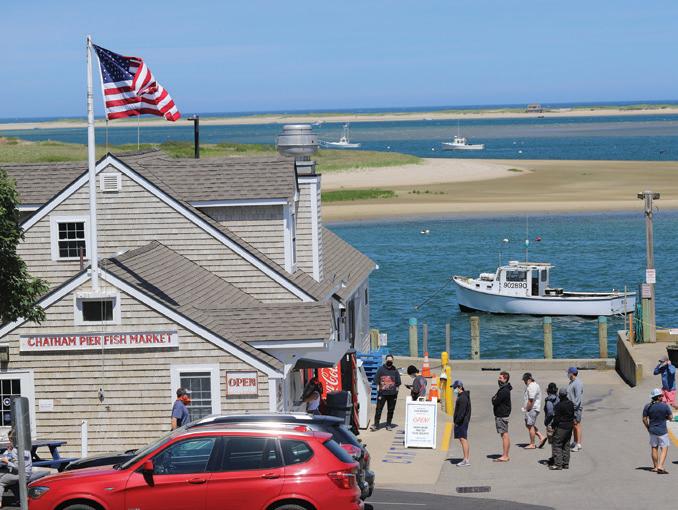





They’re all here in Springfield, home of their creator / And you simply must see them, sooner or later. Theodor Geisel, aka Dr. Seuss, grew up in this western Massachusetts city, where a bronze bevy of his characters graces a quadrangle adjacent to the Amazing World of Dr. Seuss Museum. springfieldmuseums.org
EDWARD GOREY HOUSE, Yarmouth Port. It doesn’t look all that macabre—just another Cape Cod sea captain’s house. But its late owner, Edward Gorey, was a master of whimsically creepy stories illustrated in a Gothic minimalist style all his own. Gorey’s residence from 1979 until his death in 2000, the 200-year-old home is preserved as a museum dedicated to his life and work. Special events are planned
was then: U.S.S.R., Siam, and all. Tours of the globe include a sound and light show with narration, and the attraction is part of a larger “How Do You See the World?” experience. marybakereddylibrary.org/ project/mapparium
PONYHENGE, Lincoln. Lincoln isn’t Massachusetts’s horsiest area—that honor goes to the North Shore, with its “fox” hunt and polo field. But out here on Old Sudbury Road, a special kind of equine has been proliferating since 2010. That was the year when someone placed a retired rocking horse in an idle pasture, starting a mysterious roundup of as many as 50 of the sprightly creatures. They’re frequently rearranged … or, maybe late at night, they rearrange themselves. 47 Old Sudbury Road

Animals Topiary Garden, Portsmouth, RI
for this year’s centennial of his birth, and the bookstore features Gorey titles and merchandise. edwardgoreyhouse.org
MAGIC WINGS BUTTERFLY CONSERVATORY & GARDENS, South Deerfield. It’s as if a fifth of an equatorial acre has been whisked away to the Pioneer Valley, and preserved alive under glass: orchids, a koi pond, Akbar the parrot, and over 4,000 gorgeous butterflies. Some 45 species of colorful Lepidoptera flutter freely in a bright enclosure teeming with tropical plants that reach to the ceiling. magicwings.com
MAPPARIUM, Boston. For a look at the world from the inside out, head to the Christian Science Plaza and its Mapparium, a threestory stained glass globe bisected by an equator-level interior walkway. Created in 1935, the vast globe shows the world as it
ALBACORE PARK, Portsmouth. Resembling an enormous tuna somehow beached on Portsmouth’s shoreline, the appropriately named USS Albacore represents a revolution in submarine design. Launched at the Portsmouth Naval Shipyard in 1953 and brought back home in 1984, this research sub proved the value of its plump, fishy hull over older designs shaped mainly for surface operations. A self-guided tour takes visitors through tight quarters where more than 50 sailors once lived for weeks at a time. ussalbacore.org
AMERICA’S STONEHENGE, Salem. Did ancient Phoenicians or medieval Celts visit New Hampshire? Did they erect the warren of stone walls and chambers clustered
mysteriously on these 30 acres? Did they leave inscriptions in half-forgotten alphabets? Or are we looking at the work of Native Americans, known to have lived here four millennia ago? Do the stones form an accurate astronomical calendar? Visitors following a half-mile trail on self-guided tours will have to decide for themselves. stonehengeusa.com
REDSTONE ROCKET, Warren. A legendary military retiree and veteran of the U.S. space program stands tall—73 feet tall—on tiny Warren’s village green. It’s a Redstone rocket, similar to those that once carried nuclear warheads, launched America’s first satellite, and powered New Hampshire–born Alan Shepard on his 1961 suborbital flight. Salvaged from a rocket graveyard at Alabama’s Redstone Arsenal in 1971, it was hauled here by a Warren native stationed at the arsenal. 112 Water St.
RUGGLES MINE, Grafton. Back in the early 1800s, a Boston entrepreneur named Sam Ruggles established a mica mine in west central New Hampshire. Over the years, the open-pit operation also yielded feldspar, beryl, and semiprecious garnets and amethysts. Mining here ceased long ago, but the site has kept its attraction for amateur prospectors. For the price of admission, visitors can haul away a five-gallon bucket of rocks and minerals. Campsites are available for those who want to try again tomorrow. rugglesmine.net
SANTA’S VILLAGE, Jefferson. Santa’s too big a guy to fit into one month, so he’s inspired a whole village—actually, an entire amusement park—north of the White Mountains. He’s here for photo ops at his home, and presides over a parkwide search for elves, a blacksmith shop making rings for little fingers, a barn where kids can feed reindeer, a water park, and lots more. Rides include a monorail, train, carousel, and the new Midnight Flyer roller coaster. santasvillage.com
STORY LAND, Glen. As the song says, fairy tales can come true. It’s happened for kids and the young at heart for over 70 years at this amusement park tucked between North Conway and Mount Washington. After breakfast with characters—and before tea with Cinderella—take a spin in Alice in Wonderland teacups, sail with Peter Pan, ride a kid-friendly coaster and an antique carousel, and get wet on a water chute … or wetter at the Moo Lagoon water park. storylandnh.com
FLYING HORSE CAROUSEL, Watch Hill Most carousel horses go up and down, but the ones at this seaside merry-goround prefer centrifugal force. America’s oldest operating carousel featuring ponies



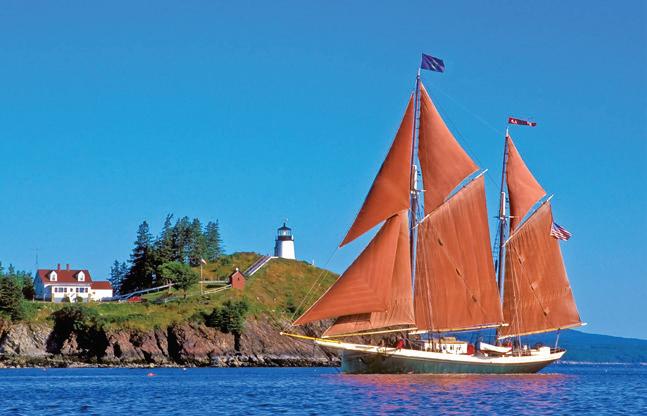





suspended from chains has delighted children (riders must be 12 or younger) since 1883, when it was abandoned here by a traveling carnival. The 20 hand-carved steeds “fly” outward as they accelerate, giving riders a chance to snatch the brass ring for a free ride. merrygoroundbeach.com
GREEN ANIMALS TOPIARY GARDEN, Portsmouth. How do you groom a centuryold giraffe? With an old-fashioned hedge clipper and lots of patient hand labor, same as you would for all the other creatures fashioned out of living privet, boxwood, and yew at America’s oldest topiary garden. Bears, an elephant, a lion, and a camel are among 80 meticulously pruned denizens of the seven-acre property that includes colorful annual gardens, a magnolia arbor, and vistas of Narragansett Bay. newportmansions.org
OLD STONE MILL, Newport. Few of New England’s venerable structures have inspired as much controversy as this eight-arched, rough stone tower in Touro Park. It was long known as the Viking Tower, thanks to a Danish professor’s 1837 assertion that it was built by Norsemen. That theory fit the era’s Vinland mania— but carbon dating suggests a less romantic origin. The tower was likely a mill built in the 1600s by Rhode Island Governor Benedict Arnold, ancestor of that Benedict Arnold. 5 Touro Park St. W. SMITH’S CASTLE, North Kingstown. British colonist Richard Smith came to Rhode Island around 1637 and set up a trading post near Wickford Cove. His fortified house, in those dangerous days, became known as his “castle,” and his heirs later made it the center of a 3,000-acre plantation. The present castle is a handsomely preserved 1678 home with a massive kitchen hearth, wide-planked floors, and agedarkened beams, filled with fine 17th- and 18th-century furnishings. smithscastle.org
SPRING LAKE ARCADE, Burrillville. Just in case the mint stops making pennies, save a few rolls and head for the nation’s oldest penny arcade. Since 1931, this temple of coin-fed fun has been a happy adjunct to the beach and paddleboat scene at Spring Lake, and, yes, it still does feature games that cost one cent. Those would be the oldest of a century’s worth of arcade games, including Skee-ball, exasperating “Steam Shovel” toy pickups, and a veritable Smithsonian of pinball. springlakearcade.com
CHAZY FOSSIL REEF, Isle La Motte. The world’s oldest fossil reef stands high and dry on an island in Lake Champlain. Four hundred and fifty million years ago, Isle
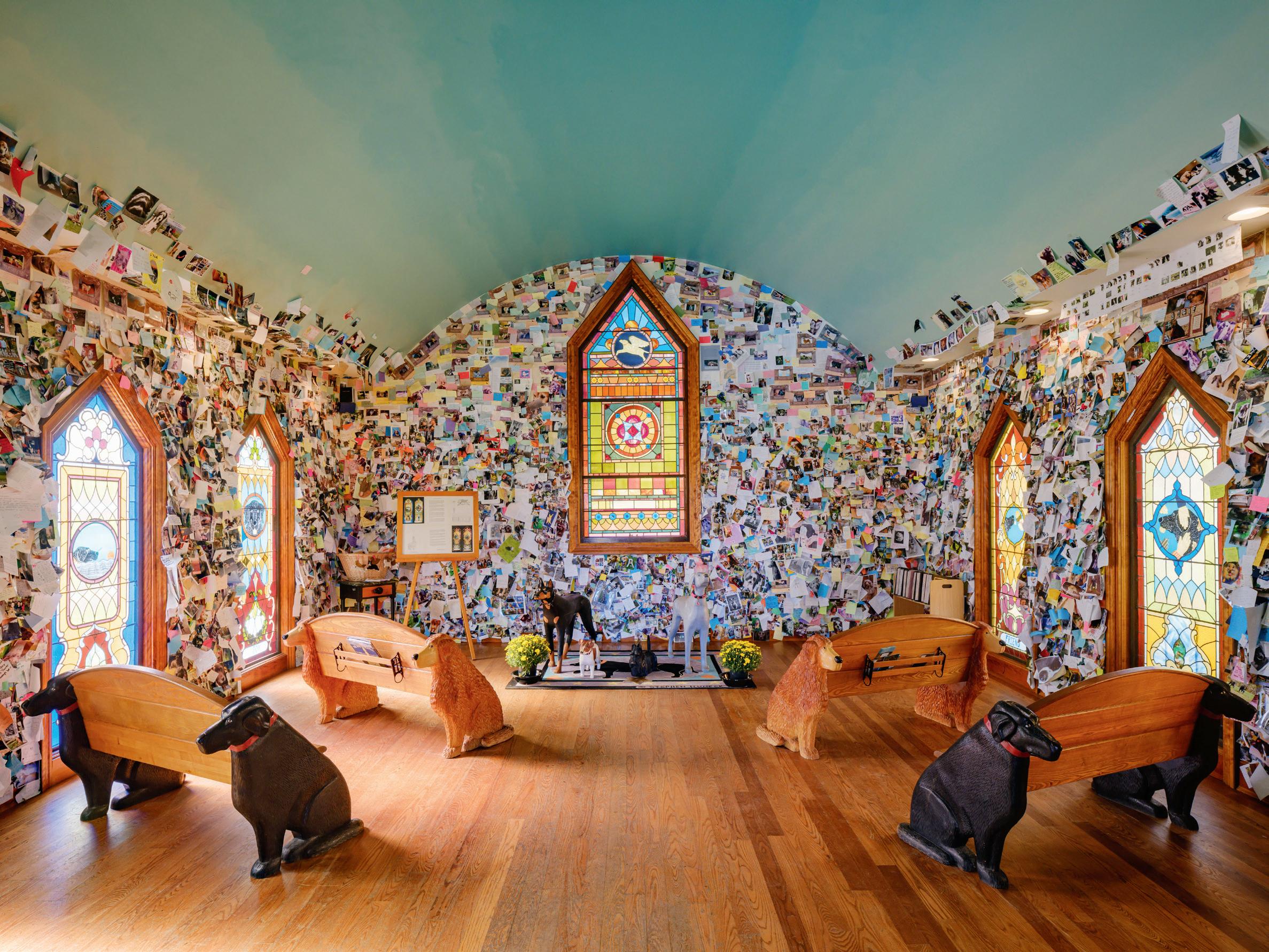
La Motte, like the rest of the Champlain Islands—and all of Vermont—lay thousands of miles to the southeast, beneath warm Ordovician waters. The tropical sea was home to now-extinct gastropods, sponges, and other primitive marine species, visible today as fossils embedded in limestone at two island locations. ilmpt.org/wp/preserves-2
DOG CHAPEL, St. Johnsbury. Anyone who has seen Stephen Huneck’s books and woodcut prints featuring his black Lab, Sally, knows that the late artist adored dogs. The central feature of Dog Mountain, the 150-acre canine playland he created, is the Dog Chapel—a place where carved dogs anchor the pews, dogs grace stained glass windows, a leaping lab with golden wings tops a pedestal, and visitors paper every wall with photos of departed fur friends. A sign at the entrance says it all: “All Creeds – All Breeds – No Dogmas Allowed.” dogmt.com
HOPE CEMETERY, Barre. A biplane. A race car. A cello. An angel, lost in thought. All attest to the remarkable skill of generations of granite carvers, who worked in the stone called Barre Gray. The monuments in Hope Cemetery were largely the work of Italian craftsmen, who memorialized themselves and their friends. Of all their realistic portrayals, perhaps the most
touching is the sculpture of a pensive Elia Corti, a sculptor and socialist activist shot by an assassin in 1903. 201 Maple Ave. MINIATURE STONE CASTLES, South Hero Vermont is short on castles—unless you count the dollhouse-sized stone whimsies that dot the southernmost of the Champlain Islands. Built in the mid-1900s by Swiss immigrant and local jack-of-all-trades Harry Barber, they’re scattered among private lawns but are mostly visible to passersby. Bicycling the flat South Hero landscape is a great way to go “castle collecting,” along a route that takes in South Street, West Shore Road, and Lakeview Road.
ROBERT FROST INTERPRETIVE TRAIL, Ripton. For more than 40 years, Robert Frost taught at Middlebury College’s Bread Loaf School of English, and summered at a nearby cabin from 1939 until his death in 1963. One of America’s early poet laureates—and Vermont’s first—is commemorated at a 1.2-milelong interpretive trail within the Green Mountain National Forest, just off Route 125. The accessible trail traverses a hemlock grove and wildflower meadows, and several of Frost’s best-loved poems are posted along the way. trailfinder.info/trails/ trail/robert-frost-interpretive-trail






(Continued from p. 96)
“Two pumps to fill the bowl. Two pumps to flush.” Cap is demonstrating the use of the ship’s head to a rapt gathering of perfect strangers. There are 27 of us, including the six crew, and we will be sharing a grand total of two toilets for four nights and five days. To the credit of Noah and his crew, the two bathrooms are pristine—even cozy—with a bouquet of garden flowers in each sill of their tiny windows. But I steal a glance at the faces of my shipmates, and I recognize the look of apprehension on some. I imagine the vacations that will be made or broken by their experience with the minimal facilities aboard this 19th-century boat. But over the next five days my shipmates surprise me, embracing life on board with frank and open good humor.
“When I was 16, I took an Outward Bound trip to learn to sail,” says New Hampshire resident Naomi Praul, referring to the famously primitive outdoor education program for teens. “There wasn’t a lick of wind the entire trip, so we never actually got to sail. But I did learn to relieve myself off the side of a boat, and that I could go a week without a shower.”
Naomi, who is accompanied on the Taber by her own 16-year-old daughter, is hoping that she’ll get to do a few things on this trip that she never did on that ill-fated sailing trip as a teenager. “I want to haul a sail and jump into the ocean,” she tells me. She confides, too, her wish that this time aboard the Taber might spark her daughter’s interest in

My mother loved to sail, and for me, her joy on the water was as irresistible as birthday cake—a special treat you didn’t want to miss.
an Outward Bound trip of her own. (Admittedly, life aboard the Taber —two toilets notwithstanding—is far from primitive. Naomi confesses that the promise of lush meals prepared by a skilled chef sealed the deal.)
Over four days, chef Jason Mathiason feeds us a wineand-chocolate-themed menu from dawn until dusk. Dinners begin with appetizer boards heaped with local and imported cheeses, house-made pickles and duck prosciutto, Marcona almonds, and a rotating selection of local honey and preserves. Jason prepares meals like coq au vin and eggs Benedict on the 100-year-old Clarion wood-fired cookstove in the below-deck galley. He presents it all with shy composure and a modesty that is at odds with his skill: “Tonight I’ve made a pork ragù lasagna,” he informs his guests one evening, but this barely begins to describe what is in fact an elegantly layered dish of hand-rolled cocoa-imbued pasta filled with a melting braise of pork and wine.
After dinner on our first night, Naomi and I don bathing suits and leap from the gunwales into the frigid bay. It is an act of solidarity in support of those friendships that exist only in the span of time we are fellow travelers—and I am happy for my shipmate when she emerges from the sea laughing and beaming like the teenager she is reclaiming. But in truth, I am overcome with my own visceral memories of afternoons on a still mountain lake, jumping again and again from the white deck of our little boat while my mother contentedly tacks to and fro, waiting for the breeze.
Among her lessons were the ways to recognize the wind before it reached us. In a boat as small as ours, responsive even to the slightest breeze, this was doubly important. Even a moderate gust could topple us if we were caught unawares. My mom would guide my eye to the seemingly invisible wind, appearing as a skirt of glittering blue sequins gathered against the lake’s satin calm. She taught me to take the sail, the sheet loose in my hands, and let the wind come. Then, when it was fully upon us, I’d rein in the sail as much as we dared—leaning our whole bodies against the wind—and race that little boat back to shore. We would arrive breathless and victorious, pulling up the centerboard as we glided into the shallows and slid gracefully onto the sandy beach.
The second morning aboard the Taber, after a breakfast of Dutch babies the size of hubcaps, we gather to sail off the anchor—a maneuver choreographed by captain and crew, in which the sails are set and the anchor pulled as we swing into the wind. It is an aerobic and all-consuming exercise, so that when it is done, our only hint as to the magnitude of our accomplishment is in the look of pride on our captain’s face.


















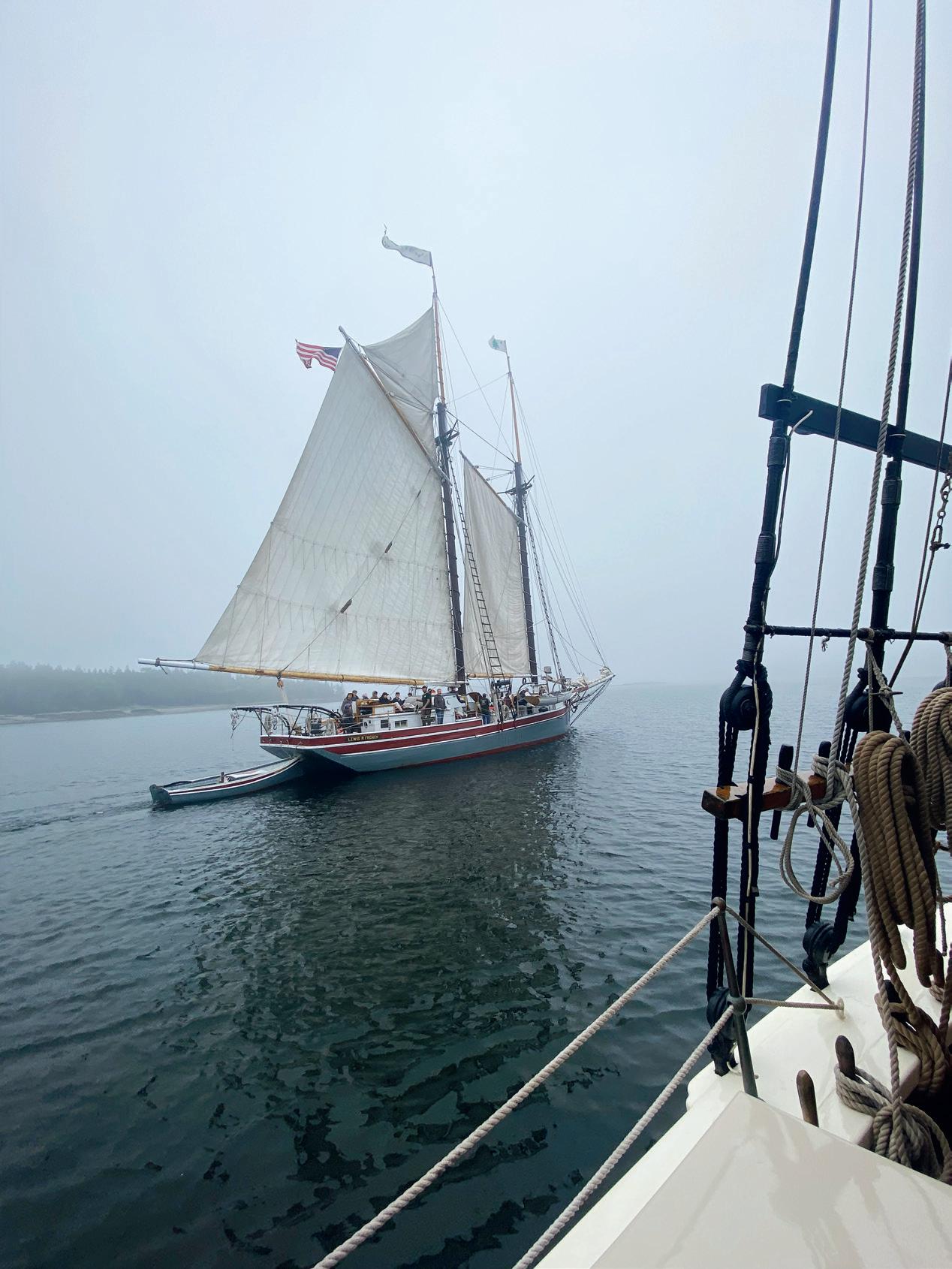
have at last a crystal-clear day, revealing a bay of sprucestudded islands. The white sails rustle in the finicky breeze, as if testing their beauty against the blue sky. Cap is at the helm, resplendent in a white button-down and ruddy from the sun. There are porpoises! There are seals! There are lighthouses! He points these out to us, joyous as a child.
We float through an afternoon of dazzling sun-soaked views, lazing in small groups on deck, chatting or reading or napping. Cap is playing his mandolin, occasionally consulting a map with his first mate, Will, or discussing that night ’s cheese board with Jason. I am lulled by the calm and the view, until I hear a shout from the helm: “Man the fores’l!”
For Cap, who has been tracking the wind on the water for the past 15 minutes, it is a joyful cry. But I hear only the urgency, the tone of it blowing me back through the decades until I am again on an alpine lake, as wide and blue as the bay, sailing alone in the afternoon calm.
I am celebrating my first summer of solo sailing by venturing out farther and farther each day, and that afternoon I glide lazily across the center of a vast placid lake, lounging with my feet up on the deck, mainsheet held loosely, poking the tiller every so often with a finger.
I don’t see the wind until it is in the sail, ripping the sheet through my soft hand, the boom swinging wildly away. I manage to catch the line just as the knotted end reaches my fingers, and I let go of the tiller so that I can concen-
trate on reining in the sail. With the rudder freed, the boat spins drunkenly in what has become a rough eddy of wind and hail. Still, having managed to grasp both sheet and tiller, I struggle to harness the wind. And I do—but at barely 100 pounds, I am no match for the summer squall. In less than a minute the boat and I succumb, and as it topples, I am thrown from the far side of the hull atop the swamped sail.
Just as quickly as the wind comes, it leaves. An unwelcome, blustery guest; short-lived, and embarrassing. I am unable to right my capsized boat, the rainbow sail heavy and rippling just below the surface of the lake, mocking me like some giant aquatic clown.
By the time help comes in the form of a good Samaritan on a catamaran, I am wrinkled and shivering. My mom is aboard, nearly rabid with panic, and wraps me roughly in a thick towel until I can barely move.
The next morning she hands me my life jacket and tells me to take the boat out. It is not a suggestion, and I don’t bother to argue. I go for a short, conciliatory sail. Then I never sail alone again.
Perhaps it would have happened anyway. I was a few months shy of my 13th birthday, and my interests were changing. But after that summer, sailing and I parted company for good.
My mother, on the other hand, sailed our little boat until just a few a years ago. At 80, she was finally unable to wrestle it onto the top of her car on her own. And though she has since traded the Minifish for a kayak, she is, in my mind, forever a sailor.
With the breeze, the late afternoon on Penobscot Bay has cooled dramatically, and I am wrapped in a fleece blanket, watching our captain guide his ship toward our evening anchorage. He is a vision of joy, as are the passengers around me. We are sailing; this is what we are here for. But for me, I know, that’s not quite true.
On our last night, after dinner, Cap fires up the yawl boat and ferries most of the passengers ashore to attend a street dance on North Haven Island. I like North Haven, but I choose to stay behind with a few others. I can’t say why until Brian Blair, an oft-returning passenger, says, “ I dreamed for years of being on this boat. I don’t want to go ashore.”
He says this with such reverence, such fervor, and I am struck dumb with the feeling that I have seen it before.
I realize, at last, that I am not here to sail. I am here to watch them sail. To be amid the joy of it, among the people who love it.
We call them sailors.























































































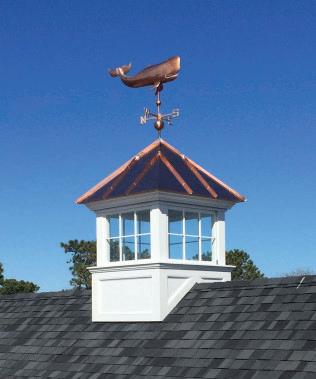





















































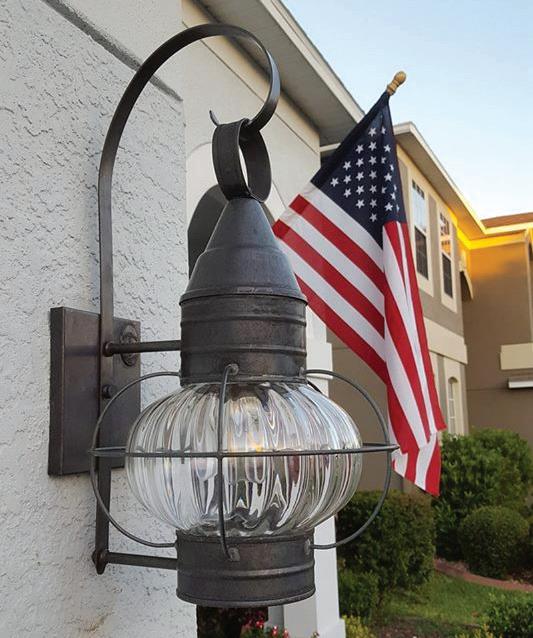
































“Your house for all occasions”

“Your house for all occasions”



“Your house for all occasions”

Candies! For over 50 years we have used only the finest ingredients in our candies—cream, butter, honey, and special blends of chocolates. Call for a FREE brochure. Long famous for quality candies mailed all over the world. Treat yourself or someone special today.
butter, honey, and special blends of chocolates. Call for a FREE brochure. Long famous for quality candies mailed all over the world. Treat yourself or someone special today.
Candies! For over 50 years we have used only the finest ingredients in our candies—cream, butter, honey, and special blends of chocolates. Call for a FREE brochure. Long famous for quality candies mailed all over the world. Treat yourself or someone special today.
Candies! For over 50 years we have used only the finest ingredients in our candies—cream, butter, honey, and special blends of chocolates. Call for a FREE brochure. Long famous for quality candies mailed all over the world. Treat yourself or someone special today.
For a Free Brochure Call: 978-256-4061 Come visit us today!
“Your house for all occasions”
“Your house for all occasions” Come us today!
Candies! For over 50 years we have used only the ingredients in our candies—cream, butter, honey, special blends of chocolates. Call for a FREE brochure. Long famous for quality candies mailed all over Treat yourself or someone special today.
292 Chelmsford Street Chelmsford, MA 01824 For Free Brochure Call: 978-256-4061 Come visit us today!
292 Chelmsford Street Chelmsford, MA 01824 For Free Brochure Call: 978-256-4061
292 Chelmsford Street • Chelmsford, MA 01824 For Free Brochure Call: 978-256-4061 <
292 Chelmsford Street Chelmsford, MA 01824 Visit Our Website: mrsnelsonscandyhouse.com
292 Chelmsford Street • Chelmsford, MA For Free Brochure Call: 978-256-4061
292 Chelmsford Street Chelmsford, MA 01824 For Free Brochure Call: 978-256-4061 < >










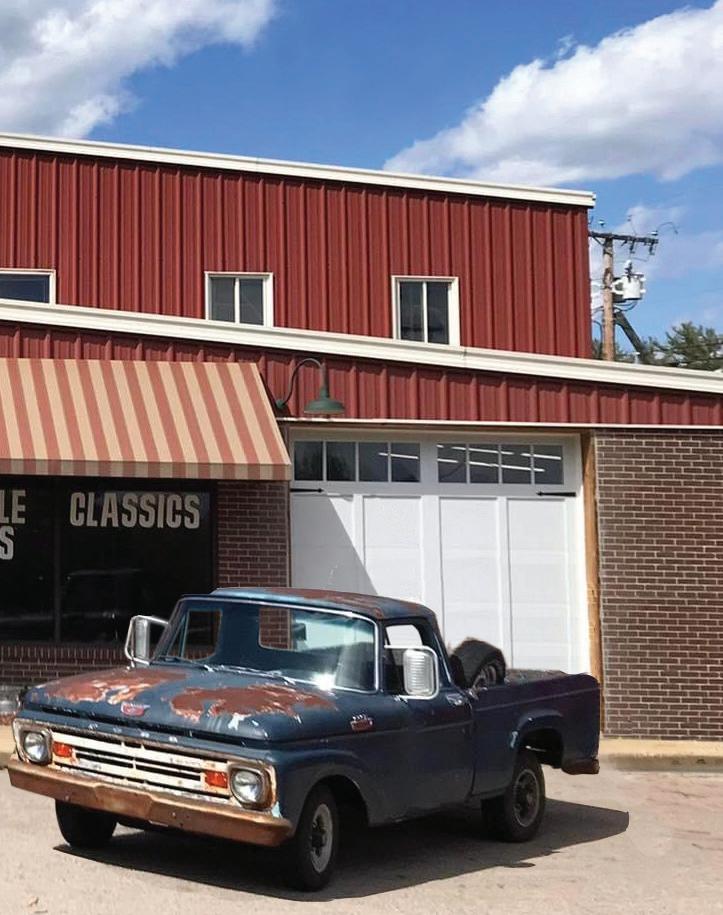
603-465-7270 • RESTORATIONMOTORS.COM







EnergAire continuously puri es up to 4,000 cubic feet (a large room) of air and makes it breathable and invigorating. Restores natural ion balance to unhealthy environments caused by industrial pollution, automobile exhaust, central airconditioning, and heating, smoke, dust, pollen, animal fur. . . removes microscopic pollution particles not removed by any other method of air puri cation. EnergAire was rated Number One for speed of removal of cigarette smoke by the leading U.S. consumer protection magazine. It has no noisy fan, no costly lter, and requires no maintenance. Uses less than 2 watts. 9" high. 3" diameter. Weighs less than 1 pound. $69.95

RODAR is the super-powerful professional ultrasonic pest repeller with up to 60 or more times the power of other devices — and power is what makes RODAR so e ective. RODAR ultrasound equals a jet engine — noise unbearable to pests but at frequencies humans and pets cannot hear. RODAR units are completely safe. RODAR drives pests out and keeps them from getting in. Handsome simulated walnut cabinet 5-5/8" high. Weight 1-1/2 pounds. Uses less than 5 watts. $99.95





Roger’s sculpture covers the gamut from fine art to whimsy including functional garden elements, weathervanes, birdbaths, gates, fountains and more. Given the sculptures unique eclectic qualities, they work in sophisticated to comfortable environments. www.ditarando.com






















• And much more to help you grow the gardens of your dreams! The Gardener’s Handbooks from The Old Farmer’s Almanac are loaded with advice and inspiration to guarantee success for every grower.
• Step-by-step guidance on growing more than 30 vegetables or flowering plants
• Tips for seed-starting
• Advice to minimize maintenance and maximize harvests, color, and fragrance
(Continued from p. 120)
pulled together. Lee was—how to put this nicely?—batshit crazy. He talked incessantly while snacking on cloves of raw garlic that he pressed into chunks of extra-sharp cheddar cheese, and we counted ourselves lucky that he mostly left us to our own devices.
Will often rode his Harley to the job site, and he looked every bit the part: flowing gray beard, fading tattoos and even more faded blue jeans, bandanna knotted around his forehead, tattered work boots. He was a good guy, whose crudeness and rebel-without-a-cause aesthetic seemed like a flimsy cover for something far gentler and more thoughtful. Will was mostly willing to mentor me in the basics, except when he wasn’t, at which times he’d revert to bossing me around and making me the brunt of an enviable library of disparaging jokes that are unfit for the pages of a family magazine such as this one.
I hadn’t thought about most of these men for many years, but this summer I got it in my head that what I needed more than anything else in this world was a shed. My house is on the small side—about 1,100 square feet—and although I have a full basement, my only access to the basement is through the house. This meant that I needed someplace else for all the detritus of my rural life, including but not limited to: one off-road motorcycle (running), one on-road motorcycle (not running), eight truck tires with questionable tread, one lawn mower that I got for free and probably overpaid, the tailgate from my son Fin’s old Tacoma, two five-gallon buckets of undercoating material, one string trimmer, and a random assortment of lumber that I’ll almost certainly move at least a half-dozen more times before I decide I’m never going to use any of it and tuck it into various nooks and crannies around my property.
Now I don’t mind a bit of clutter, particularly when it’s composed of useful items, though I acknowledge the slipperiness of this particular slope, and all the ways in which useful is profoundly subjective. And I suppose that in the
slow accumulation of my own clutter, I saw that slippery slope coming into focus, and I knew I had to act quickly before being swept over the edge.
Truth is, I’m not a great builder. I’ve never had the patience, eye for detail, or problem-solving abilities that are the hallmarks of all the good carpenters I’ve been fortunate enough to learn from. But despite my lack of innate talent— and largely thanks to those mentioned above, along with a few others—I’ve managed to accumulate just enough skill to have built three houses, one barn, and a handful of outbuildings. To be sure, you probably wouldn’t want me to build your house; on the other hand, all of the houses I’ve built are still standing, shortcomings and all.
In many ways, the shed was precisely the sort of building project I relish, lacking all the fussy details that creating a weathertight and well-insulated living space demand. Plus, I’d be able to make use of my random lumber and those old divided-light window sashes I’d been tripping over ever since I retrieved them from a free pile last summer.
As of this writing, the shed is approximately 80 percent complete. The walls are up, the roof is on; all that remains is to sheath the end walls, build frames for those salvaged window sashes, hang the door, and install a loft floor. Given a sufficiently relaxed approach, I should be able to consume the remaining summer and fall months picking away at these final details. Surely I could finish more quickly, but to what end? Even in its unfinished state, my new shed has already averted my looming detritus crisis. For now, anyway, the precipice of that slippery slope has faded into the horizon, though I must remain vigilant, for sheds are infamous for their ability to shrink over the years.
But perhaps most gratifying to me is the awareness that somewhere, deep in the recesses of my middle-aged self, that overconfident, marginally capable teenage boy lives on. Troglodyte Construction may not have been the world’s savviest business move. But in its own modest way, it has somehow managed to endure for nearly four decades. And I’d say that’s a pretty good run.


















Sometimes the most essential thing in your tool kit is the willingness to learn and to try.
ILLUSTRATION BY TOM HAUGOMAT
When I was 16, my friend Trevor and I owned and operated a small residential construction business we called Troglodyte Construction. By “owned and operated,” I mean that we spraypainted “Troglodyte Construction” on the side of the yellow 1971 VW Bug I was driving at the time; by “small residential construction business,” I mean that we mostly puttered around the back roads of central Vermont, each with a farmer-tanned arm resting on the sill of an open window, summer breezes licking at our boyish faces as we intermittently sang along to the Beastie Boys and discussed the possibility that someone would someday hire us to
build something. Which, if I remember correctly, my parents eventually did.
To be fair, even at such a tender age, Trevor already knew the rudiments of sound carpentry. If there was a true troglodyte among us, it was me, for I was in possession of 10 thumbs (perhaps 11) and ignorant of even the most basic tenets of building. But I had the unearned confidence of youth on my side, and this allowed me to envisage myself as capable of addressing any and all of my imaginary clients’ construction needs. Crucially, it also afforded me the assumption that there existed a pent-up demand for hiring a 16-yearold whose favorite album was titled License to Ill. How could I possibly fail?
Rather spectacularly, as it turned out. All the envisaging and assuming in the world proved insufficient in the face of my inexperience, and when Trevor moved on to bigger and better opportunities, Troglodyte Construction faded into even greater obscurity.
Still, my tenure in the building trades wasn’t over. Indeed, I went on to work for a number of legitimate builders. There was Tom, who was extraordinarily kind and gentle—a short, slight, middle-aged man who lived in the woods and wore a beret and was clearly navigating choppy emotional waters. Every so often, he’d disappear for a half hour or so, before returning to the job site with bloodshot eyes. Initially, I assumed he was smoking weed, until he explained that sometimes he just needed to sit in his truck and have a good cry. There was Ken, whose eyes were also bloodshot, though definitely not from crying. Then there was Will, who was foreman of a crew that Lee—a general contractor who specialized in period-correct restorations—had
(Continued on p. 119)







































